BUTTERFLY CONSERVATION IRELAND ANNUAL REPORT 2022
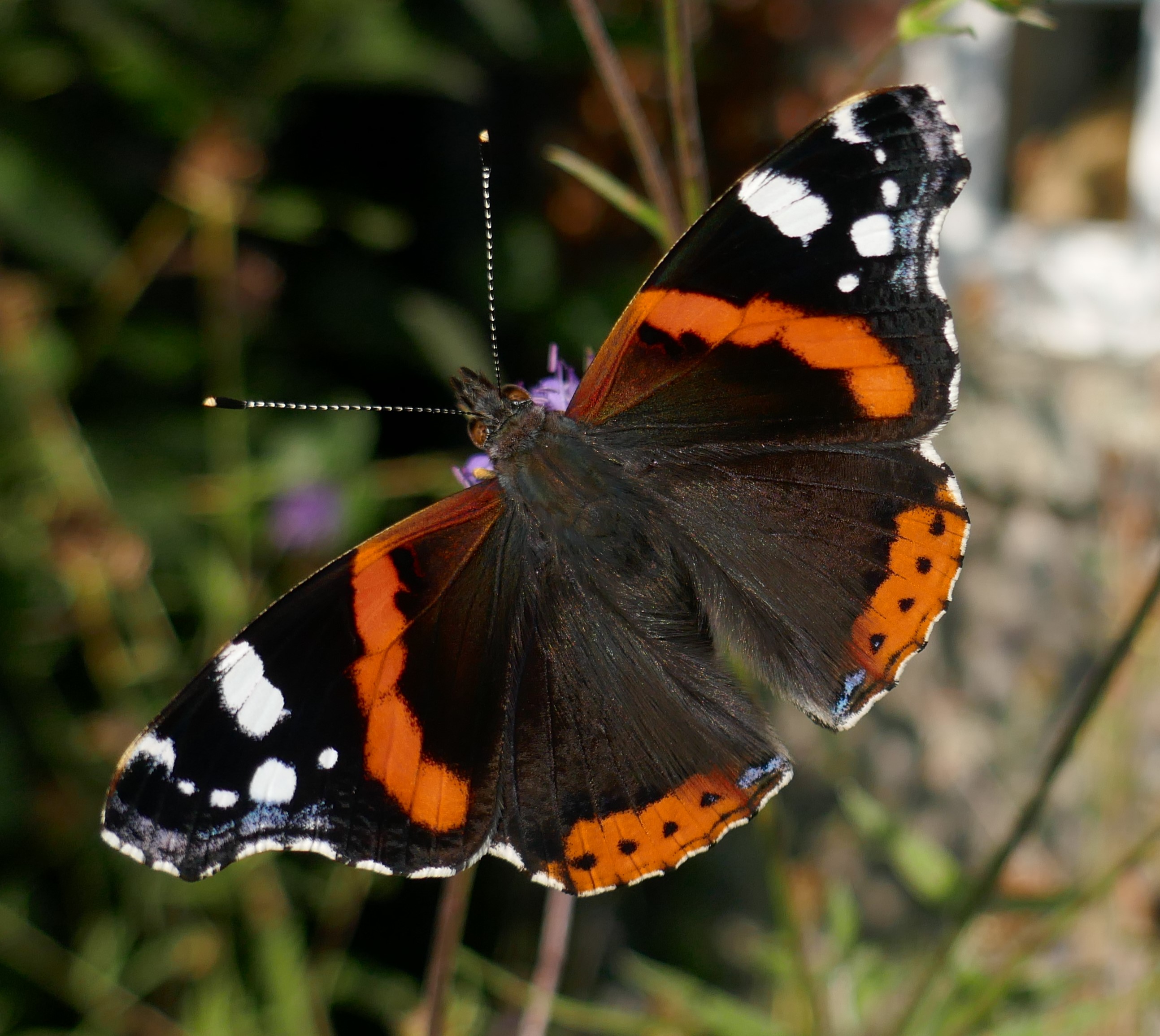 The Red Admiral enjoyed abundance in 2022. Photo © J. Harding
The Red Admiral enjoyed abundance in 2022. Photo © J. Harding
CONTENTS
• Introduction
• All Ireland’s Butterflies in one Year
• Butterfly Season Report: Northern Ireland v Republic of Ireland
• Events Report
• Crabtree Nature Reserve Report
• Conservation News
• Garden Survey Report
• What are the best plants for Pollinators?
• Species Focus: Common Blue
• How Important is The Burren for Ireland’s Moths?
INTRODUCTION
Dear Butterfly Conservation Ireland Member,
Welcome to Butterfly Conservation Ireland’s Annual Report 2022. The year had beautiful mild, dry, sunny weather in March and April while May was mild but often overcast. June saw many overcast days with above average temperatures in the east, below average in the west but July and August had some superb sunny weather, with some record high temperatures and below average rainfall. September was a pleasant, mild month with above average rainfall while October was mild but wet. Given the generally favourable weather in spring and hot, dry weather in summer one might expect our butterfly populations to have shown abundance, but this was generally not observed, except for the Red Admiral especially during autumn and, where it occurs, the Comma. Our reserves performed well thanks to your support and hard work put in by our volunteers and friends. Our small staff are fortunate in having excellent support from our active membership whenever help is needed in these endeavours. Butterfly Conservation Ireland’s membership grew again in 2022, reflecting perhaps the growing concern for the environment and owing to the increased interest in nature that has arisen under the coronavirus pandemic restrictions on movement.
In 2022, with restrictions lifted in spring, people were freer to observe butterflies and other wildlife, adding a much-needed boost to morale and a relief from the remarkable pressure and distress many of us have suffered. Outings and indoor events could again take place, and you can read about these in this report. Your continued practical and financial support is greatly appreciated as we strive to ensure that our butterflies and moths continue to have an important voice for their conservation. We pursue the conservation agenda at every opportunity with many submissions to government bodies concerning our habitats. Our recording scheme continues to provide important quantitative and qualitative data; let’s see if we can maintain this in 2023. Our financial accounts were approved thanks are due to our joint treasurers Michael Jacob and Joseph Harding. Thanks are due to Richella Duggan and Pat Bell for their help in editing this report and to all of our members and supporters. We hope that you enjoy reading our Annual Report and we look forward to hearing from you in 2023.
Yours in nature,
Jesmond Harding (Secretary)
Butterfly Conservation Ireland,
Butterfly House,
Pagestown,
Maynooth,
County Kildare
All Ireland’s Butterfly Species in One Year
One of the challenges I never set myself before the spring of 2022 is to see all of Ireland’s butterfly species in a single year. In 2021, this feat was achieved by Jim Fitzharris, who described his experiences in last year’s annual report.
I had to think about whether this was worth doing, never having been particularly keen about ticking off lists. I also had to consider whether I could sustain my enthusiasm, as I know that I can be prone to commitment fatigue. But how could I justify doing what has been done already? Then I had a thought. I could look for all Ireland’s butterflies, plus the two species that also have subspecies, the Grayling and Dingy Skipper butterflies. These two butterflies exist in two subspecies in Ireland. No one has managed to see these in addition to all the other Irish butterflies, as far as I know. An additional challenge would be to photograph all 35 species plus the two subspecies. Now my quest had a purpose!
There are basically two groups of butterflies in flight period terms; spring and summer butterflies. It took me a while to get off the mark. It was late in March and many recorders had seen butterflies, but not me. Finally, on a sunny day on March 22nd, I saw my first butterfly.
I wasn’t even looking for butterflies when I saw an orange glimmer in the oak wood near the US Ambassador’s residence in Phoenix Park. I looked at where I last saw the gleam of orange, to seek the settled butterfly. My surprise was a male Comma, basking on fallen oak leaves. I didn’t have my camera, so I could not record it for posterity, but at last, I was up and running. Only 36 left to see!
A mere two days later, in a sheltered hedged lane near my home, I scored three of my goals: Small Tortoiseshell, Peacock and Comma, in sunny weather with the temperature a pleasant 16 Celsius. This time I did have my camera and proof of observation was obtained!
The same lane gave me my first Green-veined White, Orange-tip and Speckled Wood of the season, on 19 April with the temperature a mere 12 Celsius. Ten days later I added the Brimstone when 13 Brimstones were seen at Lullybeg, but again it was just 12 Celsius.
On 4 May I found a Small Copper in a field near my home. It was the smallest Small Copper I ever saw, barely the size of a female Small Blue. Big or small, I now had eight species.
On 7 May I added three more, the Small White, Large White and the lovely Holly Blue, all in that hedged lane near my home. Spring butterflies often seek such spots as lanes because they find shelter and warmth vital in spring when air temperatures can be very low. Now in double figures, I still needed the Dingy Skipper, another spring species that is highly localised meaning its known haunts must be searched to reveal it.
I found it the next day, in Butterfly Conservation Ireland’s reserve at Lullybeg when I counted no fewer than 11, a great total for this scarce butterfly. While you can never call it glamorous, it has charm and beauty despite being grey and brown. It is thick-headed and looks rather like a teddy bear. The intricate embroidery of its hazy grey and earthy brown is quite intriguing to observe, a masterly interplay no carpet maker would be ashamed to emulate.
But I had to remind myself that I had found only one of the two Dingy Skipper forms that occur in Ireland. I would have to travel around 140 km to find the Burren form, subspecies baynesi.
Before this, I added, on 15 May, the Marsh Fritillary (which began its flight early in 2022) and the Cryptic Wood White, at Lullybeg. This lazy-looking, floppy flyer is identical in appearance to its nearest Irish relative, the Wood White, another species I needed to go to the Burren to see. The Pearl-bordered Fritillary occurs only in the Burren and flies only in spring and early in June. A lot depended on my Burren trip planned for 21 May. The weather had to cooperate.
Added pressure on the Burren trip was that I was leading an outing for Butterfly Conservation Ireland there, holding out the promise of seeing the Dingy Skipper, Wood White, and Pearl-bordered Fritillary, among others. The 20 May was dull, overcast and cold.
The day of the event, 21 May, was dull, cold and windy. I had to improvise, taking folk through the habitats and showing them places the butterflies could be found, if the sun was shining on us. Suddenly, near the very end of the walk, watery sunshine seeped through a cloud gap, and magically all three species appeared. What a relief. Everyone was pleased, and I was very relieved that I could show people some of our most special species. Plus, I had added three more to the quest list, now at 18.
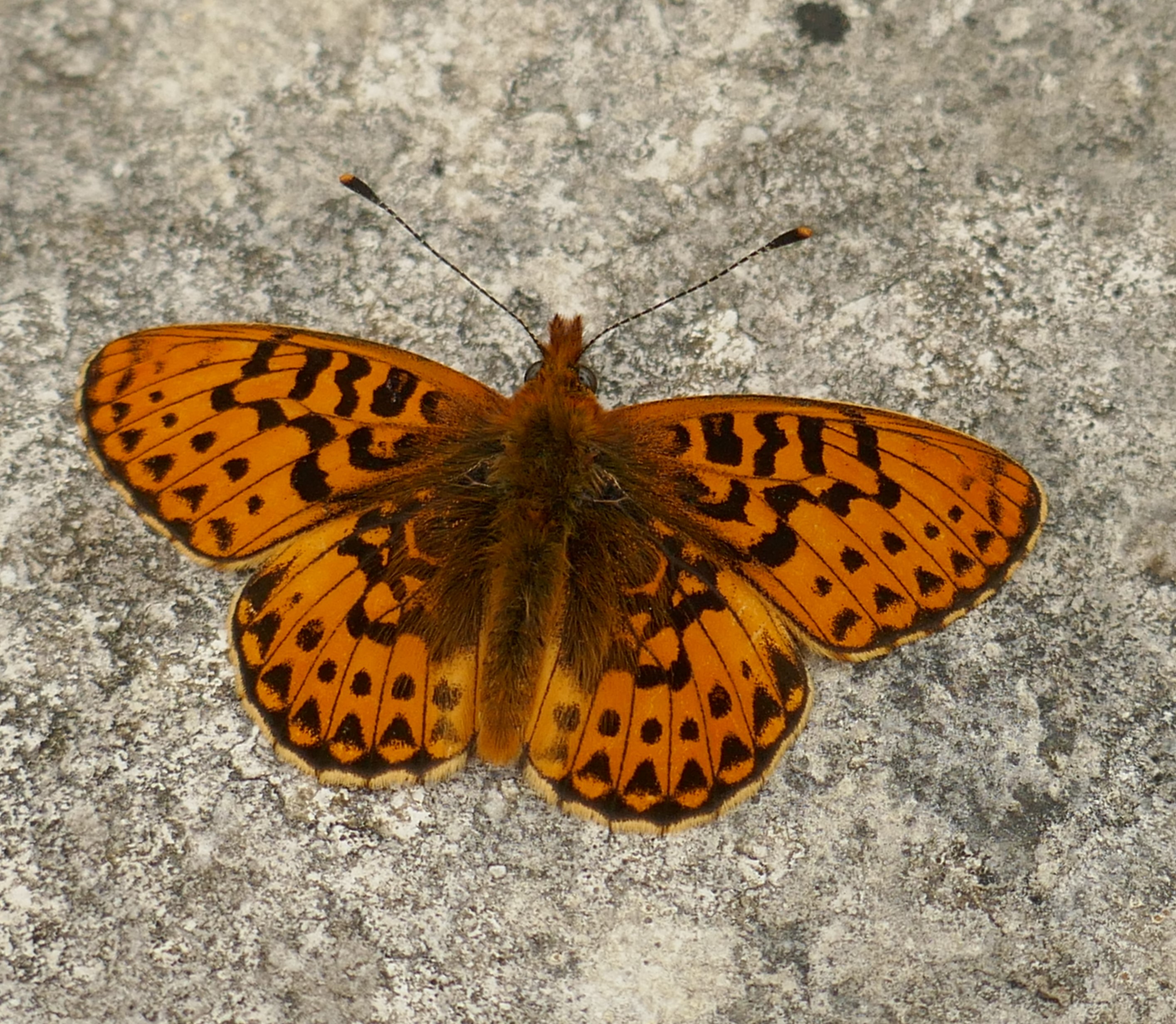 Male Pearl-bordered Fritillary, Fahee North, May 2022.
Male Pearl-bordered Fritillary, Fahee North, May 2022.
Raheen, County Limerick, gave me my first Common Blues, 32 of them. Small Blue and Small Heath were added by a visit to the east coast, at Mornington, County Meath. It was going well. Nineteen species and one subspecies had been totalled, but the journeying from east to west and southwest was taking its toll. I was tired, but I had to persevere. Butterflies don’t wait for you to visit. Most of our butterflies have just a single generation each year so when they are finished for the year, that’s it.
The Green Hairstreak flies only in bogs in my region, so I had to stir myself to find the species. I knew exactly where to look, it was not that, it was the dispiritingly bad weather in June that was clouding my enthusiasm and threatening my quest.
But I grabbed the chance on 8 June to head for Timahoe Bog and happily, after trying to rouse one from trees and bushes, one darted angrily out but eventually settled on a buttercup, alarmingly close to a butterfly assassin, the spider Misumena vatia. Luckily, the butterfly perched on the far side of the flower and given the spider’s poor vision, the butterfly went unmolested. Obligingly, the butterfly dropped down to a White Clover flower, where I took perhaps the best photo I ever took of this emerald delight. You can see the photo below. I hope you agree.
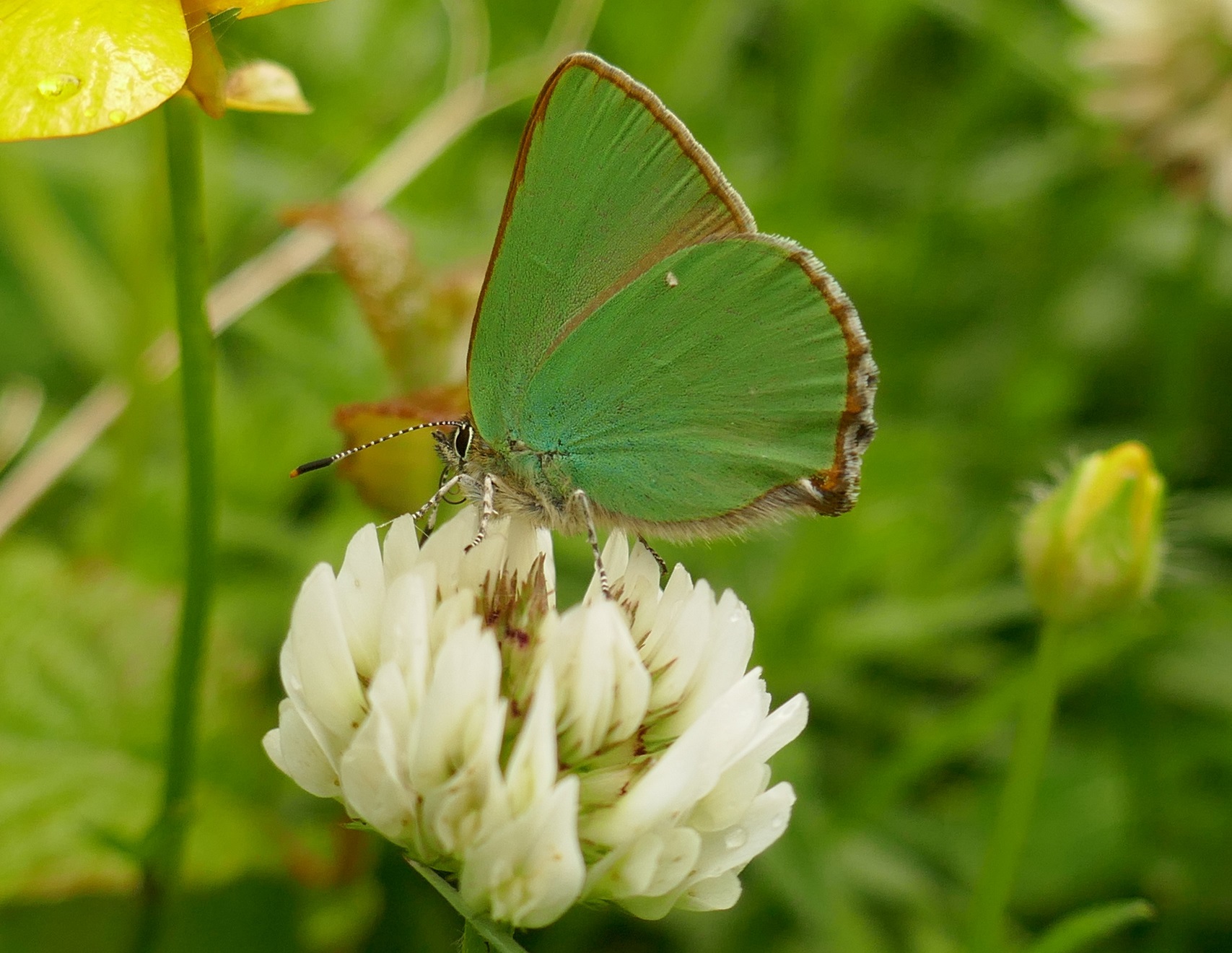 Green Hairstreak, Timahoe Bog, Co. Kildare.
Green Hairstreak, Timahoe Bog, Co. Kildare.
On June 14 I saw a male Meadow Brown in my garden, which made my life very easy. Two days later I added the Ringlet, this time in Lullybeg. On June 15 I saw my first Large Heaths, on Lodge Bog, County Kildare, being blown about on the breeze. June 19 gave me my first Purple Hairstreak, a female bred from eggs I collected in Phoenix Park on 22 March. On July 8 I recorded a beautiful Dark Green Fritillary, again in Lullybeg. I counted 351 Ringlets there on that same day!
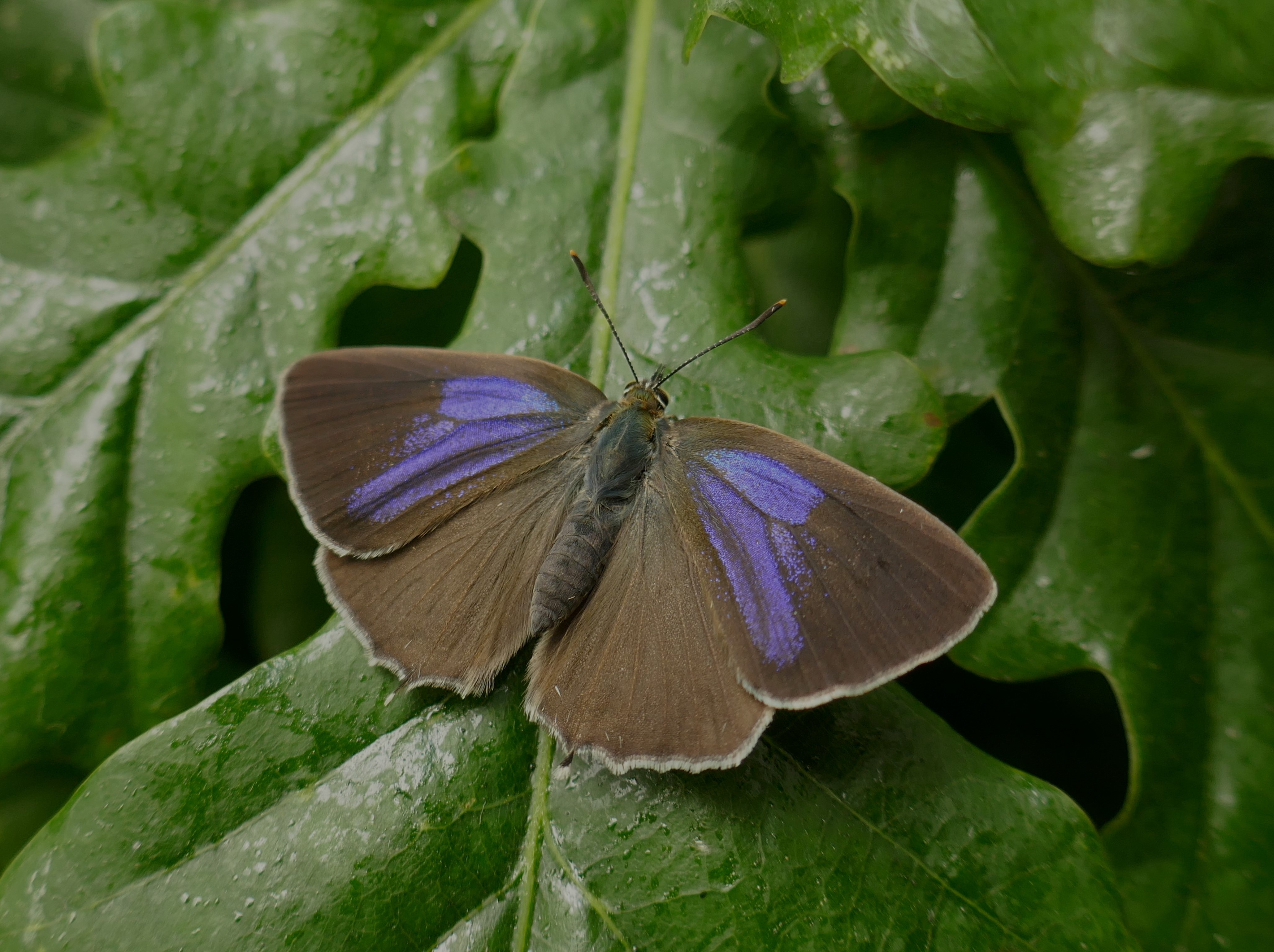 Purple Hairstreak, female, on oak.
Purple Hairstreak, female, on oak.
I must now return to June. I travelled to Malta with my mother, where we spent two weeks in heat that regularly peaked in the mid-30s Celsius each day. Accuse me of cheating if you will, but I added the Clouded Yellow, seen on Gozo, the second largest island in the Maltese archipelago, to my list. The Clouded Yellow is a migrant that visits Ireland every year but in very low numbers. One year in every 25 will see large numbers, but we have not had such a year since 2002. I managed to see two extra species that have been seen in Ireland very rarely: the Eastern Bath White and Common Swallowtail.
These are not considered among our 35 species for these are rare visitors, but it was nice to add these to the butterflies I saw in 2022.
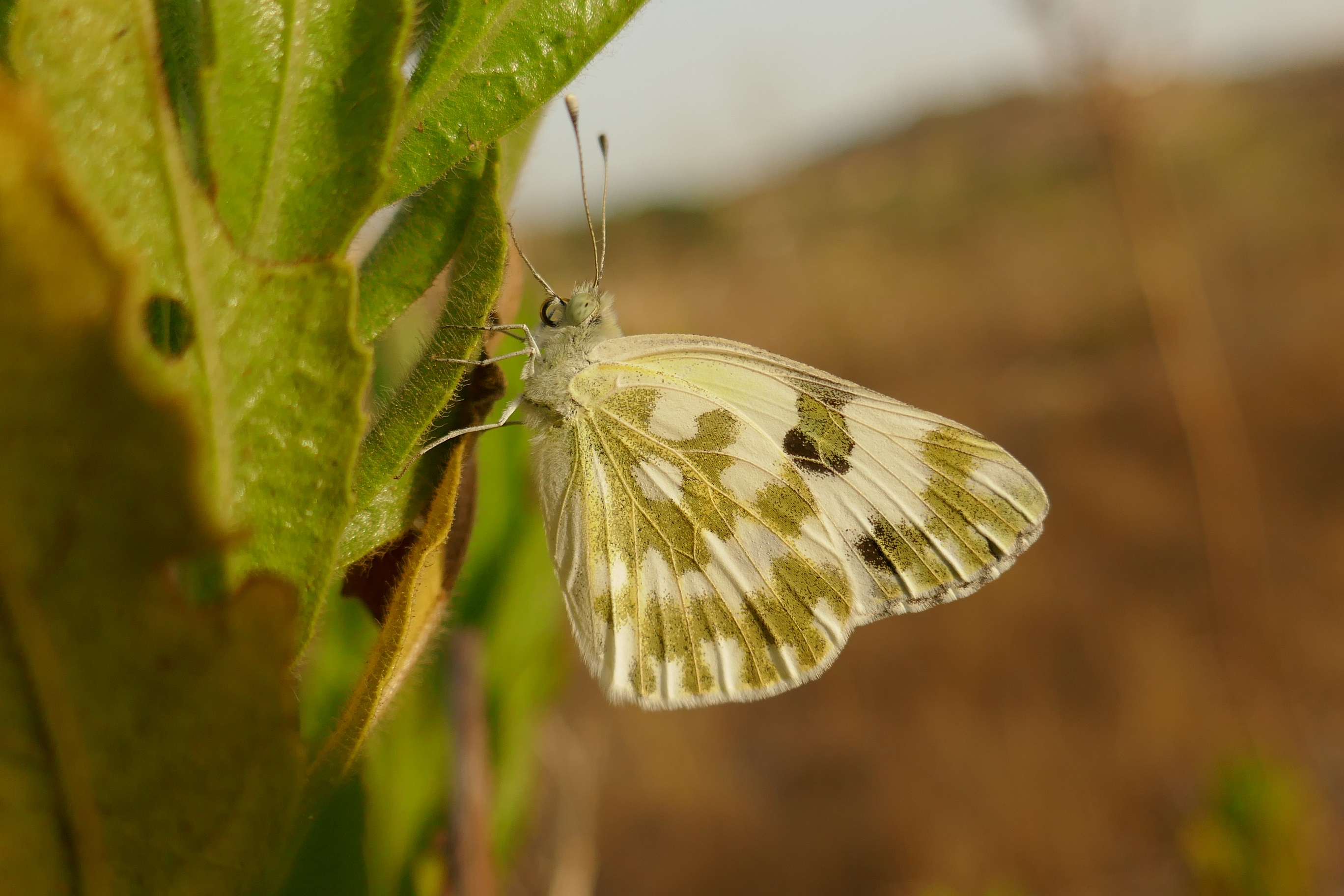 Eastern Bath White, Gozo.
Eastern Bath White, Gozo.
Back in rainy Ireland, Small Skipper (10 July) and Essex Skipper (16 July) were totalled, both on cutaway bog in the Timahoe area, Kildare. The weather was warming nicely, with sustained hot conditions making for easy butterflying. A worry I had was finding the Hedge Brown, annoyingly known by most people nowadays by the name Gatekeeper. Poetic though the name is, it is not as descriptive of this attractive butterfly’s identify, colour and haunts as Hedge Brown. My concern arose from the diminishing numbers being returned over the past decade from what is perhaps its last remaining colony on Ireland’s east coast at Ravenwood, County Wexford. Would it still be there?
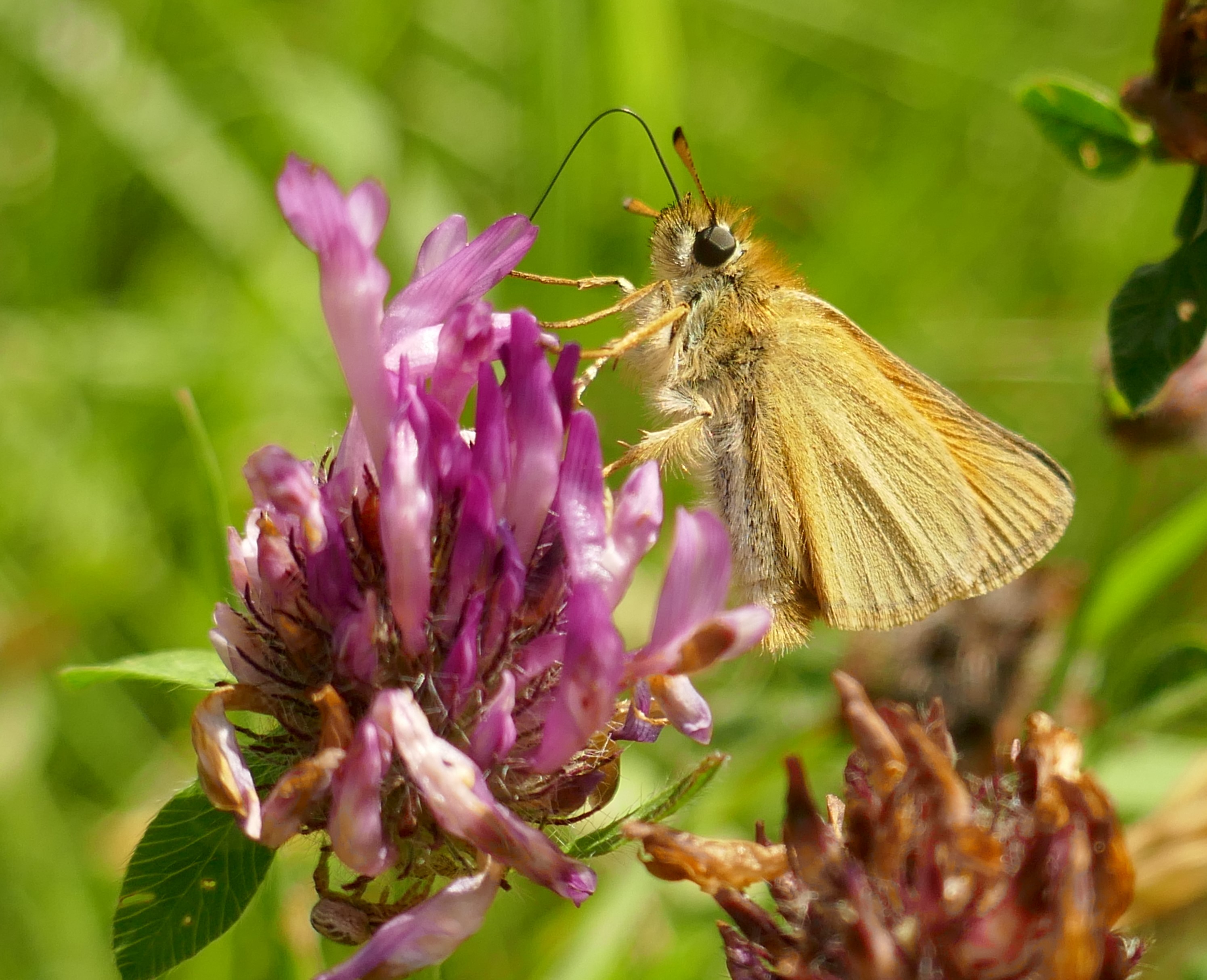 Essex Skipper, Timahoe, County Kildare.
Essex Skipper, Timahoe, County Kildare.
I drove south from Meath early on the morning of 18 July, in rapidly building heat. It was beginning to feel like Malta. When I got to the car park outside Ravenwood, I was amazed to find the ground was wet. Surreally, it rained from a clear blue sky. It was that kind of summer…
I entered the large clearing that used to hold good numbers of Hedge Brown. I found none, but I did see a Red Admiral, another tick! But I was concerned. Was the Hedge Brown now extinct on Ireland’s east coast? In the 1960s and perhaps later, there are records from Dublin, Wicklow and Wexford north of Ravenwood, but these are no longer found in these areas.
Moving through the wooded dunes to less shaded but still wooded ground closer to the open sand dunes, I finally found one, then two, then more, and when I walked the full length of the wood, I had counted 82 Hedge Browns. I felt relieved, not just for my quest’s progress, but for the butterfly’s survival here. This is not assured, though. There is a proposal to clear fell the pines on the dunes which would wipe out this butterfly, so my advice about this has been forwarded to the ecologists studying the proposal. Let’s hope that sense prevails.
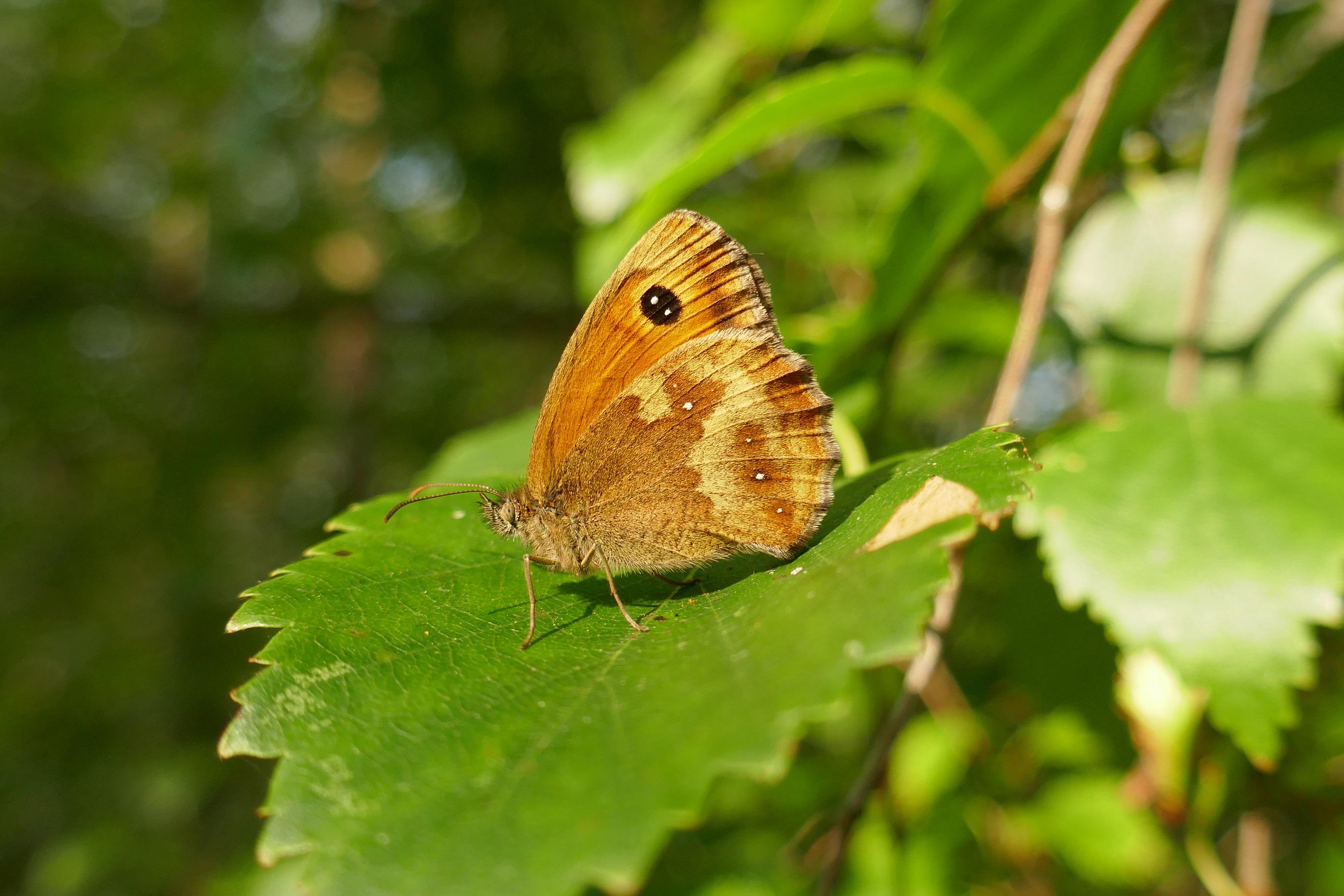 Hedge Brown, female, in Ravenwood, Co. Wexford.
Hedge Brown, female, in Ravenwood, Co. Wexford.
Silver-washed Fritillary made it onto my list at Ravenwood too, another species that must have woodland to survive. I saw females laying eggs on pine trees, while Red Admirals fed on sap bleeds on the pines. On my way home I dropped into Old Bawn, the dunes south of Cahore, where I added Grayling, the hibernica subspecies. It fled the heat to take cover, so hot was it by now. My journey home was made with all the windows open, and it was sweltering, nonetheless. I needed a rest.
On 6 August I found myself in the Burren, County Clare, seeking four more butterflies that would complete my quest. The heat from July was rebuilding in August so I had high hopes of my quarry. To my delight, the one species I feared missing was found.
The highly localised Brown Hairstreak was found, a beautiful, silky, downy female, freshly hatched. Three Graylings, subspecies clarensis, the form that shows a paler grey underside to match the bright grey Burren limestone, was added, in a low-lying area of the Burren National Park. Climbing the Burren’s iconic Mullaghmore ‘Mountain’ the following day, a Painted Lady (and at least 40 more Graylings) made the list.
Sadly, the Wall Brown still eluded me. Why is this butterfly, once widespread, now so scarce? I did see three, along the Ballyvaughan Loop Walk near Ailwee, in County Clare on 7 August, the day Manchester United lost at home to Brighton, occasioning unseasonable gloom amidst glorious sunshine.
But relief too, for I found and photographed all 35 butterflies that occur in Ireland plus two subspecies that occur only in the Burren. My quest did ask plenty of me, requiring long journeys to areas to find the more distant species but at least I can say I saw them all in one year. Autumn still awaited, and its abiding memory is the Red Admiral and Comma boom which made for a colourful, memorable finale to the 2022 butterfly season.
Butterfly Populations on the Island of Ireland: Northern Ireland v Republic of Ireland
In October 2022 Butterfly Conservation UK released the following press statement about the populations of Northern Ireland’s butterflies as recorded during the Big Butterfly Count held in July and August. This article reproduces the press release and makes comparative comments concerning the state of populations in the Republic of Ireland in 2022.
Big Butterfly Count saw some species flourish in Northern Ireland this summer, but numbers are still worryingly low
Results of this year’s Big Butterfly Count revealed
Ringlet takes top spot.
Peacock and Red Admiral buck UK trend and show a welcome increase in numbers.
Good news for the blues, with increases for Common Blue and Holly Blue
Worryingly, overall numbers of butterflies remain low.
Wildlife charity Butterfly Conservation has released data on the number of butterflies and some day-flying moths recorded in Northern Ireland during this year’s Big Butterfly Count, which ran from 15th July – 7th August.
The Ringlet was the most spotted butterfly in Northern Ireland during the Big Butterfly Count this year. This species showed an increase of 147% compared with last year, which is very different to the overall UK trend, and might be explained by this year’s flight period of this butterfly in Northern Ireland coinciding with the Big Butterfly Count dates.
Peacock and Red Admiral also seem to have fared better in Northern Ireland than they have done in the UK overall. This is welcome news as both of these species did poorly in Northern Ireland in the Big Butterfly Count 2021.
It was good news for the blues as well – with both the Holly Blue and the Common Blue species faring well in the 2022 Big Butterfly Count. The Holly Blue is a species that is spreading across Northern Ireland, and this year showed an increase of 184% compared to 2021 numbers.
However, overall, the trend for butterflies across Northern Ireland remains a concerning one, with the results of the Big Butterfly Count 2022 showing an average of fewer than nine butterflies seen per Count. While this is an increase on last year, it still remains low compared with many previous years in the 13-year history of the citizen science project.
Head of Science for Butterfly Conservation, Dr Richard Fox, said: “We might have expected this summer to have been a better one for butterflies given warmer and drier weather in Northern Ireland. The fact that more butterflies weren’t seen is concerning and it’s clear that much more needs to be done to protect and restore habitats to aid nature recovery. The sun could shine for days on end, but we still won’t see more butterflies unless there is habitat for them to thrive in.”
A total of 1,257 Butterfly Counts were carried out in Northern Ireland during the event while, across the UK as a whole, participants spent a combined total of over two and a half years counting butterflies in their gardens, local parks and in the countryside.
Dr Zoë Randle, Senior Surveys Officer at Butterfly Conservation, said: “The vast majority of Big Butterfly Counts are done in gardens, which makes this data especially valuable because this type of habitat is under-represented in many of our other schemes.
“Gardens that are wildlife friendly can provide vital habitat for these butterflies and moths, allowing them space to feed, breed and shelter.”
The Big Butterfly Count is the largest citizen-science project of its kind and relies on volunteers spending 15 minutes outside each summer, counting the number and type of butterflies they see. Taking part each year helps scientists to gather important data on how butterflies and moths are coping with changing climate, changing weather, and habitat loss. Next year’s Big Butterfly Count will take place from Friday 14th July – Sunday 6th August 2023.
To find out more visit www.butterfly-conservation.org
THE BUTTERFLY WINNERS AND LOSERS OF SUMMER 2022
Species results in NORTHERN IRELAND – Big Butterfly Count 2022
| Big Butterfly Count 2022
Northern Ireland |
Abundance | Ave per count | % change from 2021 | |
| 1 | Ringlet | 1,570 | 1.52 | 147% |
| 2 | Six-spot Burnet | 1,290 | 1.17 | 183% |
| 3 | Small White | 1,040 | 1.01 | -28% |
| 4 | Meadow Brown | 1,003 | 0.97 | 136% |
| 5 | Small Tortoiseshell | 814 | 0.79 | 112% |
| 6 | Large White | 648 | 0.63 | -49% |
| 7 | Speckled Wood | 619 | 0.60 | 79% |
| 8 | Red Admiral | 605 | 0.59 | 302% |
| 9 | Green-veined White | 552 | 0.54 | -3% |
| 10 | Peacock | 377 | 0.37 | 222% |
| 11 | Common Blue | 140 | 0.14 | 5% |
| 12 | Small Copper | 93 | 0.09 | -6% |
| 13 | Painted Lady | 83 | 0.08 | 37% |
| 14 | Holly Blue | 60 | 0.06 | 184% |
| 15 | Silver Y | 13 | 0.01 | -46% |
| TOTAL | 8,826 | 8.56 | 44% |
End of NI Press Release
The Republic of Ireland
The past year saw winners and losers among the butterflies in the Republic of Ireland. Butterfly populations do not fluctuate on either side of an equilibrium but can rise and fall quite dramatically. The most important constraint on butterfly abundance is resource availability, although factors beyond direct human control such as weather and climate play important roles. Given the central importance of resources, habitat quality and changes in the quality and extent play major roles. This is the factor that is most important when looking at long-term population changes. Inter-annual changes are more likely linked with weather conditions and the state of the relationship between a host species and key predators, such as parasitic wasps.
A couple of features of the NI figures strike me as quite different from the abundance of butterflies in the Republic of Ireland. The Peacock showed a 222% increase in NI in 2022 on the 2021 figures, while apart from Donegal, the records received by Butterfly Conservation Ireland show that the drop in Peacock abundance in the Republic of Ireland during 2021 continued, and even deepened in 2022. I spent a week in the Burren in early August this year and saw one Peacock, while the 35 sets of records received from the Burren region in 2022 reported a total of six Peacock butterflies. This is bizarrely low for a butterfly that routinely produces large populations. One day in August 2019, for example, I counted 167 Peacocks in Lullymore/Lullybeg, County Kildare. In other areas of Kildare and Meath that are known for the high Peacock abundance, the counts for 2022 were also very depressed.
Explaining this population difference between north and south in the absence of any evidence as to cause is not possible but there might be a parasite that afflicts the species which is less common or even absent in cooler northern areas or that the parasite has less impact on the population in the north of Ireland because the Peacock breeds later there than it does further south, or breeds in more sheltered areas not favoured by the parasite.
The habitats in areas known to me where the Peacock butterfly is traditionally abundant remain unchanged making it likely that a parasite has caused a crash. This is not a cause for complacency; climate change may see new parasites entering the country to reduce our population.
Another feature of difference is that the NI figures leave the Comma butterfly out. This colonising species, first confirmed breeding in Ireland in Carlow in May 2014, is thriving in parts of the Republic of Ireland, and just this year has established itself as a staple of my butterfly experience locally in south Meath, 3 ½ miles north of Maynooth. The butterfly is expanding north and west from its initial landfall area in the southeast and although there are a small number of sightings in NI breeding has not been recorded there or in much of the west and north-west of the Republic of Ireland. But look out for it in these areas in the coming years!
Most of the figures for rises and falls in NI appear to be in line with our species’ fortunes ‘down south.’ For example, the Red Admiral, up 302% in NI in 2022, was very abundant in the Republic of Ireland too, much more so than in 2021.
The Holly Blue, up 184% in NI on last year, is showing a liking for our warming climate-it is now managing to fit in two generations a year in most places in the Republic of Ireland, and in southern areas, like Blackrock in Cork, and mild coastal, urban areas of Dublin, it is producing three broods per year. No wonder its abundance is up, but beware; its parasites are increasing with it and will eventually precipitate a population crash. Following this, it will rise again, for a boom-and-bust cycle is a well-known characteristic of this lovely butterfly’s demographics.
Northern Ireland has 27 species of butterfly compared with 35 species in the Republic of Ireland. Northern Ireland lacks the Wood White and Brimstone (the latter is considered extinct since the 1980s), the Small Skipper and Essex Skipper, Brown Hairstreak, Pearl-bordered Fritillary, Wall Brown (now doubtfully present, last seen in its only reliable location in 2015) and Hedge Brown. Some absences are due to climatic reasons, others are due to the absence of suitable habitat.
With the climate warming, perhaps the Brimstone might recolonise its former territory in the Lough Erne basin in County Fermanagh. The same troubles are affecting butterflies in Northern Ireland, with habitat loss as the greatest threat. Similarly, the warming climate is affecting population features like distribution and brood structure, with the Holly Blue showing itself further north, and producing two generations in areas where it used to produce just one. In July, it was even recorded on Rathlin Island off the north Antrim coast.
A final point to consider is that Ireland is an island and butterfly populations on islands often develop distinct characteristics to help them adapt to the distinct ecology of island life. The uniqueness also makes our butterflies stand out from continental populations, so it is even more important to defend our species. Extinction on an island is final for most species, as most of the butterfly species we have are non-migratory and unlikely to be replaced by external populations, and even if favourable conditions are restored, continental individuals may lack the traits needed for survival here.
If you want to know more about Northern Ireland’s butterflies, watch the video here
https://mail.google.com/mail/u/0/#inbox/FMfcgzGrbcGcZjbswXfCLpsQkJwgCMxK?projector=1
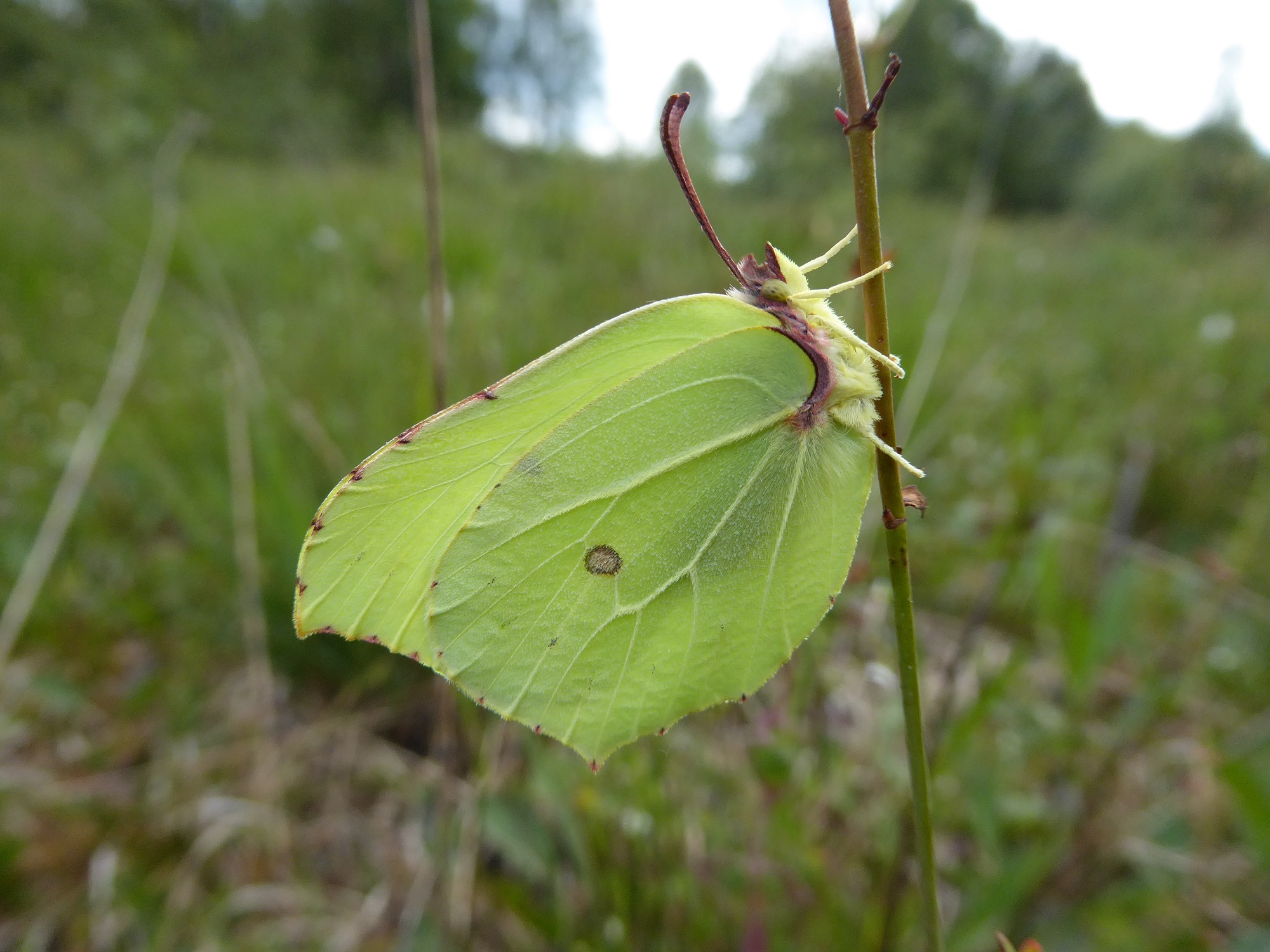 The Brimstone is now extinct in Northern Ireland. It has not returned, despite the warming climate. Photo J. Harding
The Brimstone is now extinct in Northern Ireland. It has not returned, despite the warming climate. Photo J. Harding
Events Report 2022
Lullybeg Management Day 26th February
After two weather-related postponements, we finally met at Lullybeg to work on a section of the southern section of the reserve. It was a grey-skied day suitably supported by a stiff chilling breeze but our work site provided shelter from its effects.
We choose an area that contains Common Dog-violet, Devil’s-bit Scabious, Purple Moor-grass, and various mosses. The area is used by the Dark Green Fritillary and Marsh Fritillary for breeding, and we caught our first sighting of Marsh Fritillary larvae this year, on a scabious leaf that faces south. This gave our work added impetus because birch saplings were working their way into this breeding area.
We uprooted hundreds of birch saplings and some young willow, carefully replanting any herbs disturbed by our work. There is something strangely satisfying, even during winter, at seeing the pile of saplings rise and the grassland become free of shading scrub.
We took a break for lunch, sheltering near our vehicles and catching up with each other’s news. Our prandial discourse was enlivened by a fierce altercation between two large mink, squealing and scrapping in the tall grasses. One ran out of cover so we got a full view of this beautiful yet invasive and destructive predator.
We resumed our work and cleared the work zone. We look forward to seeing how our butterflies respond in the coming months.
Thanks to all those who attended and to all our members and supporters.
Fahee North Butterfly Walk May 21, 2022
It seems wrong to start an event report with an ugly image of wanton ecological vandalism, but this scene pictured below, close to the Burren limestone near Gort, underscores in stark reality the brutality being meted out to our country, Europe and the planet. A more savage scene, of bulldozed limestone pavement near the Burren College of Art dragged my mood to a darker place. According to the Natural History Museum in London, out of all EU countries (including the UK) only Malta is worse in terms of biodiversity loss than Ireland.
This puts Ireland in the bottom 10% of countries globally in terms of biodiversity intactness. We have no natural habitats left, and our semi-natural habitats continue to suffer an onslaught. The greatest reason for biodiversity loss in Ireland is the change in land use, mostly for agriculture. Other drivers include climate change, pollution and invasive non-native species. The issues shown in this photograph are land-use change and pollution (increased carbon emissions).
The Butterfly walk at Fahee North just north of the Burren Perfumery was eagerly anticipated. The walk, in outstanding and varied habitat in late spring, promised to yield so many species, including several rarities. But the weather was against us. Despite the forecast of sunny spells, it rained for much of the walk, although not heavily, which meant we saw no butterflies on the grassy area adjoining the road.
The habitat ingredients are all there and brightened by Early Purple Orchids. Added to this the site is managed for nature, with extensive cattle grazing and scrub control applied. But butterflies, especially spring species, are fussy about weather, and stubbornly remain out of sight during rain. Higher air temperatures in summer allow butterflies, notably the Dark Green Fritillary, Meadow Brown and Ringlet to fly in light rain, but in May butterflies refuse to do that.
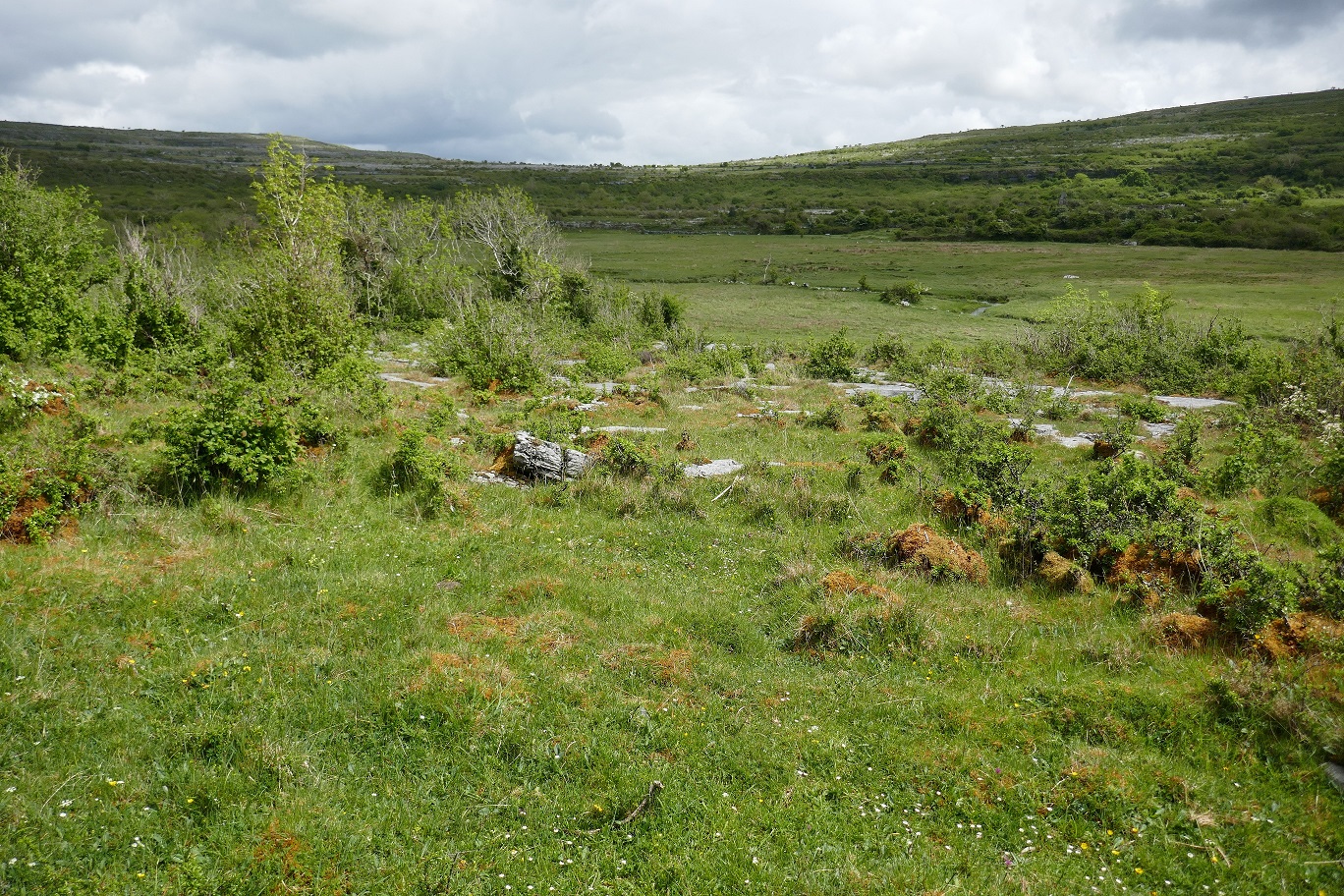 View of Fahee North, County Clare, looking west from the Burren Perfumery. Idyllic vistas like this are declining in number, and many that are pictured require clever camera orientation to conceal habitat loss.
View of Fahee North, County Clare, looking west from the Burren Perfumery. Idyllic vistas like this are declining in number, and many that are pictured require clever camera orientation to conceal habitat loss.
We looked at various habitat features that favour butterflies, and we found Orange-tip eggs on Cuckoo Flower (we glimpsed a Cuckoo too!) growing at the edge of a stream, typically one egg per flowerhead.
We entered the limestone pavement (shattered type with some larger pavement) immediately west of the grassland and it was very interesting to note the change in temperature-the heat rising from the limestone juxtaposed with the cooler adjoining wet grassland. The cloud was thinning and finally, a Dingy Skipper darted into view. Everyone was impressed with this characterful butterfly, and we compared him with a male Common Heath moth, with both looking superficially similar on the wing.
I kept promising that any sun would yield a Pearl-bordered Fritillary, and flashes of yellow were reported, but no fritillary was confirmed.
Finally, there she was, in a really sheltered opening, fluttering low before alighting on a slab of warming stone. Netted and jarred, she was shown to her admirers. A major ‘tick’ for many in our band, some coming from Dublin to see their first Pearl-bordered Fritillary.
Then a snow-white female Wood White appeared, powdered white like an aristocratic lady from a Jane Austen novel. Her delicate, ponderous flight, and graceful slow motion, earned her praise.
Then a Dew Moth was caught and shown, its lovely deep yellow marked with black dots imbuing it with a taste of the exotic, and exotic it is, because this is a rare species in Ireland although happily not currently regarded as under threat, unlike the Pearl-bordered Fritillary, rated Endangered or the Near Threatened Wood White.
Abruptly, the walk ended as many of those attending were on their way to another walk elsewhere as part of the Burren in Bloom Festival. But everyone left happy, as the weather gave us just a glimpse of the glories of the Burren.
Glories like the butterflies and habitats shown in this post must be treasured. Beautiful, rare butterflies like the Pearl-bordered Fritillary cling onto their limestone habitats and are not found elsewhere in Ireland. Once destroyed, the habitat and butterfly are gone forever.
Our count of enchanted objects must diminish no further.
Thanks to all who attended the walk, and a special thanks to Pranjali from the Burrenbeo Trust, who helped to organize this event, a collaboration between Butterfly Conservation Ireland and Burrenbeo Trust.
Event Report Walk on Lullybeg Reserve 28th May 2022
The forecast of dry, sunny weather proved correct, and we had near-ideal conditions. We picked our way from the parking area at Lullymore West, turned south at the end of the track, and then west to Butterfly Conservation Ireland’s reserve at Lullybeg.
The event was well supported, and we had plenty of sharp-eyed observers to spot nature’s gems, such as an Eyed Ladybird, Azure Damselflies, Hairy Dragonflies, and a newly hatched Buff-tip moth, all on the track that borders the Irish Peatland Conservation Council reserve at Lullymore.
The track runs east-west and the vegetation bordering the wood edge that shelters the track from the north faces south, providing ideal temperatures for viewing invertebrates from April to October. The track consists of calcareous material, adding another dimension to the plant and invertebrate suite. The ecotone, the transitional zone between two or more habitats, in this case between woodland and grassland, also adds to the riches one enjoys along this track.
The wet grassland and poor fen with scattered scrub that awaits at the end of the track is the perfect habitat for butterflies and moths that find the resources they need here, and we quickly spotted Marsh Fritillaries dashing after each other, males spiralling in tightening circles as they battled for the right to their patch but in mitigation, Marsh Fritillaries are much less jealous of their domain than Small Coppers or Speckled Woods.
So abundant are they in the general area this year that we encountered them continually from the track end to the reserve for over a kilometre. The corridor linking Lullymore and Lullybeg is notable for its wet and dry heath, and its ample supply of our two native buckthorns, now holding Brimstone eggs and caterpillars.
Caterpillars of various stages were spotted, occupying their classic linear posting along the leaf mid-rib, raising the upper part of their body off the surface at our merest touch. Faded and worn adults still flapped fragilely around the plants, still depositing their eggs.
The reserve has seen significant management applied during the winter, so we were eager to see the results. We were pleased to see large clumps of unshaded and partly shaded Common Dog-violet, so we hope to see Dark Green Fritillaries flying on the reserve in late June. Dingy Skipper, Small Copper and Narrow-bordered Bee Hawkmoths were spotted, the latter sitting for numerous photographs. This bee mimic never fails to amaze butterfly lovers, and for good reasons. You have to see it to believe it!
The northern side yielded more individuals of the species encountered on the southern section, along with Common Blue, Burnet Companion, in plenty, and Mother Shipton moths.
By the time we retraced our steps, 11 butterfly species had been totted up, including a Green Hairstreak at the parking spot, a nice way to close our event.
A special thanks to everyone for sharing your company, kindness, knowledge, and joy and for making the day special.
Butterfly list: Dingy Skipper, Brimstone, Large White, Small White, Green-veined White, Small Copper, Green Hairstreak, Common Blue, Marsh Fritillary, Speckled Wood, Small Heath.
The habitat ingredients are all there and brightened by Early Purple Orchids. Added to this the site is managed for nature, with extensive cattle grazing and scrub control applied. But butterflies, especially spring species, are fussy about weather, and stubbornly remain out of sight during rain. Higher air temperatures in summer allow butterflies, notably the Dark Green Fritillary, Meadow Brown and Ringlet to fly in light rain, but in May butterflies refuse to do that.
Event Report Moth Morning at Umeras June 4th 2022
Preparation for the moth morning on Saturday June 4th began months ago, when we did some preliminary trapping on Eddie and Denise Smyth’s farm which lies just south of the Grand Canal near Umeras Bridge, in County Kildare. Results showed what we expected; an abundance and range of moths in rich habitats. The farm contains scrub, species-rich wet grassland, tree lines, and a garden with flower beds and borders. The traps were set on Friday, and we noted the sky was clear, not a great sign for moth activity unless it is very warm. The morning was cool with a breeze that was not strong but certainly with a bite. On the plus side, the traps were set in sheltered spots so we had our hopes. Our moth enthusiasts were led by Philip Strickland, BCI’s moth specialist. We carefully inspected the area around the trap for moths that settled close by, a habit of some species attracted by light but only occasionally enter traps.
While abundance was suppressed by the weather conditions, the moths of the area were well represented, with real beauties making an appearance, such as Cinnabar moth, Buff-tip, Elephant and Poplar Hawkmoths, White and Buff Ermines, and less showy stalwarts including Small Square-spot, Clouded Bordered Brindle, Clouded Brindle and Brown Rustic. Plenty of micro-moths were tucked into the egg cartons that line the interior of the traps, much there to interest Philip, who has found a number of species previously unknown in Ireland.
Pale-shouldered Brocade was especially numerous, probably because of the abundance of willow, and Green Carpet and Seraphim were also in evidence. A species that excited admiration was the Eyed Hawkmoth, a large and dramatic species whose polychromatic hindwing uppersides deliver a striking foil to the cryptic bark-blending forewing uppersides.
Our group was then treated to the warmth of Eddie and Denise Smyth’s hospitality, when we were seated indoors for our post-moth tea and snacks. Conversations about our nation’s biodiversity flowed, and hopefully new contacts and ideas were generated. I enjoyed the event enormously, as did everyone else. Butterfly Conservation Ireland thanks all who took part, especially Denise and Eddie for hosting our event.
Burren Outing Report 6th August 2022
Our Burren outing began at 10 am when we gathered at the unofficial car park at the crossroads in the Burren National Park. The sky was grey, streaked with pale, fearful blue but the air was still, with a hint of warmth. Perhaps we would be lucky.
Following introductions, we over-stepped a low Burren wall and entered the area north of the road, where limestone pavement, open grassland, and scrub are beautifully flower-rich, with the heavily sweet influence of Fragrant Orchid flavouring the breeze, imbuing the atmosphere with alluring exoticism. To be there at this time of the year is to step into a dream world. August may be seen as summer grown old, a little wrinkled from its long exertions, frayed and browning, the glowing bloom of earlier days thinning and paling, paradise lost. The grasses are tinged with oatmeal, the light lower, sharper, flowers bedraggled.
The jaded look is challenged by the arrival of freshly hatched butterflies, especially our latest butterfly to take flight, the Brown Hairstreak, our main priority for this day. The Brown Hairstreak is the last Irish butterfly to emerge each year. Speckled Wood-sized, it is a most elusive species, common nowhere in Britain or Europe. Ireland has most of its brown Hairstreak populations in the Burren, with scattered presences in west Tipperary, south Galway, and in Mayo near Lough Corrib.
But it is not easy to find, especially where tall oak trees occur, for the more active males tend to occupy tree-tops, rarely descending. The Burren has fewer tall trees, and very few oaks so we do see males at eye level, feeding on nectar, rather than aphid secretions on oak leaves.
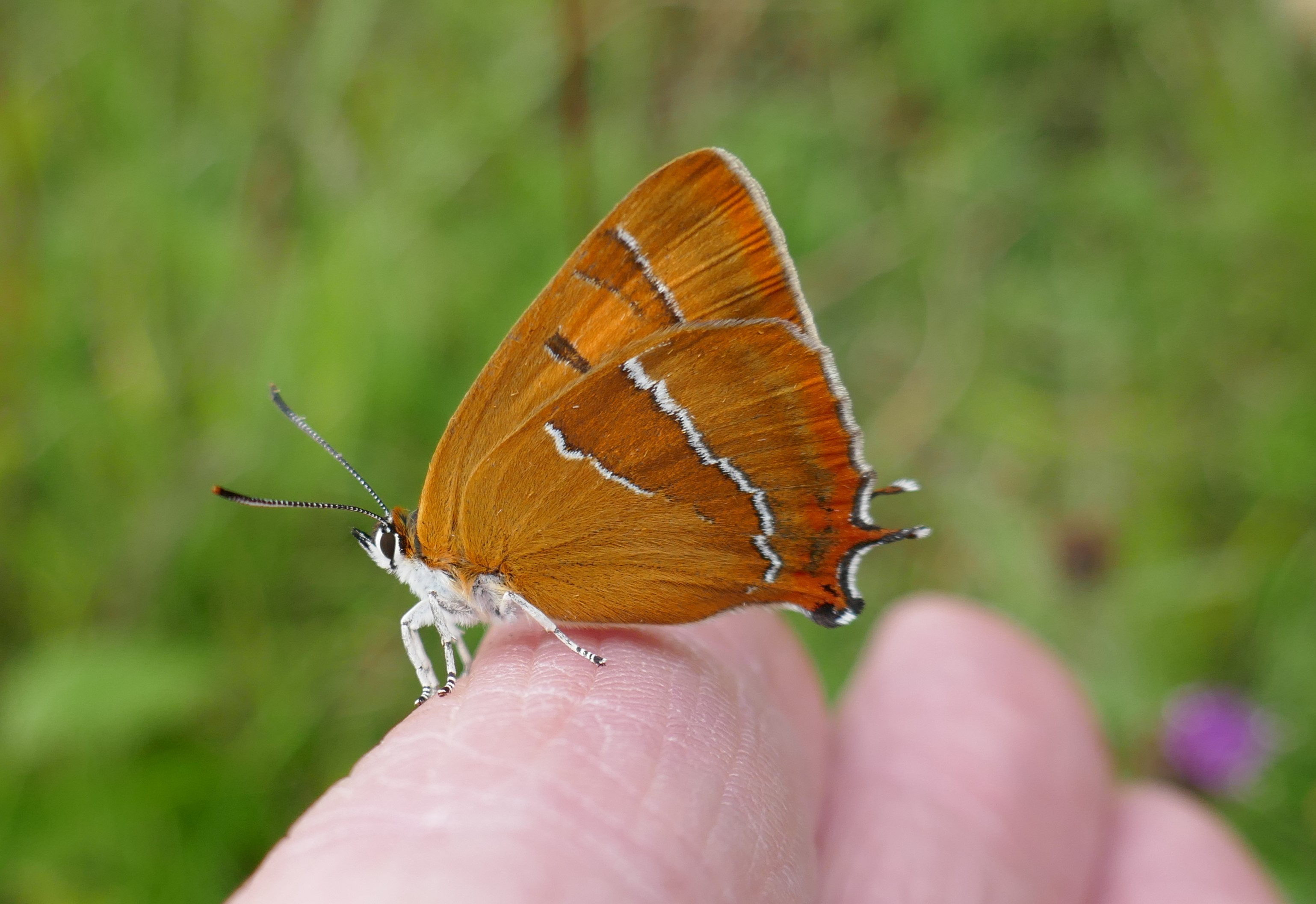 The Brown Hairstreak is quite tame, especially in cool weather.
The Brown Hairstreak is quite tame, especially in cool weather.
Females are especially richly coloured with warm orange-brown undersides, while males usually look paler. Males are more active, jinking around the canopy, especially in the mornings, seeking newly emerged females. Mated females and males spend the long afternoons feeding on bramble and tall hedge side Creeping Thistles.
The overcast weather was against us, because the hairstreaks typically perch quietly on tall scrub, typically on hazel in the Burren. Before we reached likely habitat, we noticed the large population of fresh-looking Meadow Browns, sharply different from the diminished populations in the east, now in rapid decline, their life’s work already done. Common Blue, Small Copper, Ringlet, Grayling, and the occasional Small Heath were encountered in the tall sward.
The scrub patch identified in previous years as a good source of Brown Hairstreak sightings was searched. Nothing at first but high up one was seen, restless around the canopy before settling, wings ajar, on hazel. We failed to coax it to land lower down, but at least we knew they remained faithful to their patch. “If it brightens up, and you’re still around, you should find more here.” I learned that this is what some of our group did in the afternoon when the sunny weather appeared. A female was also found later, and they are rather lovely, in their tame, quiet, approachable way.
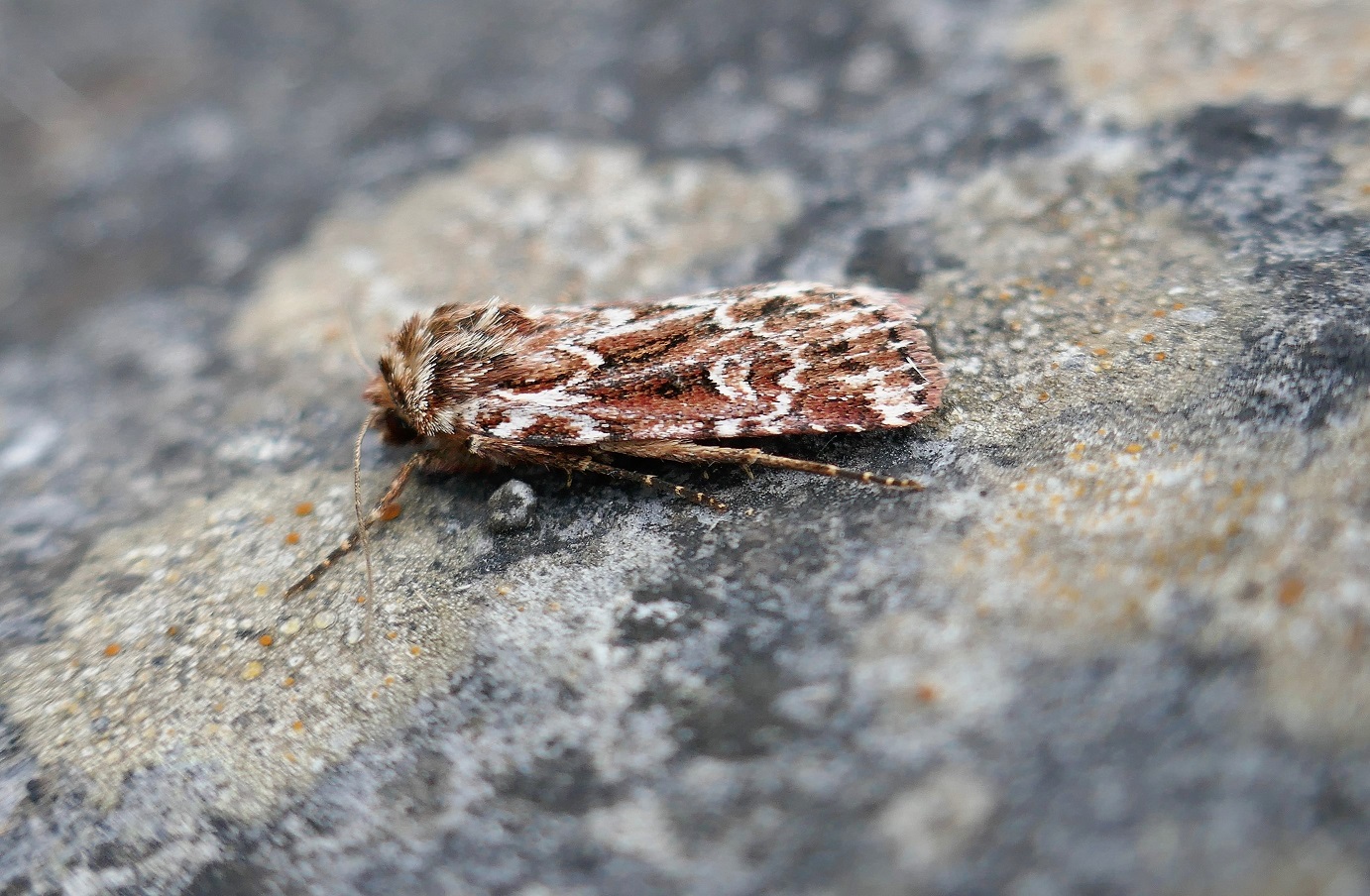
The intricate patterning on the True Lover’s Knot is a delight to observe. This moth occasionally flies during the day.
Later we crossed the road, finding another traditional haunt and another, less camera-shy male, who did fly down to feed on Creeping Thistle. A male Vapourer Moth was seen and photographed close by, a nice addition to the Burren Green and True Lover’s Knot moths caught the night before and shown to our group. The resting Common Blue blends well with the Wild Carrot blooms.[/caption]
We later returned to our cars, for refreshments, and positive feedback on our outing. A great thank you to all who joined our outing, some having made long journeys to share an experience with nature. May the sights we saw live on in our memories, and may the amazing Burren continue to hold its amazing depth and range of wilderness and biodiversity.
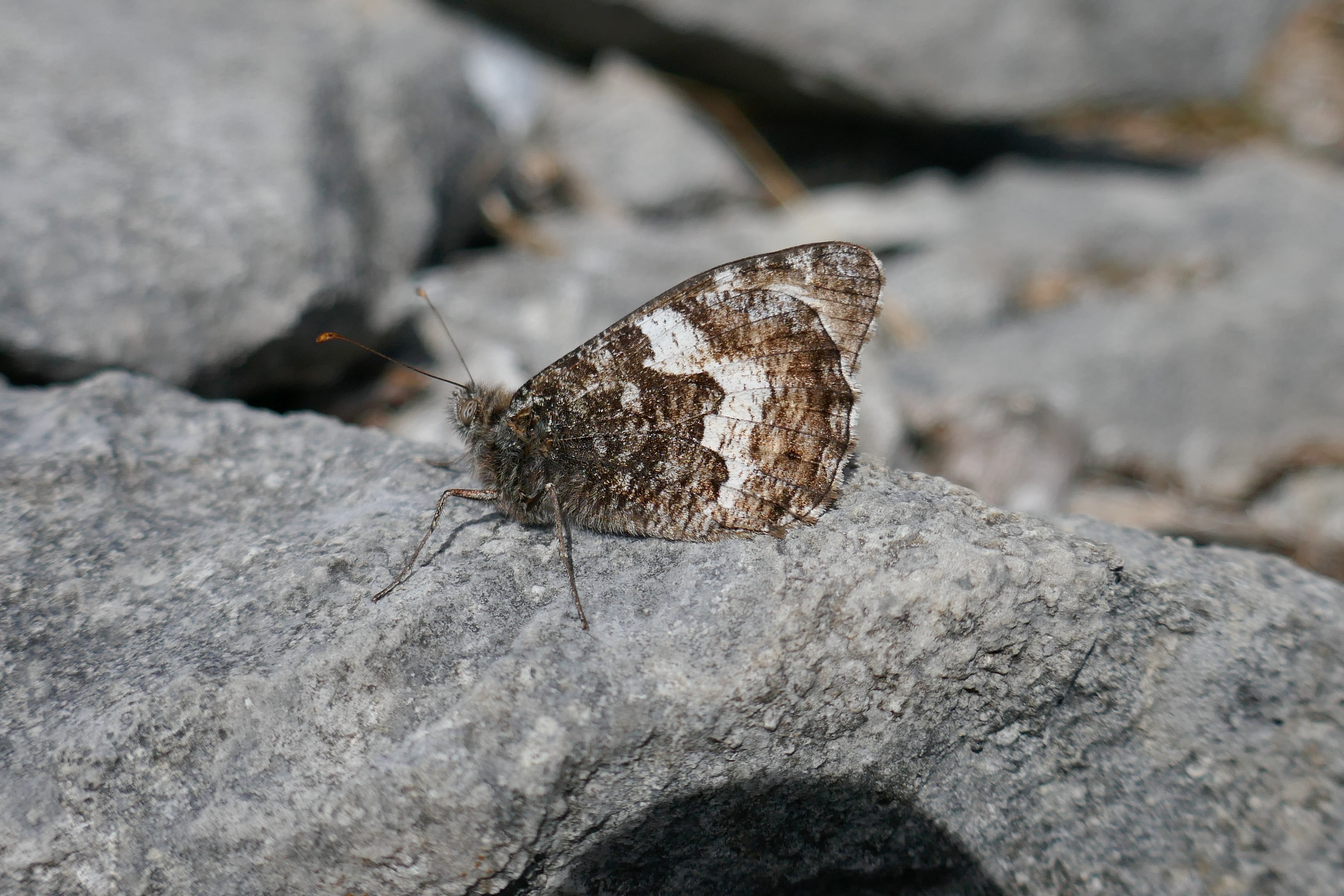 A Burren Grayling resting on a rock. The species is abundant here during August.
A Burren Grayling resting on a rock. The species is abundant here during August.
Event Report: Reserve Management Day Saturday 12th November
One of the results of Ireland’s impoverished fauna is the lack of large wild grazers over most of our grasslands. This means that grazing by cattle, vital to maintaining semi-natural grasslands, has to be arranged as a direct conservation management tool. This is true of our best semi-natural grasslands in the Burren Counties Clare and Galway, in Sheskinmore, County Donegal, Ballyteige Burrow, County Wexford, and on Butterfly Conservation Ireland’s reserve at Lullybeg.
Cattle grazing tackles the grasses that would otherwise form dense, tall mats that overwhelm the existing flora and inhibit the germination of new flora. Micro-climate variation is created by cattle grazing patterns, particularly by selective grazing and poaching.
Another issue to be tackled is scrub control and this is where human hands are needed. On a very grey Saturday when it threatened to rain but luckily remained dry, our volunteers focused on a long rectangular area very rich in flowers but with hundreds of birch saplings that pose a major challenge to maintaining species-richness.
The work we embarked on was not really taxing but was repetitive. Working methodically, hundreds of saplings, now leafless, were removed. The area, shown in a photo taken in dull light, is used primarily as a feeding area by the reserve’s butterflies.
The recently grazed area that we cleared of birch saplings.
Containing masses of Devil’s-bit Scabious, with occasional Common Knapweed, Common Spotted Orchid, Common Milkwort, Common Dog-violet, and hawk-bits, this grassland was especially favoured by the Comma and Red Admiral this autumn. It is also used by the Small Purple-barred, an uncommon, small but striking day-flying moth that is double-brooded in the area.
While we uprooted the birch and occasional willow, a great catch-up on our news and summer butterfly experiences coloured and animated our toil. It can be difficult for anyone who has not visited Lullybeg Reserve in its summer pomp to realise how this site, so bedraggled in its appearance in late autumn and winter, can boast such riches of beauty and biodiversity during the spring and summer.
When May comes, the work makes sense!
Thanks are due to everyone involved with this event, and all our friends and supporters.
CRABTREE RESERVE REPORT 2022
| Species Recorded | Site Total 2018 | Site Total 2019 | Site Total 2020 | Site Total 2021 | Site Total 2022 |
| Dingy Skipper | 14 | 10 | 10 | 47 | 31 |
| Brimstone | 63 | 102 | 52 | 47 | 44 |
| Cryptic Wood White | 3 | 9 | 6 | 6 | 1 |
| Green-Vn’d White | 40 | 6 | 7 | 10 | 14 |
| Orange-tip | 9 | 7 | 2 | 1 | 1 |
| Large White | 1 | 0 | 2 | 2 | 1 |
| Small White | 26 | 4 | 2 | 3 | 2 |
| Green Hairstreak | 0 | 0 | 1 | 0 | 0 |
| Common Blue | 71 | 44 | 36 | 31 | 18 |
| Holly Blue | 0 | 0 | 1 | 0 | 0 |
| Small Copper | 30 | 15 | 20 | 13 | 12 |
| Red Admiral | 13 | 65 | 13 | 2 | 93 |
| Painted Lady | 77 | 260 | 0 | 2 | 1 |
| Small Tort | 500 | 206 | 231 | 270 | 134 |
| Peacock | 243 | 319 | 48 | 39 | 17 |
| Comma | 0 | 1 | 0 | 0 | 21 |
| Dark Green Fritillary | 35 | 27 | 21 | 11 | 2 |
| Silver-Washed Frit. | 36 | 28 | 9 | 6 | 8 |
| Marsh Frit. | 31 | 80 | 163 | 287 | 206 |
| Wall | 1 | 0 | 1 | 1 | 0 |
| Speckled Wood | 51 | 35 | 11 | 7 | 19 |
| Meadow Brown | 239 | 401 | 204 | 417 | 206 |
| Ringlet | 752 | 1423 | 588 | 1097 | 636 |
| Small Heath | 63 | 57 | 44 | 74 | 35 |
| Large Heath | 0 | 0 | 0 | 0 | 1 |
| Total | 2298 | 3099 | 1472 | 2373 | 1514 |
The butterflies on Butterfly Conservation Ireland’s Crabtree Reserve at Lullybeg are counted by walking the transect route (a fixed route walk through a range of habitats that reflect those found on the reserve) on part of the reserve from April to the end of September and in October when conditions favour butterfly activity. Results are sent to the National Biodiversity Data Centre for the Irish Butterfly Monitoring Scheme. Butterflies seen outside the transect route are counted separately but the table above gives combined figures to give the site total (note: only managed areas of the site are surveyed). In 2021 and 2022, 21 counts were made. Twenty-two species were seen on the reserve in 2022.
Abundance variations between years even within sites are normal. A cumulative ongoing decline in abundance is a cause of concern especially for species that are ranked as threatened or near threatened on the butterfly red list. The table shows that 16 out of 25 species showed declines on the 2021 figures and three species were not seen on the reserve in 2022. Some of the declines are large and may indicate a decline in the suitability of the habitat for some species. A decline that is worrying is the drop in the Dark Green Fritillary, which has fallen over the previous four year including 2022, despite the presence of what appears to be suitable breeding conditions in parts of the reserve. We attempted to address this decline by removal of birch saplings on the southern side of the reserve to add more breeding habitat; some of this work was carried out during a management day in October 2021 and in late winter 2022. This intervention may not have been timely enough, and we might be in a better position to judge the effect in 2023.
The major successes on the reserve in 2021 were two priority species, the Small Heath and the Marsh Fritillary. The Small Heath has shown worrying declines on the reserve, and we are concerned about this situation. The Small Heath’s reliance on finer grasses for breeding makes it vulnerable to the development of ranker grasses. The butterfly might be assisted by soil disturbance to interrupt successional change and cattle poaching to create bare soil so that fine-bladed grasses can develop and adjoin warm, exposed soil. However, we have noticed that dense tufts of Red Fescue grass, growing at a high density in open, unshaded situations are where the highest numbers of the Small Heath are concentrated. In these areas, very occasional grazing might be needed, but the aim where well-developed fescue exists is to maintain this sward and keep it free from encroachment by scrub.
Unfortunately, the Small Heath declined in 2022, showing a reversal of 2021’s gains. At 35 individuals it is at an historic low on the site. However, the main flight month for the Small Heath on the reserve is June when there were only three counts instead of four and the first week in July was also missed. We would expect to add some Small Heaths during those two missed weeks. Added to this, the weather in June 2022 saw above average rainfall for many, and dull, overcast weather. The percentage of sunshine recorded during the three June transect walks on the reserve was 30%, 0% and 50%. These are not good conditions for the Small Heath, which is active only in direct sunshine.
The Marsh Fritillary did well again in 2022 when we counted 206, a slight dip from 2021 but we suspect we undercounted the species. The population has been increasing since 2016, and we are delighted that our management of the reserve has paid off for this endangered butterfly.
The Ringlet dropped from 1097 individuals in 2021 to 636 in 2022. This grass feeder may have lost abundance due to dry weather especially in March and April, which may have reduced grass growth. Its larva may like warm wet weather which boosts grass growth. Even the adult butterfly is satisfied with warm, wet weather; it will readily fly in drizzle, if it is mild.
Two species that usually show in high numbers on the reserve and throughout the wider area, the Brimstone and Peacock, remained in low numbers again in 2022. There seems to be no reason related to habitat quality to explain these sharp falls, so it appears that a feature such as larval losses due to predation might be responsible. After years of the populations of both species doing well not just on the reserve but across the country, both now appear to be falling in numbers.
Provided we maintain the habitat conditions needed, these species will be in a position to benefit if the decline factors reduce.
We did not see the Holly Blue, Green Hairstreak or Wall Brown on the reserve in 2022. The big success story is the Comma, which was recorded previously only in 2019, but 21 were seen in 2022. We suspect that the Comma will become established on the reserve. We have yet to confirm breeding by the species on the reserve, but the numbers seen imply residency.
Thanks are due to all who helped with reserve management during 2022. Without your help, our reserve would not be the butterfly success story it is.
CONSERVATION NEWS 2022
This report deals with some of our work undertaken during 2022. During February 2022, the planned work party uprooted birch and willow to clear the grassland on the southern side of the reserve. This area was extensively used by the Marsh Fritillary during the autumn of 2021 and spring 2022. This is unusual on the reserve; the species mainly uses the northern side of the reserve, but colonies are known to move around from time to time. Some scrub clearance by hand was undertaken by individual members at various times during January and February and this made a great difference to the habitats, particularly for the Marsh Fritillary, Dingy Skipper and Brimstone.
Scrub on the broad ride through woodland connecting Lullymore and Lullybeg was cut to ensure that the two excellent areas remain linked so that butterfly populations in the area do not become isolated. Machinery cut scrub along the access route to the site, in the southern part of the reserve and along the silt pond on the northern edge of the reserve which is used as a feeding area by butterflies. On August 28th 2022, 73 Marsh Fritillary larval nests were counted on the reserve, up from 65 Marsh Fritillary larval nests found in 2021 and far above the 29 nests found in September 2020. These nest counts represent a booming population. Our recording scheme begun in 2013 continued in 2022.
Our online platforms promoted conservation throughout 2022. Various blogs were written to draw attention to butterfly and moth species that may be seen at various times of the year, to conservation measures one can take to enhance gardens and public spaces for butterflies, to promote recording, to comment on findings of various reports on butterfly and moth populations and to report on Butterfly Conservation Ireland outings. Our Facebook page presents very attractive images sent in by members and by the public, as well as publicising our work/events. Conservation and habitat enhancement advice was provided to a range of bodies and members of the public.
Following the announcement by Bord na Móna of government and EU-funded peatland rehabilitation schemes which involve re-wetting cutaway and cutover bogs, Bord na Móna has produced Cutaway Bog Decommissioning and Rehabilitation Plans for several bogs. Butterfly Conservation Ireland made submissions to Bord na Móna regarding the plans for these bogs. Butterfly Conservation Ireland is alarmed that these plans do not make any commitment that the rehabilitation works for the selected bogs will permanently secure these bogs for biodiversity and climate action. We have argued that no future use that compromises the rehabilitation of any rehabilitated peatland be considered.
Serious challenges remain because many legally protected bogs that are not state-owned are being destroyed and little or even nothing is being done to uphold the law. We will continue to lobby the government to stop this illegal activity. This is a scandalous breach of the law, and no one should expect to escape punishment for this criminal activity. Mouds Bog, County Kildare is an example of a protected bog that is being damaged in plain sight of the state and no prosecution has been taken to punish criminal wrongdoing. While this lack of commitment on the state’s part exists, our bogland butterflies and moths and their habitats stand little chance.
Building support for the proposed National Peatlands Park continued throughout 2021 and 2022. Several meetings to develop the proposal and communicate our vision were held during the past accounting year. We made a further submission to Minister Noonan and a final submission to the Draft Kildare County Development Plan 2023-2029, in April and May 2022 respectively. Butterfly Conservation Ireland produced a brochure to support the proposal (available as a PDF to anyone who wants it). Copies of this have been provided to important decision-makers and it was submitted as part of our response to the draft Kildare County Development Plan. The Plan, now complete contains several supportive references to the National Peatlands Park, so we are hopeful that the final Plan will show strong support for this vital, landscape-scale proposal to tackle our biodiversity crisis. This project is on-going and has resulted in intensive engagement and planning. We hope to have some positive news on this venture in 2023.
A detailed submission was made to the Citizens’ Assembly on Biodiversity Loss in October 2022. A submission was made to the Consultation on the Draft Forest Strategy (2022-2030) in November.
Butterfly Conservation Ireland is a key partner in an all-Ireland initiative, involving the National Biodiversity Data Centre, Butterfly Conservation UK Northern Ireland branch to produce a butterfly atlas for Ireland 2017-2022. This work is nearing completion. Several members are involved in producing species accounts for the Atlas, a reflection of the expertise within our membership.
We have continued to engage with the construction team working on a solar farm on Drehid Bog, County Kildare to ensure that no damage is done to the habitat used by the Small Skipper. Two meetings were held in the field during 2022 to guide the mitigation and advise on conservation work planned for the site. In early 2023 we raised concerns in relation to the Sheep’s Head peninsula in County Cork where damage occurred on the Special Area of Conservation. Issues arising were reported to the National Parks and Wildlife Service. We have been assured by the Conservation Officer, Patrick Graham, that the situation is being taken very seriously. The issue-raising is important because it encourages the Wildlife Service to conduct site visits to ensure that the conservation values of the site, typically reflected in the conservation status of the features that qualify the sites for designation are not being adversely affected by prohibited activities.
Our members have continued to work hard, organising and carrying out fundraising, recording, participating in practical conservation work and, very importantly, enjoying our butterfly and moth heritage.
Please continue your recording and conservation work in 2022; no matter how small your work may seem you can make a difference. Some man-made habitats, such as gardens, often contain a greater range of biodiversity than semi-natural habitats because of the diversity of habitats and micromanagement possible in a garden.
Finally, Butterfly Conservation Ireland thanks everyone who helped with our conservation and education work in 2022. Conservation is a battle for the preservation of everything that is good about our natural world and we greatly appreciate your commitment to the most elegant emblems of our natural heritage, our butterflies and moths.
GARDEN SURVEY REPORT 2022
Butterfly Conservation Ireland members and members of the public participate in our garden survey from March to November inclusive. The survey form, available as a download from our website www.butterflyconservation.ie and available by post on request to conservation.butterfly@gmail.com asks the participant to record the first date each butterfly listed on the form was first recorded in their garden in each of the following three-month periods: March-May, June-August and September-November. In a final column, the highest number of each butterfly species seen, and the peak date is given. Finally, surveyors are asked to indicate which of the following attractants are provided in their gardens: Buddleia, butterfly nectar plants other than Buddleia and larval food plants. Twenty butterflies are listed for recording. The following report comments on the 2022 flight season, outlines the status of these butterflies in gardens during 2022, offers interpretations and comments on the findings and concludes by urging conservation and involvement in recording garden butterflies.
We saw some high abundance figures in some gardens. Robert Donnelly, whose superb garden in Ballyknock, County Kilkenny counted 91 Small Tortoiseshells on August 17th. One recorder, Michael Gray, whose flower-rich garden is in Rathfarnham, Dublin, recorded more butterflies (125) in 2022 than in 2021 (115). The peak year in Michael’s garden was 2017 when 166 butterflies were recorded. Over the season, Michael recorded 51 Holly Blues, a very good total. One observer, Elaine Mullins from Portmarnock, counted every individual butterfly she saw during the recording period. Elaine’s beautiful suburban garden returned 201 individual Holly Blue sightings between March 26th and September 18th, 124 Large Whites (71 in 2021) between June 17th and September 24th and 106 Small Whites between April 6th and September 30th. However, one UK recorder, from Whitney in Oxfordshire whose garden in located in a housing estate surrounded by intensively farmed arable land recorded eight of the 20 species listed on the survey, suggesting the negative effects of intensive farming on overall biodiversity.
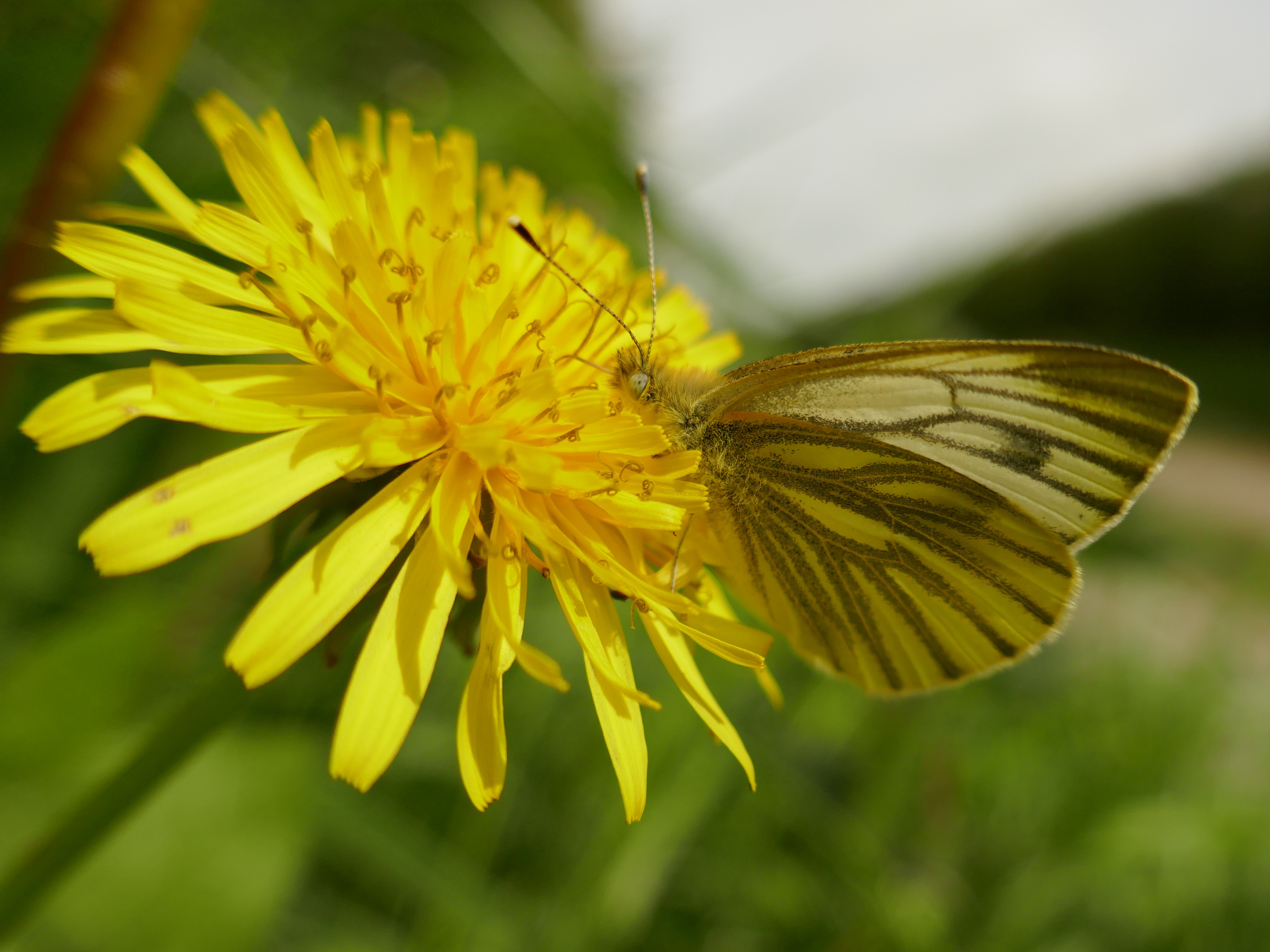 A spring Green-veined White on a dandelion. This butterfly is a ready visitor to many gardens.
A spring Green-veined White on a dandelion. This butterfly is a ready visitor to many gardens.
It was not possible to identify key dates for butterfly abundance for 2022, probably because we had prolonged good weather during August, the key month for garden butterflies. August 2022 was exceptional for high temperatures, sunshine hours and dryness. The highest temperature ever recorded in Ireland for August was 32.1 Celsius, recorded in Durrow, Co. Laois on August 13th, exceeding the highest ever recorded at a weather station, which was 31.7 Celsius, recorded the day before at Oak Park, Co. Carlow! The peak abundance dates for garden butterflies are usually reached early in the fourth week in August such as August 24th in 2021. However, because the weather throughout the month was so warm, population peak patterns observed in previous years are not evident from the survey reports. Like in previous years, the first two weeks in September also saw abundance, especially for the Speckled Wood and Small Tortoiseshell.
The number of species recorded in the gardens surveyed was 19; it was 17 in 2021 and 2020 and 18 in 2019 and 2018. The missing butterfly is the Clouded Yellow. The total of 19 garden butterfly species is up from 15 in 2017, up on 14 in 2015 and 2016; in 2014, 17 species were recorded. Three unusual garden visitors were reported in 2022. These were the Silver-washed Fritillary (Pat Bell in Maynooth, Richella Duggan in her suburban garden in Mullingar and Robert Donnelly in a rural garden in Co. Kilkenny), Green Hairstreak (Eleanor Hort, in a rural garden near Ardara, Co. Donegal, April and June) and Wall Brown (Elaine Mullins, in a suburban garden near the coast at Portmarnock, Co. Dublin). Interestingly, only the Peacock was reported from all gardens in 2022. The Small Tortoiseshell and Peacock were recorded in all gardens in 2021 and 2020. The Large White was recorded in all but one garden in 2022. The Green-veined White did well in our gardens and was absent only from the Oxfordshire and Portmarnock gardens. The highest abundance recorded for the Green-veined White was 16 on May 17th by Eleanor Hort. From observing the dates it was recorded, it might have produced three generations in some areas in 2022. This butterfly flies reliably in two generations, flying mainly in May/June and from mid-July and during August into early September. The recorded flight period for the Green-veined White in gardens during 2022 was from April 24th to September 10th.
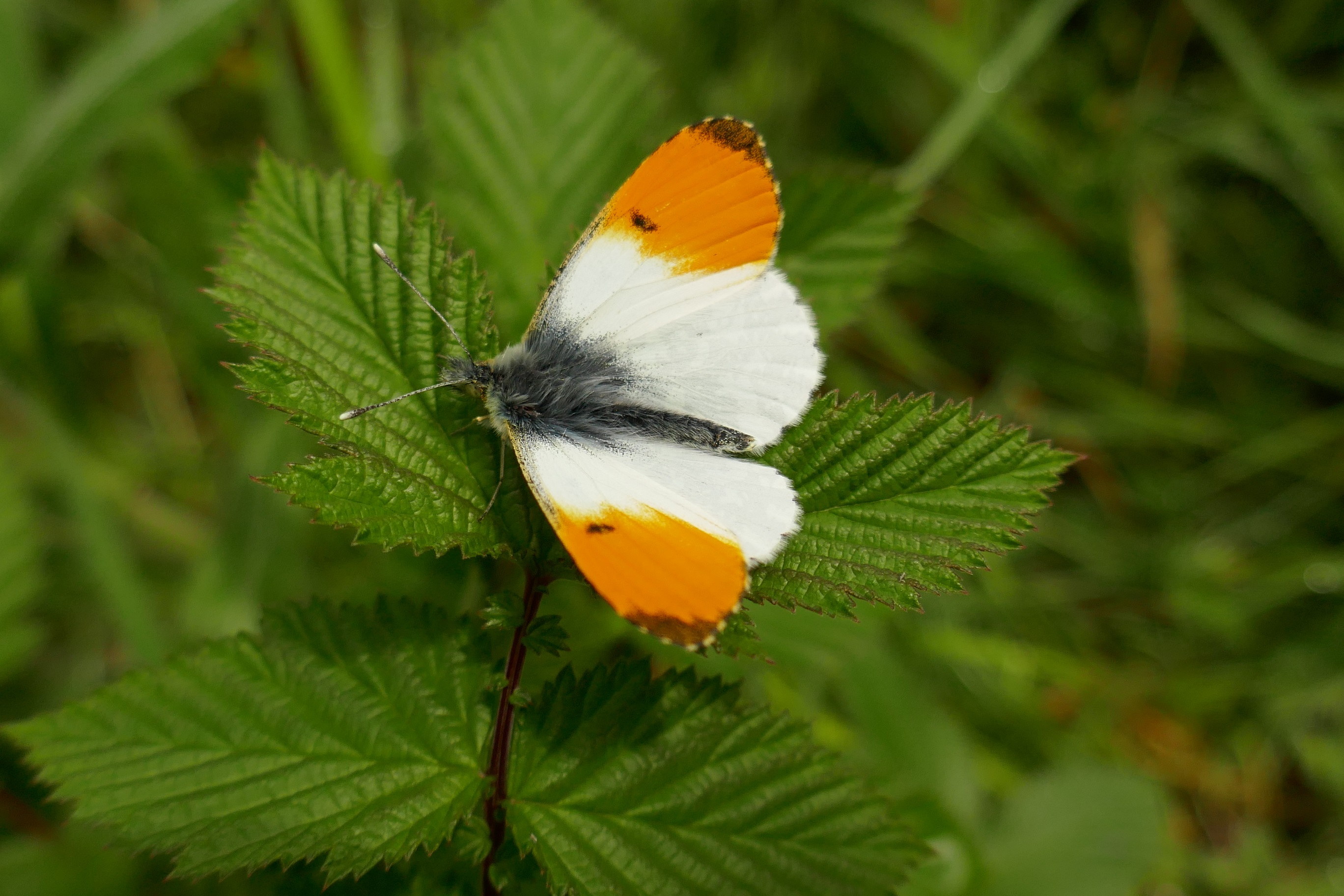 Male Orange-tip. A wetland in a sunny place will usually attract this spring and early summer butterfly.
Male Orange-tip. A wetland in a sunny place will usually attract this spring and early summer butterfly.
The Holly Blue, a species that likes to breed in gardens was reported by all but three surveyors in 2022. The Holly Blue loves to breed in warm, sunny gardens with warm, bare walls and shelter and is especially happy in Dublin city centre and in gardens near the Dublin coast. The Holly Blue is notably less numerous in rural gardens, despite the presence of its breeding plants. It needs high temperatures around its larval foodplants.
The Comma was reported from gardens in Kilkenny (the highest number on one day is five, an unusually high number, especially for a garden), Kildare, Meath and Dublin. Twelve were counted over the survey period in one garden. The Painted Lady, ubiquitous in 2019, appeared in small numbers in fewer gardens, although Robert and Jane still had nine on September 15th in their superb Kilkenny garden. A boom-and-bust pattern in this migrant’s appearance in Ireland is the norm!
Other less common garden visitors in 2022 were the Orange-tip, Cryptic Wood White, Small Copper and Common Blue (a low-flying grassland breeder that contrasts with the high-flying hedgerow-inhabiting Holly Blue). Strangely, the Common Blues in my garden totally ignored Common Bird’s-foot-trefoil, the usual breeding plant, and laid eggs only on Black Medic. There was one garden where the Small Copper appeared in all three-month recording period March-May, June-August and September-November: this was in Felicity Laws’ garden on the Sheep’s Head peninsula in west Cork.
Regarding the brown family, the Meadow Brown was found in all but one garden but numbers varied; the Speckled Wood, recorded in most gardens is territorial in the male so numbers in most gardens are low; the Meadow Brown and Ringlet are more social and much more tolerant of their own kind, allowing numbers to build if the habitat is sizable and suitable. Because the Meadow Brown is less specialised, occurring in open and partly shaded areas, in long and short swards, it is often more numerous in gardens. With the right mix of grassy habitats, and space for these, more can be achieved. Peak counts of 18 Ringlets and 23 Meadow Browns were made by Robert Donnelly.
The earliest butterfly recorded in gardens in 2022 was a Small Tortoiseshell on March 5th. The last butterfly reported from a garden in 2022 was a Red Admiral on October 20th. Some recorders sent notes of other notable species; Pat Bell, Maynooth, was very lucky to record a Currant Clearwing, a rare day-flying moth. Pat also had the Hummingbird Hawkmoth and Migrant Hawker dragonfly in his garden. Habitat mosaics, where a range of habitats are built together as is the case in Pat’s garden pays off when you want to cater for as many species as possible.
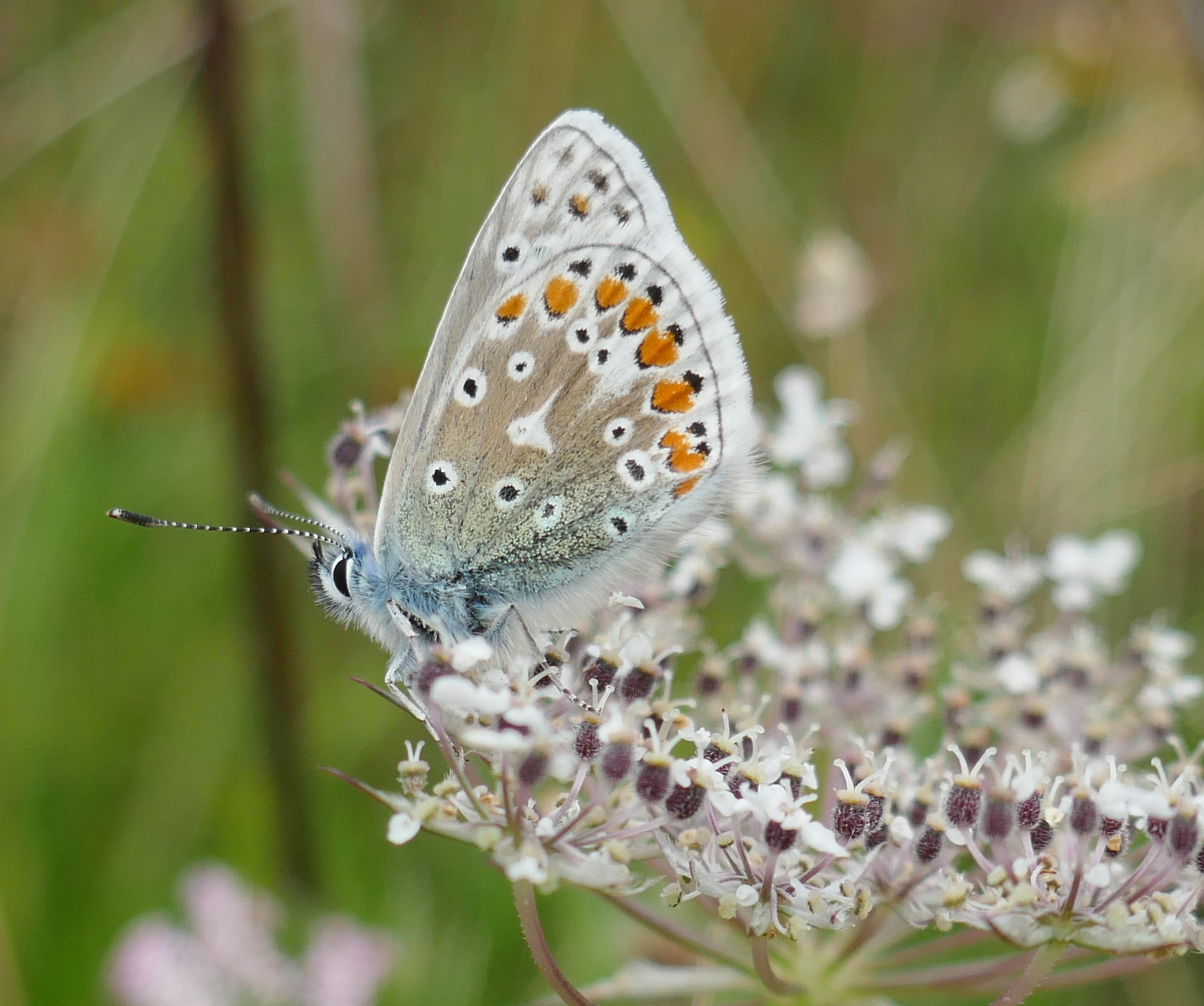 The Common Blue needs a flower-rich grassland or a weedy rockery to be encouraged into gardens.
The Common Blue needs a flower-rich grassland or a weedy rockery to be encouraged into gardens.
Butterfly Garden Tips
And with the ravaging of our natural and semi-natural habitats, that multi-habitat approach to gardening for nature is increasingly important. A pond and associated wetland will be used by a range of animal groups including dragonflies, amphibians, hoverflies as well as butterflies and moths. With the climate models showing longer periods of dry weather in spring and summer, species that breed in damp grassland may become highly dependent on permanently wet areas for survival. The Green-veined White and Orange-tip will become increasingly needful of marshy ground. In short, they will need our help. The great pioneer of wildlife gardening, Professor Chris Baines, commented that a garden without a pond is like a theatre without a stage. An unshaded pond and wetland, stocked with native plants will generate great activity in your garden. Make this your conservation project in 2023.
Other important points concern the overall management of your garden habitats. If growing a semi-natural, flower-rich grassland, opt for a cutting regime that allows your flora to bloom and set seed. If it is a spring flowering meadow, leave it uncut until late in June. If your meadow plants are mainly summer flowering, leave it uncut until later in September, depending on seasonal conditions. Thus, in some years the flowering and seed-setting occurs earlier and the meadow can be cut accordingly. Avoid cutting on a low setting unless you want bare patches. There may be a very good reason for wanting bare soil, which adds warmth to a meadow providing basking sites and enhancing breeding conditions where bare soil abuts caterpillar foodplants. I suspect that might be why my Common Blues laid on Black Medic abutting on bare stone while ignoring other foodplants in a cooler situation.
Finally, look carefully at the article What Flowers are best for Ireland’s Pollinators? in this annual report. A diversity of native flowers, grown in abundance, seems to be very important for pollinators in general, and may be very important for moths and butterflies. Even with a range of flowers available, you will find that some butterfly species show a strong bias for one plant species. Grow as many native species as possible. A good wildflower guide is Zoe Devlin’s The Wildflowers of Ireland A Field Guide (2nd Edition) published by Gill Books. It fits neatly in your pocket, is colour-coded for easy identification of the flower seen in the field and helpfully gives the flowering time and the status of each plant (native or introduced). I use the book, and I find it very useful, yellow members of the Daisy (Asteraceae) family. The book covers more than 620 species, in one tidy volume.
What Flowers are best for Ireland’s Pollinators?
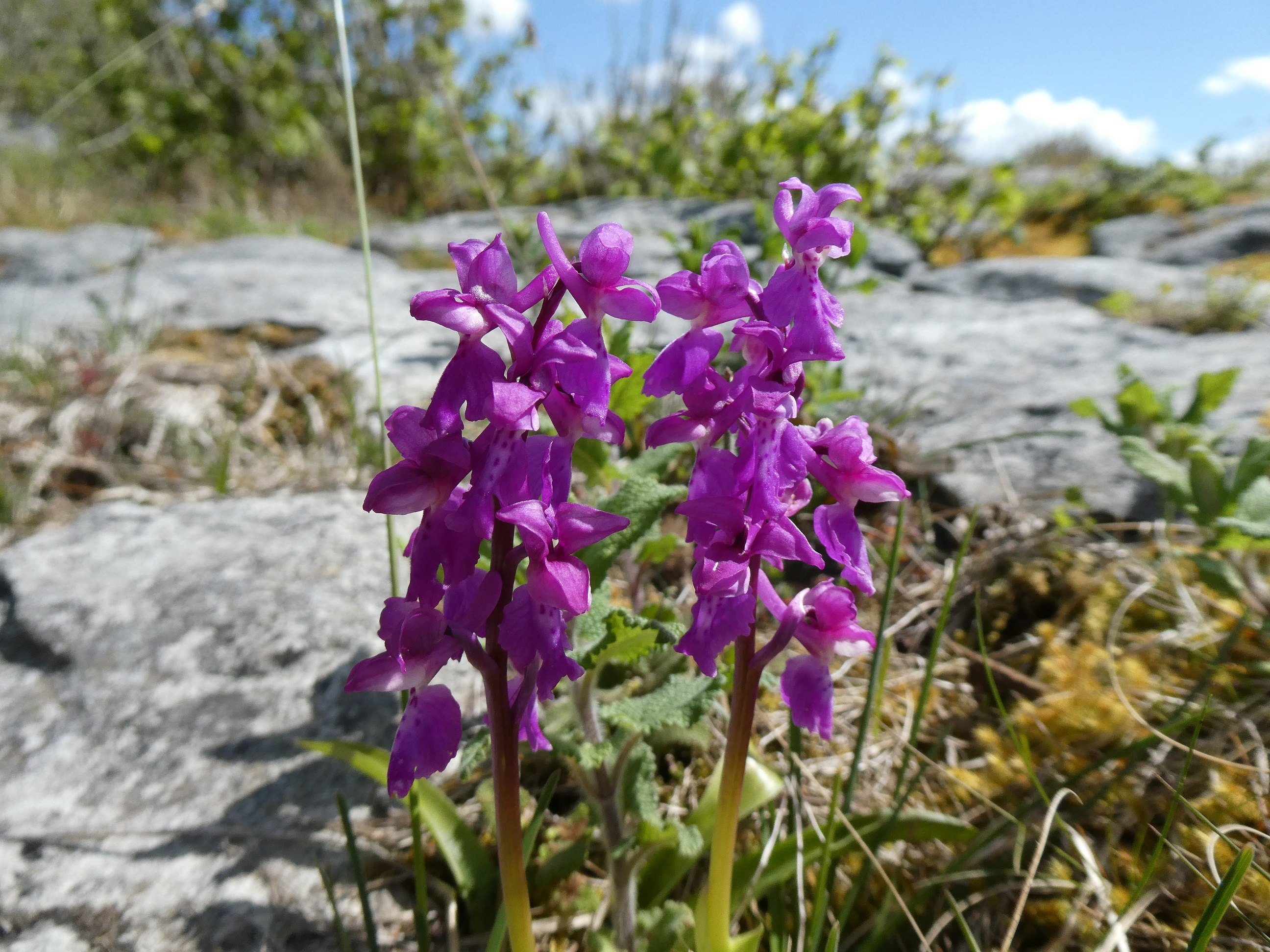
Stunning and locally abundant: but how important are orchids, like the Early Purple Orchid, for pollinators?
It can be very hard to know which plants to select for butterflies, moths, bees and hoverflies, all important pollinators, for our gardens. Domestic gardens are ‘private spaces adjacent to or surrounding dwellings, which may variously comprise lawns, ornamental and vegetable plots, ponds, paths, patios, and temporary buildings such as sheds and greenhouses’ (Gaston et al. 2005). A pollinator is an animal that transfers pollen from plant to plant. This process helps plants to produce seed and fruit. A recommendation was made to me to grow the wallflower Erysimum bicolor ‘Bowles’s Mauve’. I was told that the plant flowers for months and attracts butterflies. I duly took the advice, and placed the plant in a sunny, sheltered situation and waited. The plant had a long flowering time, as advertised. Just one butterfly visited my plant, a persistent Meadow Brown that seemed addicted to it. No other butterfly showed interest. Why did this happen? In UK gardens, butterflies visit it, as is clear from YouTube. Where did I go wrong?
Lists have been published of the plants recommended for pollinators, for example on the websites of organisations such as the Royal Horticultural Society, the Bumblebee Conservation Trust and the Xerces Society, and in books about wildlife gardening. However, according to studies quoted by Rollings and Goulson (2019) these lists appear to be largely based on anecdote or casual observation rather than scientific evidence. Garbuzov and Ratnieks (2014a) compared 15 such lists, and conclude that they are inconsistent, often contradictory, often omit many good plants, and sometimes contain poor recommendations.
According to a British study by Salisbury et al. (2015) there was little difference between the abundance of pollinators in gardens (mainly bees) for the native plants (native to Britain) and near-natives (relatives of native plants, and naturally occurring in the Northern Hemisphere), but considerably fewer flower visitors for the exotics (Southern Hemisphere plants), which had about 40% fewer visitors at typical values of flowering units (a flowering unit is a single flower or umbel, spike or capitulum (dense flower cluster) for species with reduced or compound flowers). This study recommended planting a variety of flowering plants in gardens biased towards native and near-native species with a careful selection of exotics to extend the flowering season and perhaps provide resources for some groups, for example solitary bees. The study also found that the more flowers there were, the more visitors they received.
However, the study did not look at how well native and non-native plants supported animal biodiversity. The advice provided to grow plants from native, near-native and exotic sources applies to gardens only, not to land in the countryside.
The study by Russo et al. (2022) is very important because it was conducted in Ireland and looked at four main habitat groups, not simply gardens.
The study looked at four primary habitat types where interactions between pollinators and plants were recorded in Ireland. These were intensively managed areas (agricultural or developed), coastal dunes, grasslands (including both seminatural and managed), and woodlands/shrublands.
The scientists collated data from six different studies in Ireland where obligate (necessary) flower-visiting insects (specifically Lepidoptera, bees, and hoverflies) were observed/collected while foraging on flowers from May through August in 2009–2011 and 2017 and April through October in 2018. Transect surveys were made for this study.
What does the study reveal? The study analysed flower-visitor interactions between 239 flowering plant species and 148 insect visitor species in Ireland. The composition of the insect visitor species observed was: 54.7% hoverflies (Syrphidae), 30.7% bee (Anthophila), and 14.6% butterflies and moths (Lepidoptera). However, bees dominated in terms of abundance on flowers (61% bee, 35% hoverfly, and 4% butterfly or moth visits), like in other published studies.
Although intensively managed habitats had the highest plant species richness, they also had the highest proportion of non-native plant species. Moreover, they had proportionally lower insect species richness; intensively managed habitats had 2.44 times as many flowering plant species as insect visitor species. The only habitat with more visitor species than plant species was coastal dune systems, which also had the highest connectance (links between species).
In wood and shrubland habitats, there remained nearly twice as many plant as insect species. The grassland habitats (including both seminatural and managed) had the highest insect species richness overall, along with the greatest average abundance and species richness of insect visitors per plant species. Due to their high plant species richness, and corresponding low insect species richness, intensively managed habitats also had the highest abundance of insects per visitor species, and the highest plant species richness per visitor.
There was substantial overlap in insect visitor species across habitats; the most abundant visitors were found in all habitats and visited the largest number of plant species. On the other hand, only four plant species were found in all four habitat types: (bramble Rubus fruticosus agg. L., Common Ragwort Senecio jacobaea L., dandelion Taraxacum agg. L., and White Clover Trifolium repens L.). Non-native plant species represented 50% of plant species richness on average across surveys but received only 11% of total visits.
Recommendations This analysis showed cosmopolitan plant species with a broad distribution and high abundance of floral resources support the most abundant and widespread insect species. For example, to maximize the abundance of insects, we need to protect species with a high average abundance of visitors. Across all flower-visitors, bramble was found in all surveyed habitat types and had the highest average number of insect visitors, followed by White Clover, Creeping Buttercup Ranunculus repens L., Common Knapweed Centaurea nigra L., and Creeping Thistle Cirsium arvense (L.).
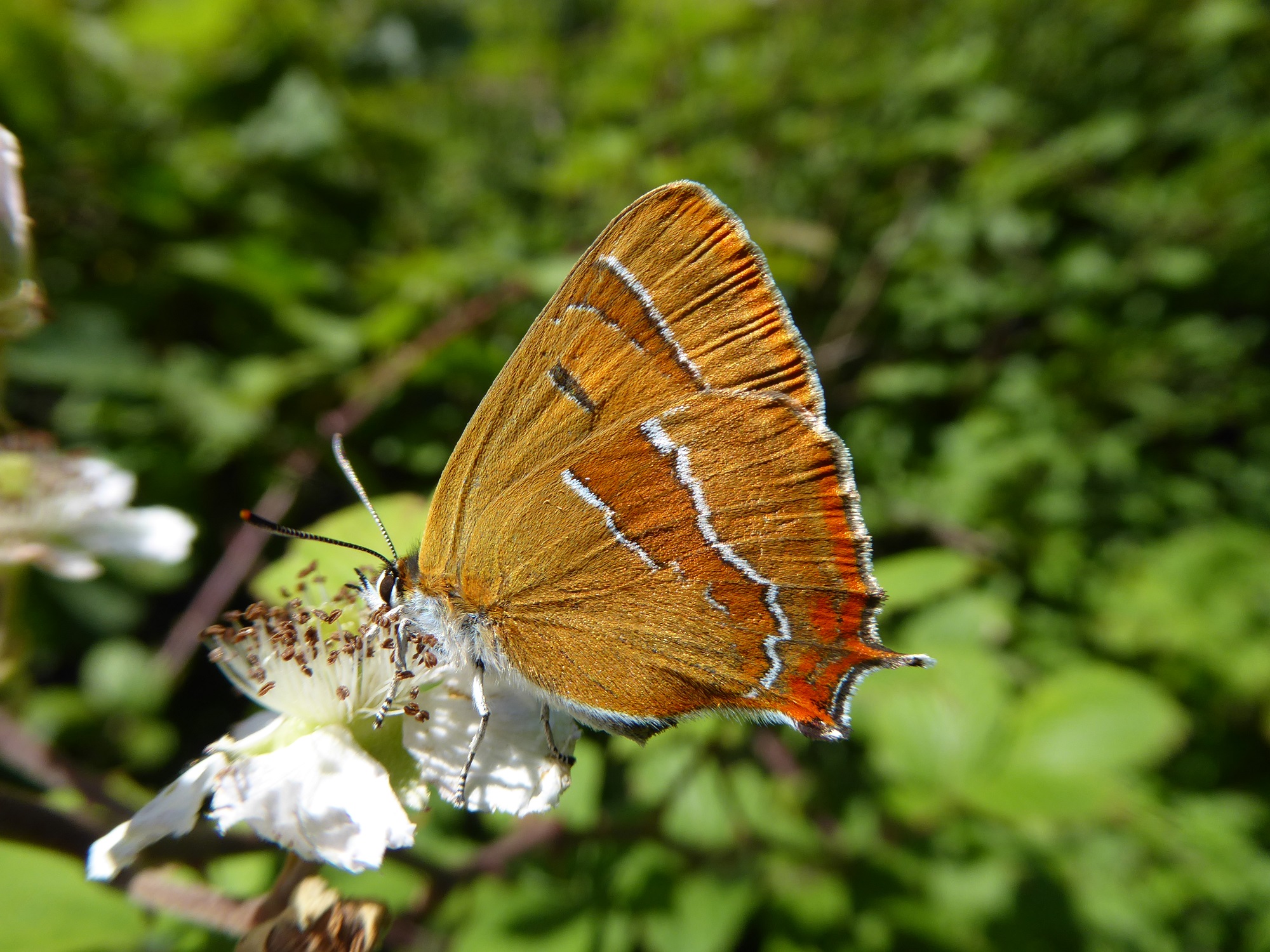 Brown Hairstreak on a bramble flower, one of our most important flowers for pollinators, including butterflies.
Brown Hairstreak on a bramble flower, one of our most important flowers for pollinators, including butterflies.
To support a high diversity of flower-visiting insects, the study recommends protecting species with a high visitor species richness. Creeping buttercup supported the highest average number of visitor species, followed by bramble, Rough Hawkbit Leontodon saxatilis, Creeping Thistle, and Common Knapweed. White Clover was also visited by the largest number of insect species overall (49 of 148, or 33% of the insect species. Creeping Buttercup had the longest duration of bloom, along with Red Clover Trifolium pratense L., and thus can provide resources throughout the flowering season. It is important to note, however, that the large role of these plant species in the plant-pollinator community is likely due to their large distribution and high abundance. In fact, members of the plant family Fabaceae (pea family: trefoils, vetches) punched above their weight. Bees, moths, and butterflies also preferred the plant family Fabaceae over its background prevalence. One plant in the family Fabaceae was especially important. Common Bird’s-foot-trefoil Lotus corniculatus L. supported the greatest abundance of butterflies and moths. In addition, this plant is important food for the caterpillars of several butterflies and moths.
Thus, planting, or protecting these species may have high value in supporting common and abundant flower-visiting insects but may not support uncommon or specialized insects. For this purpose, it may be wise to maximize functional complementarity (applied to plant–pollinator interactions, functional complementary suggests that a higher diversity of pollinators contributes to an increased pollination success of the plants or, in turn, that a higher diversity of flowers may better sustain the visitors’ requirements). Here, the species with the highest functional complementarity were Rough Hawksbeard Crepis biennis L., (non-native) followed by Water Figwort Scrophularia auriculata L., Pink Wood Sorrell Oxalis debilis (non-native), Cashews Rhus spp. (non-native), and Perennial Wall-rocket Diplotaxis tenuifolia (non-native). The plant species with high functional complementarity tended to be rarer and supported less common insect visitors.
The thirty-five plant species in the Irish plant-pollinator network that rank in the top ten of the different measures (visitation rate (a), average abundance of visitors (weighted degree, (b)), average species richness of visitors (unweighted degree, (c)), betweenness centrality (d), duration of bloom, (e) and functional complementarity (supporting different insects) (f)) ranked from highest (top) to lowest (bottom) under (e) are:
Trifolium pratense Red Clover
Ranunculus repens Creeping Buttercup
Potentilla erecta Tormentil
Lotus corniculatus Common Bird’s-foot-trefoil
Bellis perennis Common Daisy
Centaurea nigra Common Knapweed
Prunella vulgaris Selfheal
Plantago lanceolata Ribwort Plantain
Leontodon saxatilis Lesser Hawkbit
Trifolium repens White Clover
Ranunculus acris Field Buttercup
Heracleum sphondylium Common Hogweed
Taraxacum agg Dandelions
Cirsium arvense Creeping Thistle
Rubus fruticosus Bramble
Cirsium vulgare Spear Thistle
Cirsium palustre Marsh Thistle
Leontodon hispidus Rough Hawkbit
Thymus polytrichus Wild Thyme
Scorzoneroides autumnalis Autumn Hawkbit
Senecio jacobaea Common Ragwort
Lapsana communis Nipplewort
Lythrum salicaria Purple Loosestrife
Fuschia sp Fuschia
Oxalis debilis Large-flowered Pink-sorrel (non-native)
Crepis capillaris Smooth Hawksbeard
Buxus sempervirens Box
Sambucus nigra Elder
Glenchoma hederacea Ground-ivy
Primula vulgaris Primrose
Chrysanthemum segtum Corn Marigold (Probably introduced)
Diplotaxis tenuifolia Perennial Wall-rocket (non-native)
Rhus sp Cashew Family non-native
Scrophularia auriculata Water Figwort
Crepis biennis Rough Hawk’s-beard (Probably introduced) (Note: Above list edited 04/03/2023)
Identifying plant species with a central role in the broader flower-visitor community, as this study does, is an important first step in pollinator conservation. Native plants were preferred by insect visitors. Only four of the top 35 plants are non-native, and at 11% of these plants, this figure is much lower than the abundance of these plants in the plant-pollinator network (31.7%). The study also showed how important it is to protect semi-natural grassland habitats, something we are not doing well.
Some caution is indicated in relation to the findings of this study. This study looked at the plant-pollinator network. Most plants in the study were pollinated by bees and hoverflies. The study does not look at the importance of plants are a source of food for insect larvae. The role played by non-native plants in animal biodiversity is likely to be much lower, and native plants should be preferred. Furthermore, the non-native plants that are important for pollinators owe some of their significance to their abundance, not to the resource content of each individual plant. The study does not reference the use pollinators make of native plants for purposes other than food. For example, Orange-tip butterflies frequently use the frothy, green and white inflorescence of Cow Parsley Anthriscus sylvestris for concealment. A diversity and high abundance of the native flora should be grown to provide for as much of our pollinators and non-pollinators’ needs as possible. Some non-natives are harmful; Fuschia, ranked highly in the Irish study, is displacing native flora in many areas of the west of Ireland and should be eradicated.
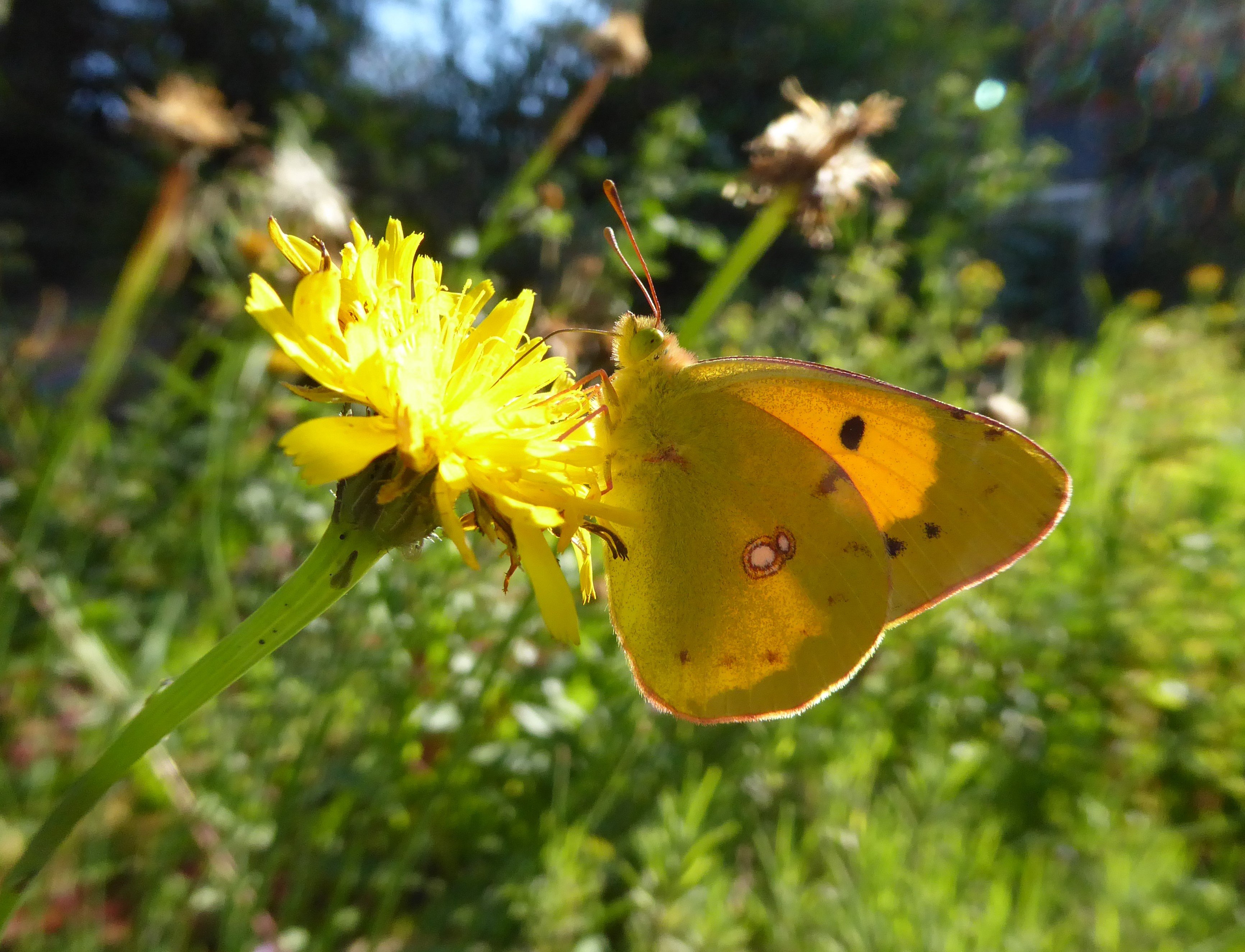 Clouded Yellow (male) feeding on Common Cat’s-ear, a common native plant that is important for butterflies and bees.
Clouded Yellow (male) feeding on Common Cat’s-ear, a common native plant that is important for butterflies and bees.
Garden Habitat A study involving the bee expert Dave Goulson (Rollings and Goulson, 2019) looked at garden habitats. This study used data collected over five years, and comprise over 9000 insect observations, which were identified to species (for honeybees and bumblebees) or as ‘solitary bees’, Syrphidae (hoverflies), Lepidoptera and others. The study was carried out on a 2.5 ha plant nursery in South Oxfordshire, UK (51.636° N, − 1.389° E), situated on the edge of a village and largely surrounded by arable fields. The soil there consists of heavy clay over gravel. The study tested 111 plants in total, including 89 perennials, 6 biennials and 16 annuals. Twenty-five of the plants were UK natives, the remaining 86 being non-native.
Unlike some previous studies, they found no difference in numbers of insects attracted to native or non-native species, or according to whether plants were annuals, biennials or perennials, but they did find that native plants attracted a significantly higher diversity of flower-visiting insects. Overall, the most-visited plants were Lesser Calamint Calamintha nepeta (native to Britain not to Ireland), Autumn Sneezeweed Helenium autumnale (non-native) and Cranesbill ‘Rozanne’ Geranium Rozanne (non-native). However, patterns of visitation were quite different for every insect group examined. For example, different species of short-tongued bumblebees showed little overlap in their most-preferred plants. Interestingly, very similar plants often attracted different insect communities; for example, 72% of visitors to New York Aster Aster novi belgii (non-native) were honeybees or bumblebees, while the related Yellow Camomile Anthemis tinctoria (non-native) which also has daisy-like flowers, did not attract a single honeybee or bumblebee but was popular with solitary bees, hoverflies, and other pollinators.
Some plant cultivars such as Flat Sea Holly Eryngium planum (a cultivar is a plant cultivated by humans for certain traits such as flower colour, large size, bloom longevity, etc) and Field Forget-me-not Myosotis arvensis* were attractive to a broad range of insects, while others attracted only a few species but sometimes in large numbers, such as Culver’s Root Veronicastrum virginicum (non-native) and Autumn Sneezewort which were both visited predominantly by honeybees. We do not fully understand what factors drive insect flower preferences.
It should be emphasised that although most of the plants tested were non-native, this study found insect diversity was significantly higher on native plants compared to non-natives. The geographic origins of plants from the northern hemisphere (native or non-native) did not appear to influence the number of insects that visited them but fewer insects visited plants with a southern hemisphere origin.
Recommendations: The main recommendations from the Rollings and Goulson study are designed to cater for the full range of flower-visiting insects. The authors advise providing plants suitable for different insect types and ones that span the flight season from late winter through to mid-autumn. For example, for maximum attraction of insects they suggest any of Lesser Calamint, Cranesbill ‘Rozanne’, Autumn Sneezewort, Common Marjoram Origanum vulgare and Borage Borago officinalis. To increase diversity of flower-visiting insects one might include natives such as Field Forget-me-not, Wild Valerian Valerian officinalis and Common Knapweed alongside non-natives such as Perennial Coneflower Rudbeckia fulgida, Flat Sea Holly and New York Aster.
Viper’s Bugloss Echium vulgare (native) and Dwarf Catnip Nepeta racemosa would help to cater for long-tongued bumblebees, and Yellow Camomile for solitary bees, while Verbena bonariensis and Canada Goldenrod Solidago canadensis would provide resources for Lepidoptera and hoverflies, respectively. Flowers are often in short supply in early spring when queen bumblebees and several solitary bees emerge, and Lungwort Pulmonaria officinalis¸ Perennial Cornflower Centaurea montana, Dwarf Catnip and autumn-sown Borage are all useful then. For a very long flowering duration including flowers in early spring, combined with being visited by a broad range of flower-visiting insects, Erysimum bicolor “Bowles Mauve” is useful.
Again, a note of caution. This study looked at making recommendations for plants for pollinators to be grown in urban areas and gardens, which the study maintains, ‘Could act as an extensive network of pollinator-friendly habitats.’ It did not intend its recommendation to be applied in the wider landscape. Some of the plants mentioned, such as Borage and Perennial Cornflower, are invasive, and should be avoided in any garden near natural habitats or near areas where opportunities to spread are available, such as near railways.
In my observations, important native plants for butterflies and other visitors not mentioned already are Cat’s Ear Hypochaeris radicata, Devil’s-bit Scabious Succisa pratensis, Greater Knapweed Centaurea scabiosa, Kidney Vetch Anthyllis vulneraria, Grey Willow Salix cinerea, Hemp Agrimony Eupatorium cannibinum, Water Mint Mentha aquatica, Wild Angelica Angelica sylvestris Wild Carrot Daucus carota and Common Ivy Hedera helix.
Intriguingly, it appears that some native flowers may be more attractive to butterflies in some areas and show very weak results in others. In my correspondence with Laura Russo concerning the Irish study, I learned that Devil’s-bit Scabious, which did not rank in the top ten plant species by any of their measures, was present in 55 transects but was not observed being used by butterflies in any of them. In my experience, it is one of the best butterfly plants, being visited frequently and by a diversity of butterflies (and other pollinators) during August and September and early in October, in my garden and in wet grassland habitats where it is abundant. What the studies agree on is that pollinators are strongly attracted by specific plants and by high floral resources. Native plants attract a greater range of visitors. Areas where high densities of flowers occur will attract more visitors. That would explain why the masses of Devil’s-bit Scabious plants in my patch attract so many visitors, while a single, though very large plant I gave a neighbour was visited by only one species of bee when I checked it. Grow lots of native species in abundance.
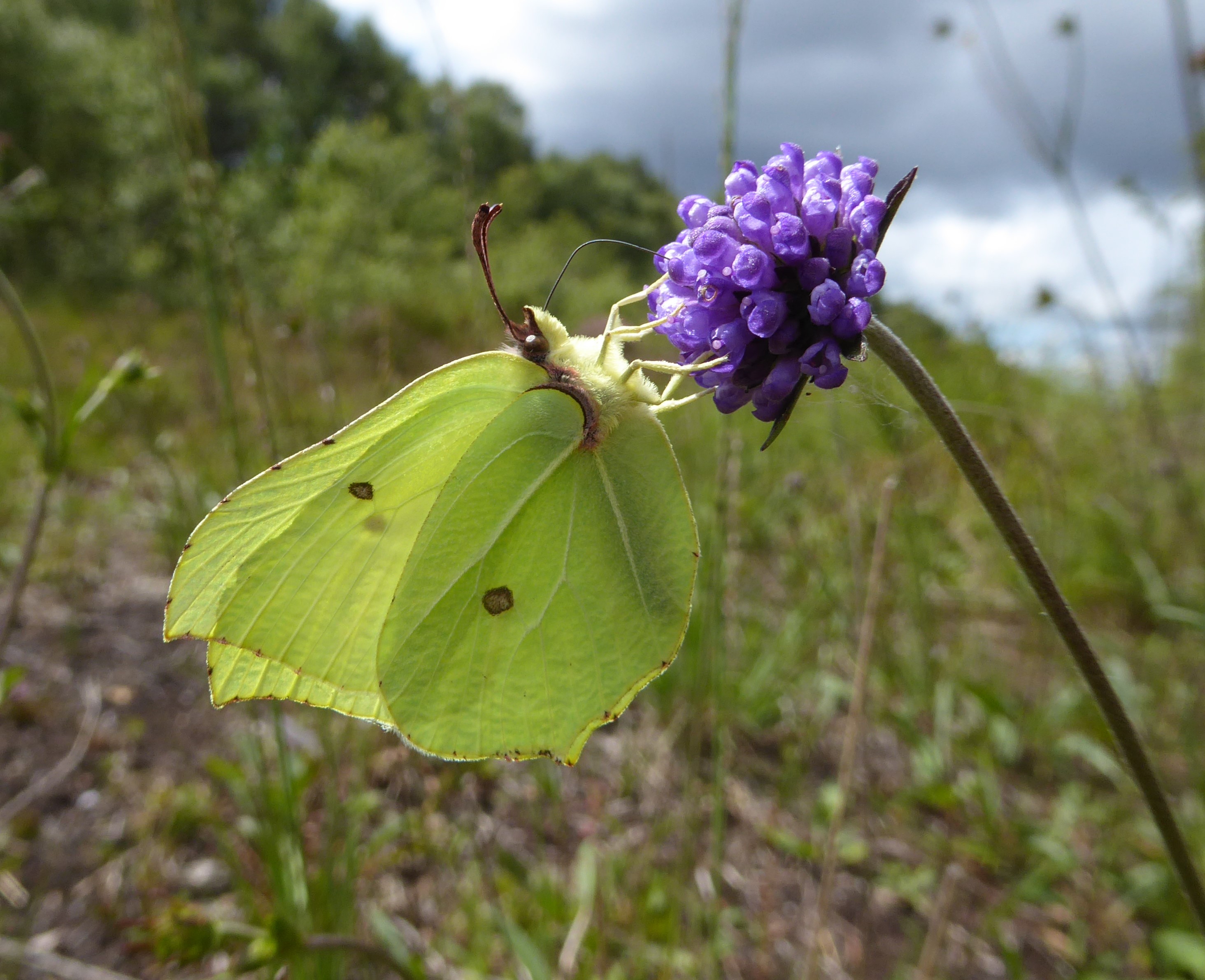 Brimstone (male) feeding on Devil’s-bit Scabious, a very important nectar source where it grows in abundance.
Brimstone (male) feeding on Devil’s-bit Scabious, a very important nectar source where it grows in abundance.
The reward for your care is making your garden part of the solution to the biodiversity crisis. The pleasure of enjoying butterflies, moth, bees, and hoverflies for several months each year visiting your garden to feed and live will be yours. Your garden will be a resource for insects that need food and a home to breed. You might invite your neighbours to visit your garden to see the glories of handsome butterflies on your blooms, and this might spark their enthusiasm for nature. A garden should be more than a collection of plants. It can make a difference, especially when part of a community of caring for our wild creatures. A garden that is valuable for butterflies is a home for hundreds of other insect species. You might recognise individual butterflies, perhaps by untypical colouring or a distinctive nick out of a wing. You will notice different preferences with some species choosing different flowers to others or switching their inclination when another species of flower comes into bloom. Some butterflies and moths will feel so much at home they will pass the winter with you, in your shed, attic or even in a room in your house, blurring the distinction between house and garden.
Start your planning for the coming months now and prioritise the native plants that grow in your area. For more information about habitat creation, see our gardening leaflet:
https://butterflyconservation.ie/wp/wp-content/uploads/2017/12/BCI-Garden-leaflet.pdf
* The Collins Flower Guide (Streeter et al. 2010) state that Field Forget-me-not an archaeophyte (introduced pre-1500), while Rollings and Goulson and http://www.wildflowersofireland.net/ describes it as native.
References
Gaston, K.J., Warren, P.H., Thompson, K. & Smith, R.M. (2005) Urban domestic gardens (IV): the extent of the resource and its associated features. Biodiversity and Conservation, 14, 3327–3349.
Garbuzov M, Ratnieks FLW (2014a) Listmania: the strengths and weaknesses of lists of garden plants to help pollinators. Bioscience 64:1019–1026.
Rollings, R. & Goulson, D. 2019, “Quantifying the attractiveness of garden flowers for pollinators”, Journal of insect conservation, vol. 23, no. 5-6, pp. 803-817.
Russo, L., Fitzpatrick, Ú., Larkin, M.,Mullen, S., Power, E., Stanley, D., White, C., O’Rourke, A., &Stout, J. C. (2022). Conserving diversity in Irish plant–pollinator networks. Ecology and Evolution, 12, e9347. https://doi.org/10.1002/ece3.9347
Salisbury, A., Armitage, J., Bostock, H., Perry, J., Tatchell, M., Thompson, K. & Diamond, S. 2015, “EDITOR’S CHOICE: Enhancing gardens as habitats for flower‐visiting aerial insects (pollinators): should we plant native or exotic species?”, The Journal of applied ecology, vol. 52, no. 5, pp. 1156-1164.
Websites
https://www.bumblebeeconservation.org/gardeningadvice/ Bumblebee Conservation Trust
https://www.rhs.org.uk/science/pdf/conservation-and-biodiversity/wildlife/plants-for-pollinators-wildflowers.pdf) Royal Horticultural Society
https://xerces.org/pollinator-conservation/pollinator-friendly-plant-lists Xerces Society
Species Focus: Common Blue Polyommatus icarus ssp. mariscolore
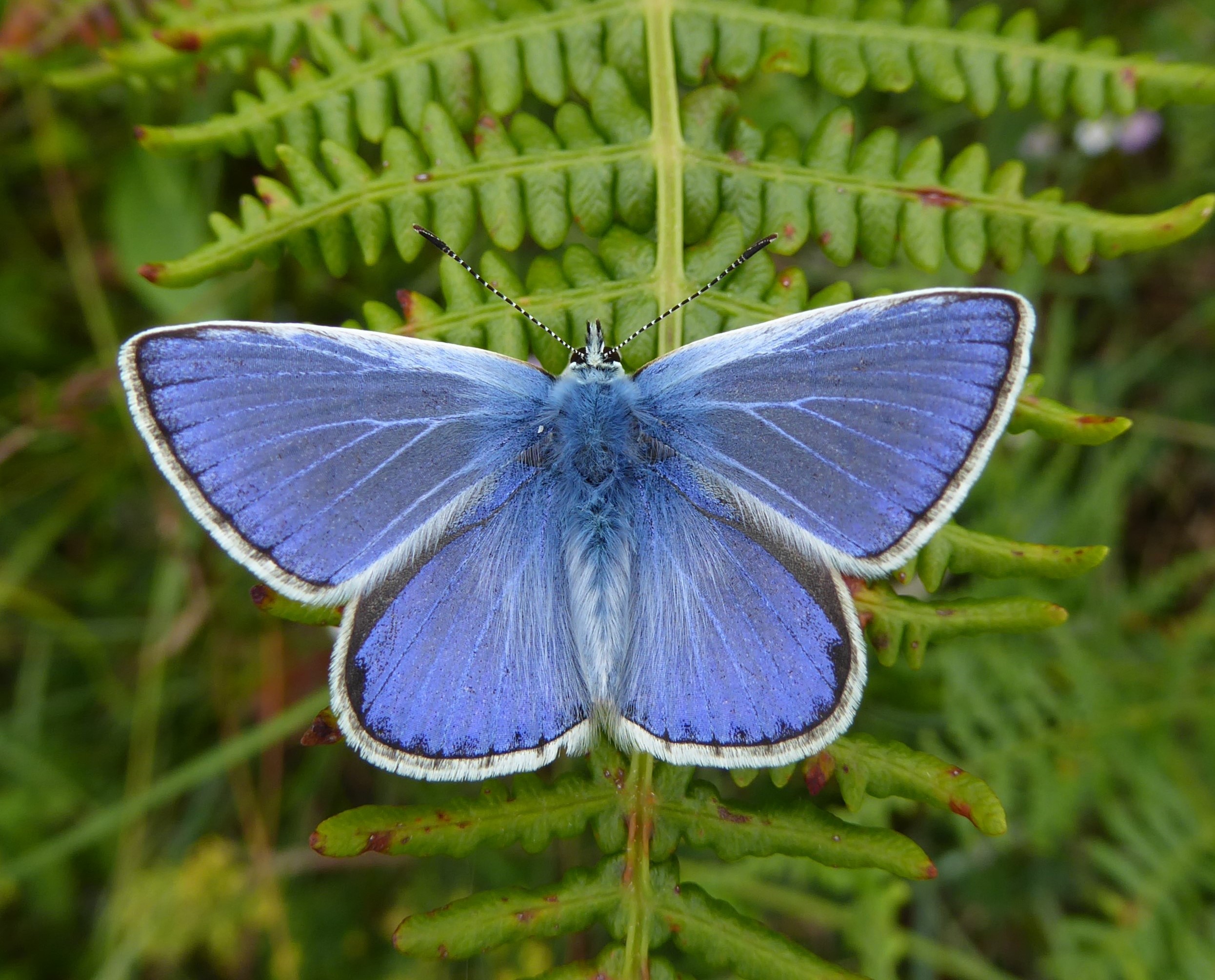 Common Blue, male.
Common Blue, male.
The Common Blue is Ireland’s most widely distributed blue butterfly. It is one of our best distributed butterfly species, being found throughout Ireland. This article relies on information from The Irish Butterfly Book (Harding, 2021). The article also examines why the Common Blue is so successful.
DESCRIPTION: Male Common Blues have stunning clear blue uppersides with a black edging fringed by white. The wingspan is 29-38mm and males are notably larger than females. Females show orange crescent markings at the edges of the upperside of the forewings and hindwings. The Common Blues found in Ireland appear to conform to two main colour forms and intermediates between these. One of these colour forms, known as mariscolore, has been given subspecies rank but this may be an unstable colour form indicative of ecological conditions rather than indicative of genetic differences.
This beautiful mariscolore form/subspecies is larger with more pointed forewings. The uppersides are brighter blue in the male. The mariscolore female has extensive powder blue colouring and well-developed orange lunules on the upper surfaces of the forewings and hindwings. The other main colour form is known by most authors as the subspecies icarus. Subspecies icarus has more rounded wing-tips and the females have mainly brown uppersides. This subspecies is less common in Ireland than in Britain. There are intermediate forms where females have brown uppersides with a strong dusting of blue scales, particularly in the basal area of the wings. In England and Wales, the Common Blue is represented by the subspecies icarus. In Scotland, females are often blue and are referred to as mariscolore. An important question mark against subspecies status is that blue and brown females occur together in many areas in the Irish midlands and west, which suggests these may be colour forms rather than distinct subspecies. A requirement for a subspecies is that populations that differ in one or more traits live apart from other populations of their species.
The undersides are more consistent in colour; the ground colour is typically grey in the male and brown in the female. Both sexes have black centred white markings and orange chevrons around the edges of the hindwings merging into a band on the forewing underside in the female. The male shows less or no orange on the forewing underside.
Among Ireland’s three blues, only the Common Blue has orange markings; this helps to distinguish it particularly from the Holly Blue, which is usually seen around shrubs and not on grassland like the Common Blue. The wide geographical distribution of this species and variable uppersides suggest that the species shows considerable ecological adaptability. The extent of bluish suffusion in the female appears greater further west and north in Ireland; this may correlate positively with cooler, overcast and/or damper conditions during the larval and pupal stages (Tolman 2009).
The number of generations is similarly influenced, with at least two large broods and possibly a small third flight in the south and south-east and one main brood in the north, with a smaller second brood at some of the warmest sites. Larvae from a single-brooded Scottish population reared captively in the south of England (where two broods fly every year) retained their single-brooded character but produced brown, not blue females indicating that the colour is controlled by ecological (environmental conditions), not genetic factors (Thomas and Lewington 2014). The fact that the Scottish population did not produce a second generation may be indicative of genetic difference. However, the records received by the Butterfly Conservation Ireland recording scheme from County Donegal in the north-west of Ireland, including the Inishowen peninsula in the far north of the country, show that the Common Blue is double-brooded there.
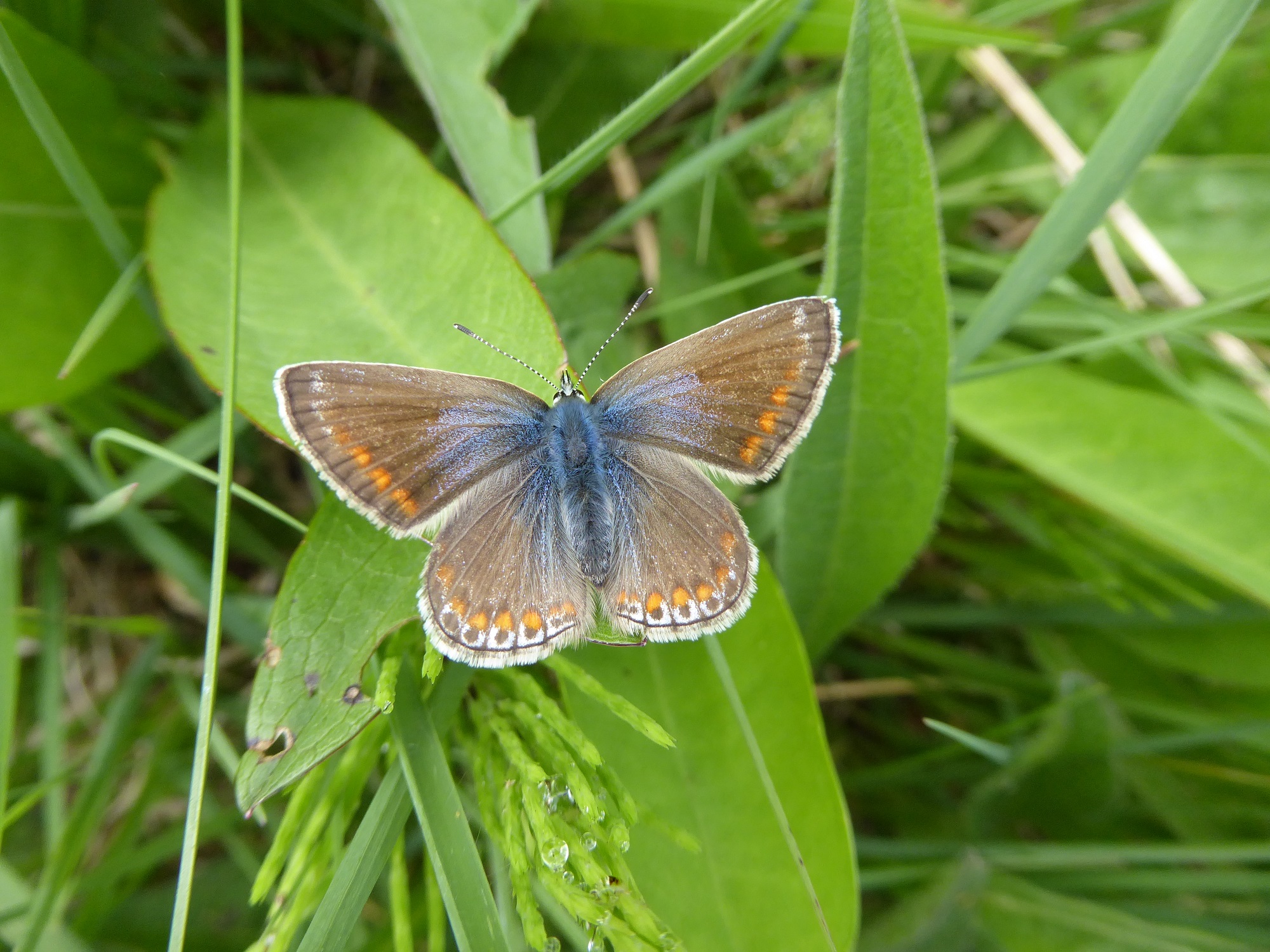 The mainly brown female is commonly found in the east on coastal sites. In Lullybeg, a midlands site in County Kildare, females of the three colour forms have been found.
The mainly brown female is commonly found in the east on coastal sites. In Lullybeg, a midlands site in County Kildare, females of the three colour forms have been found.
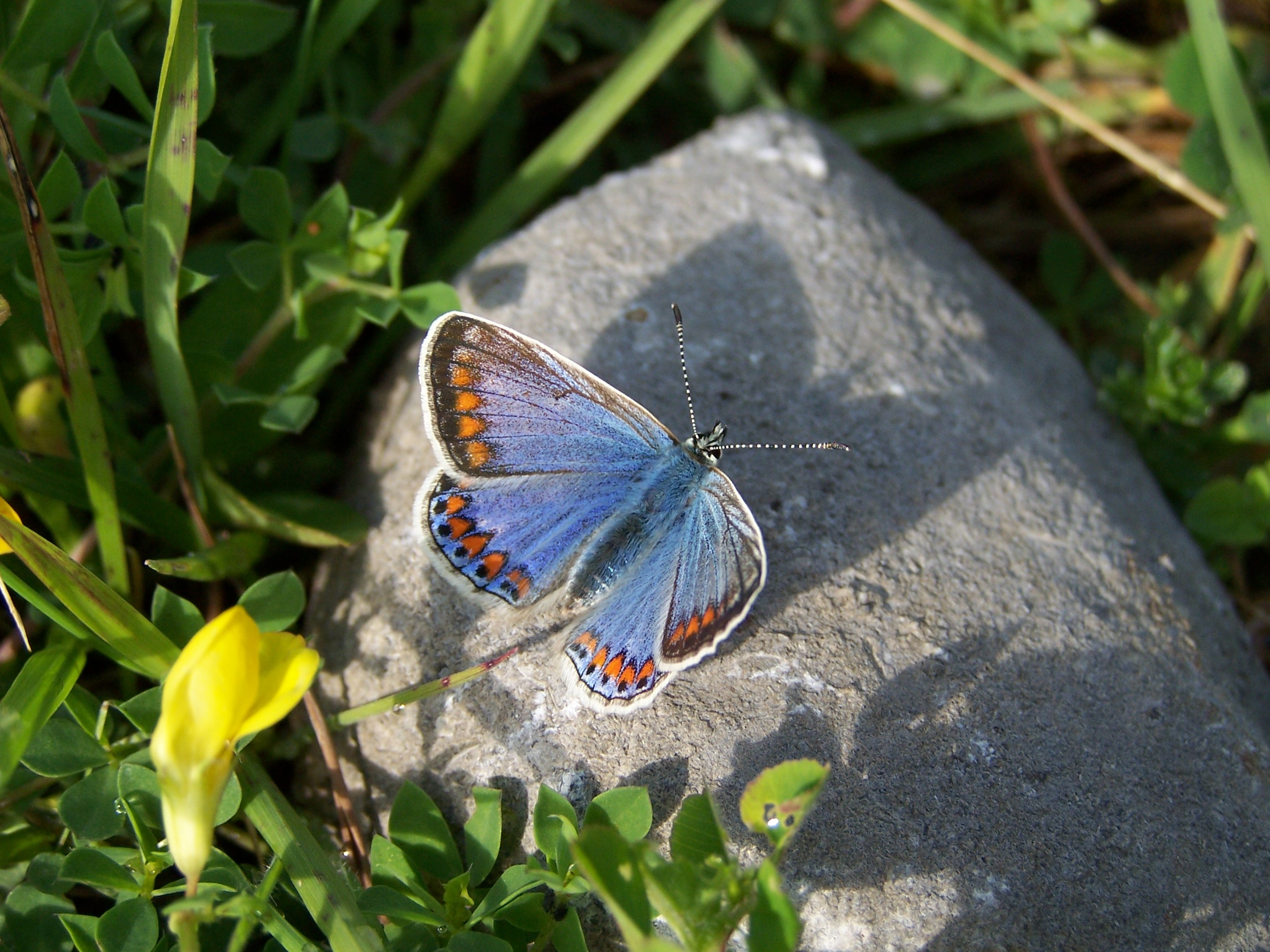 Female Common Blue mariscolore form on Common Bird’s-foot-trefoil, County Clare, May 2008.
Female Common Blue mariscolore form on Common Bird’s-foot-trefoil, County Clare, May 2008.
HABITAT: The Common Blue breeds on any unfertilised grassland containing its main foodplant, even in gardens. It is especially common on poor, well-drained sandy soils, such as sand dunes and rocky outcrops. It is also found on heavier, wetter soils where Common Bird’s–foot-trefoil, the main foodplant, is present. It also breeds on Black Medic Medicago lupulina and Greater Bird’s-foot-trefoil Lotus pedunculatus, a taller plant of wetter grasslands. Well-grazed fields with Common Bird’s-foot-trefoil will also have Common Blues but at a lower density. They are also found in woodland clearings. Despite its rapid flight, the butterfly appears to remain in its habitat. It is sometimes found in abundance in small areas with highly suitable habitat. However, single individuals of both sexes have been observed away from known colonies.
FLIGHT TIMES/BROOD STRUCTURE: In Ireland, the Common Blue emerges from early May depending on the weather and latitude. In Donegal, the butterfly usually begins to fly in June. In Kildare, the first brood is on the wing from mid-May until early July and the second brood flies from late July/early August. It may be found even into early October, although this might represent a small third generation. In some years on highly suitable sites, it flies from May to October with no observable gap, but with lower numbers occurring between the main flight periods.
BEHAVIOUR AND LIFE CYCLE: Females are less conspicuous and less active than males which fly ponderously yet purposefully over grassland containing the larval foodplant to seek a female. Although territorial, males are not as possessive of their patch as the Green Hairstreak or Small Copper. Common Blues will chase other males but lose interest quite quickly, so that it appears that males are only approaching other males to determine whether they are in fact females or not. Males are especially eye-catching in these lightning-fast chases, their electric, Kingfisher blue sparkling in bright sunshine. When the sexes are joined in copulation, the male carries the female on a short nuptial flight.
Females start to lay their eggs about two days after mating. Eggs are pale green at first, but later turn white. The eggs are disc-shaped and c.0.2mm high and are laid in a curious manner. The female walks over the trefoil leaves and flowers ‘drumming’ with her front legs and bending her antennae to taste and smell the foodplant ascertaining its suitability. She often tests the leaves with her proboscis. When she is satisfied with the quality of the plant, egg laying follows. She curves her abdomen to contact the upper or underside of the leaves, stalks and flowers of Common Bird’s-foot-trefoil, or the other foodplants she uses and even blades of grass. The eggs are easy to find on well-populated sites. A single egg (sometimes two) is deposited very carefully. The female Common Blue punctuates her egg laying by taking nectar on flowers such as Common Bird’s-foot-trefoil and dandelion. Females become tattered and duller during egg-laying and have then been confused with the rarer Small Blue.
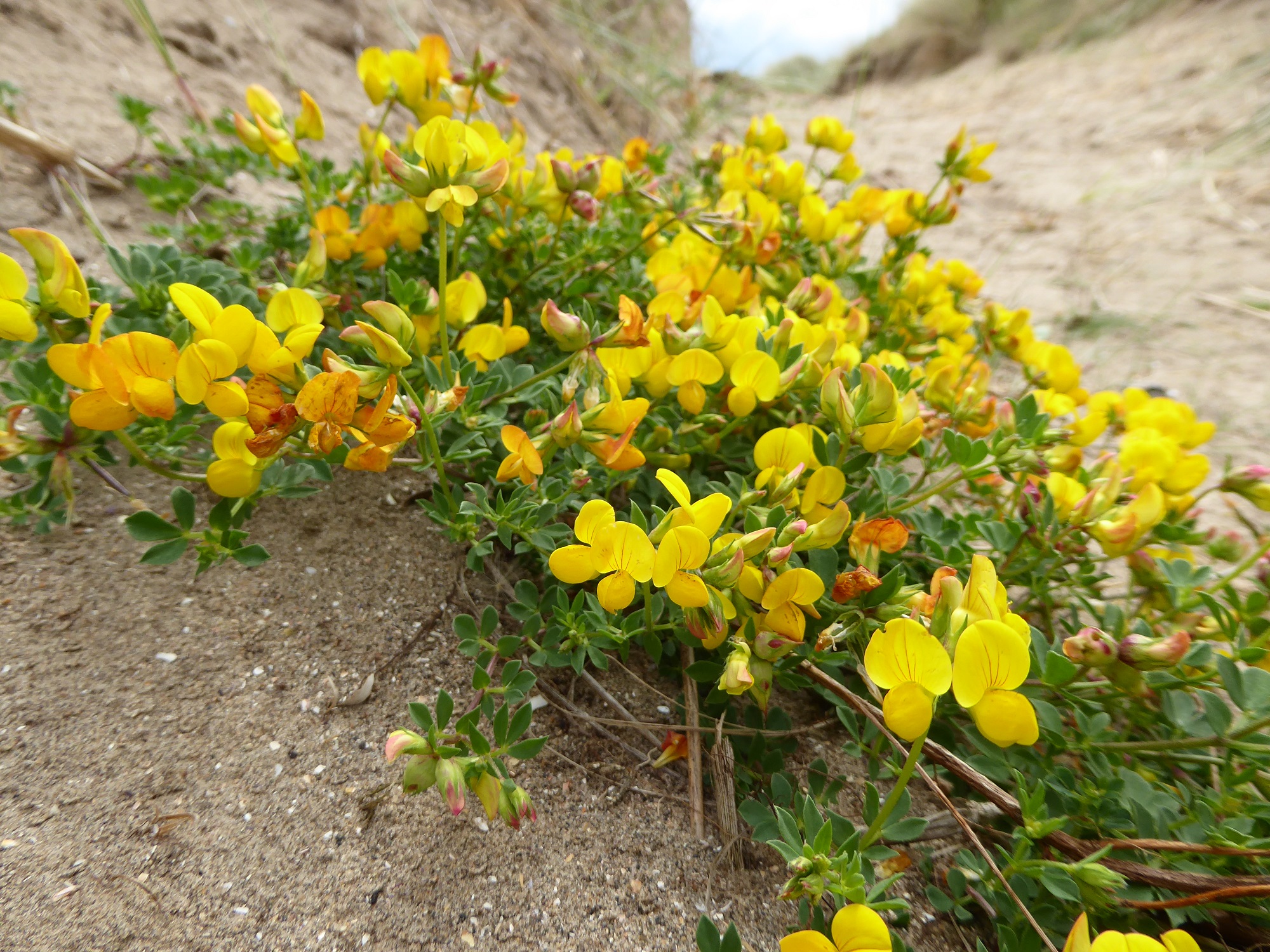 Common Bird’s-foot-trefoil.
Common Bird’s-foot-trefoil.
Eggs obtained in 1997 were laid on June 9th, 10th and 11th and hatched after about nine days. The first instar larvae are very small, and even after a week of feeding, they show little increase in size. It is light green and its most obvious features are its black head and its slug-like appearance. The caterpillar eats the leaves of its foodplant by stripping the top layer of the leaf but leaving the basic leaf structure intact. Feeding damage appears as a pale grey half-moon in an otherwise lush leaf. By early July larvae had doubled in size to 4mm and by mid-July, it reached the fifth (final instar) and measured about 11mm in length and 4mm in width. The larvae are now green with a thin yellow lateral stripe evident from the second or third segment onwards (from head to tail end). A deep green dorsal line is also evident. At this point, the caterpillar reduces the leaf to shreds. There are five instars. The larvae studied in captivity lasted around six weeks and pupated simultaneously in late July.
The pupa is olive green and rounded at both ends. They range in size from 8-9mm, but the most apparent difference between the male and female pupa lies in the width that ranges from 3mm in the female to 5mm in the male. The male in my study emerged on August 3rd – a pupal stage lasting thirteen days. The female emerged a day later. The newly emerged female was bred in dry conditions from a pair from Bull Island, County Dublin and was the brown form. This female was also small like her counterparts across the Irish Sea. Her mother was the mariscolore form. This suggests the influence of temperature/moisture.
An egg that was laid by a mariscolore female obtained on July 12th, 2013, at the foot of Mt. Nephin, County Mayo, was reared in County Meath. It produced a mariscolore female. The life cycle from oviposition to adult emergence lasted 52 days (7.4 weeks). The butterfly emerged on September 2nd (this is one day longer than the examples from Dublin). July 2013 was warm and sunny with many dry days while August was generally dry and warm but with below-average sunshine. The duller conditions during August and the greater decline in daylight hours during the larval and pupal stages may have contributed to the production of the blue form of the female that originated in Mayo, but more study is needed to interpret these results. The Common Blue over-winters in the larval stage.
In years when drought occurs in June/July, the butterflies emerging in late summer are much reduced in size. In these conditions, large numbers congregate to take nectar on plants growing in damp places; I found around 100 Common Blues on a few Purple-loosestrife plants Lythrum salicaria on marshy ground beside the sand dunes at Old Bawn, County Wexford (T 215 462) during a hot, dry spell. The ability to produce butterflies under drought conditions is a testament to this species’ adaptability, especially because the main foodplants greatly favour the thinnest, well-drained soils which suffer the greatest moisture loss. However persistent drought is likely to lead to a lower number of Common Blues flying the following spring.
OVERSEAS RANGE AND IRISH DISTRIBUTION: It is the most successful of our lycaenids and occurs throughout Europe and North Africa, the Middle East and temperate Asia.
The Common Blue is well distributed throughout Ireland except on cold and wet soils in counties Antrim, Derry/Londonderry and Tyrone. Although Common Bird’s-foot-trefoil, the main larval foodplant is often associated with calcareous grassland, the plant and the butterfly occur on granite zones in the Mourne and Wicklow Mountains. The Common Blue is especially abundant in coastal regions.
STATUS AND CONSERVATION: Its status on the Red List of Irish Butterflies 2010 is Least Concern. The IBMS data indicates that its population trend over the period 2008-2020 was ‘Uncertain’ (Judge and Lysaght 2021). The change in its abundance from year to year probably means that a longer time period is needed to evaluate the butterfly effectively. Avoiding the addition of fertiliser to grasslands is needed to preserve the species, as its foodplants are not aggressive and are swamped by fertilised grass. Disturbance of grasslands by machinery or cattle on heavier soils may help to maintain the butterfly.
WHY IS THE COMMON BLUE SO SUCCESSFUL?
The Common Blue is the most widely distributed butterfly in Europe. It is distributed throughout the whole of Europe and the palearctic outside of Europe, namely North Africa, Turkey, the Middle East and temperate Asia. In Europe, it occurs throughout the continent and is absent only from a few Mediterranean islands where it is replaced by a similar-looking, related species, Southern Blue Polyommatus celina (Dinca et al.2011). Why is it such a success?
The Common Blue has extraordinary ecological adaptability, enabling it to live far north of the Arctic Circle and in the sub-tropical climate of North Africa and everywhere in between.
Why is this? The adult butterfly can if it needs to, travel long distances to find suitable habitat. Furthermore, although it cannot survive the winter as an adult butterfly, it can live for 30 days or perhaps longer, giving it time to move and locate the required resources. Its mobility makes it able to find new habitats when these arise.
Furthermore, it has a highly varied brood structure. Its brood structure varies according to latitude and altitude and probably according to seasonal conditions. At higher latitudes, such as Lapland and Scotland, it has one brood a year (see above). In Sierra Nevada (Andalucía, south-east Spain), above 2700m, it has just one generation. In Southern England, it produces two to three generations per year. At low altitudes in Southern Europe, it flies in three generations, from late March to early November. Further south, in the Canary Islands, it is probably continuously brooded, with no over-wintering larvae (Tolman, 2009). This ability to adapt to a wide range of altitudinal and climatic conditions contributes to its enormous range.
Its ability to exploit a vast number of larval foodplants also contributes to its success. It uses many pea family plants (Fabaceae). These occur widely, especially Common Bird’s-foot-trefoil and Black Medic. Some plants are sensitive to soil type which limits some butterfly species to areas where either alkaline or acidic soils exist. However, the Common Blue’s lengthy larval foodplant usage and the ability of some of these plants to accept alkaline, acidic and neutral soils means the butterfly is largely unrestricted by soil type. Thus, it happily lives where the surface geology is granite (where there are usually acidic soils) such as in the Wicklow Mountains and on calcareous surfaces, such as on the machair grassland in Mayo, Sligo and Donegal.
The association of the caterpillar with ants lend it some protection from predators. A number of ant species, that also occur widely, such as Myrmica sabuleti (a red ant) and Yellow Field Ant Lasius flavus tend the larvae for their sugar secretions, the larvae benefiting from the ant’s protection in the event of an assault.
The butterfly is good at coping with adverse climatic and weather conditions. This can be seen in the remarkably varied size and wing colour. As stated earlier, in years when it is hot and dry, larvae will pupate before they reach the size that is attainable under favourable weather conditions. The resulting adults are smaller than they would be if the foodplant quality was high, but they are still capable of reaching the reproductive stage. In hot summers, I have observed females choosing to lay on plants that are shaded because these plants were in better condition than the fully unshaded plants usually selected in Ireland. In cool, damp years in more northerly areas of Europe, the females are ‘bluer’ than those that develop when the weather in these areas is sunnier and drier. The appearance of large numbers of blue females indicates how well the species can develop even in duller, wetter years. We get plenty of them!
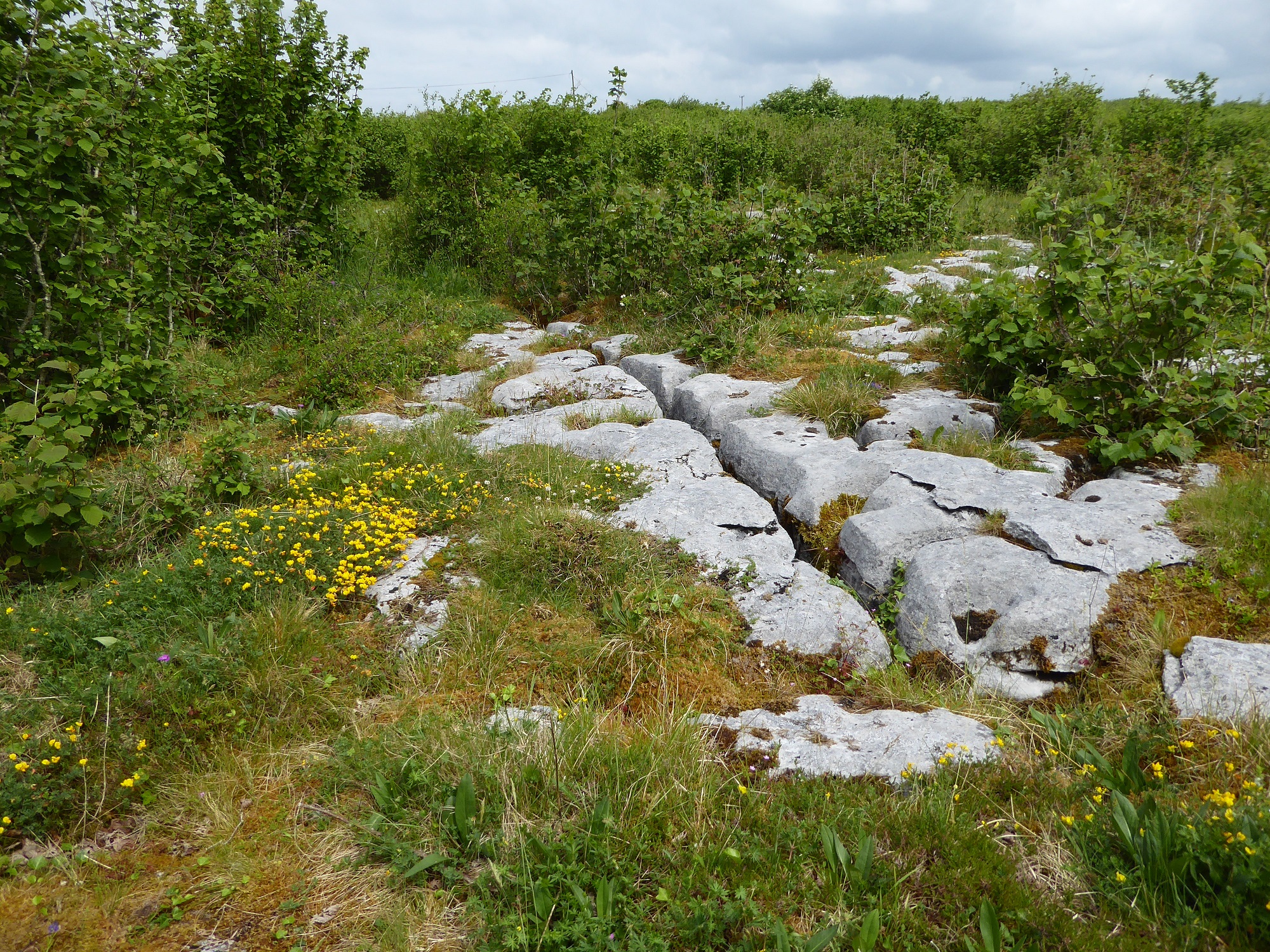 A typical breeding area of the Common Blue in the Burren, Co. Clare.
A typical breeding area of the Common Blue in the Burren, Co. Clare.
References
DINCĂ, V., DAPPORTO, L. and VILA, R. (2011), A combined genetic-morphometric analysis unravels the complex biogeographical history of Polyommatus icarus and Polyommatus celina Common Blue butterflies. Molecular Ecology, 20: 3921-3935. https://doi.org/10.1111/j.1365-294X.2011.05223.x
Thomas, J. and Lewington, R. (2014) The Butterflies of Britain and Ireland. (Revised edition) British Wildlife Publishing, Dorset.
Tolman, T. and Lewington, R. (2009) Collins Butterfly Guide: The Most Complete Field Guide to the Butterflies of Britain and Europe. Harper Collins, London.
How important is the Burren for Ireland’s Moths?
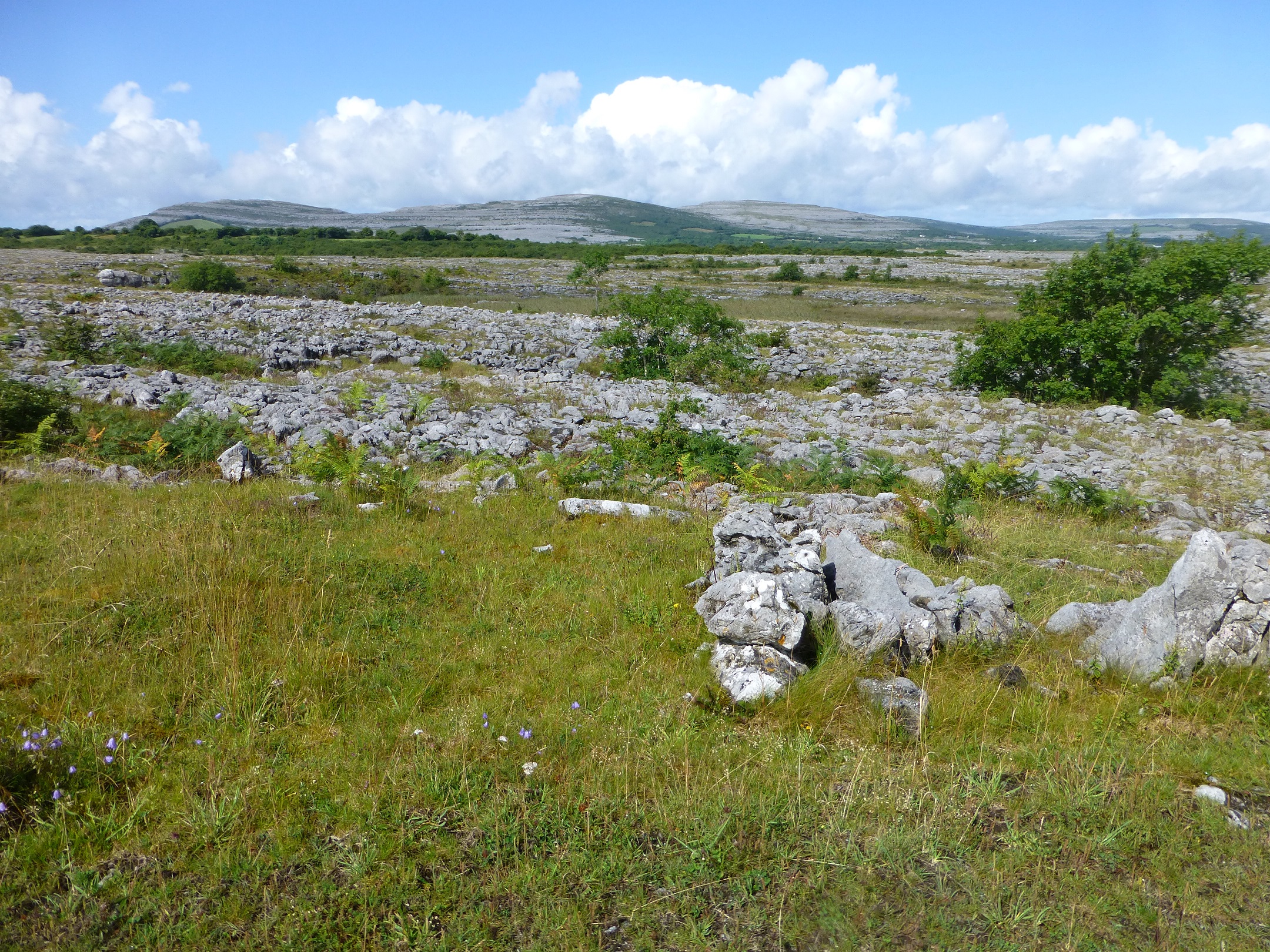 The Burren looking west from Kiltacky Trackway.
The Burren looking west from Kiltacky Trackway.
The Burren, the area of exposed carboniferous limestone located in north County Clare and south County Galway, has for centuries been known for its remarkable flora. Since at least the nineteenth-century naturalists from various parts of Ireland and Britain journeyed to the region, especially in spring to see the rarities and the commoner species which grow there in breath-taking abundance. Hillsides sheeted in sunny-looking Mountain Avens Dryas octopetala, an Arctic-alpine shrub that grows throughout the bright grey Burren limestones, is quite a tonic. The western Burren, within sight of the sea, hosts vistas of golden Hoary Rockrose Helianthemum oelandicum ssp. piloselloides, blooming gloriously in May, their heads nodding synchronously in the onshore breeze. Spring Gentian Gentiana verna is a less conspicuous but startlingly beautiful gem that you want to kneel beside to admire the indescribable depth of its colour. Rarities like the Dense-flowered Orchid Neotinea maculate will be found less easily unless you are lucky enough to be familiar with its localities.
The flora is such a highlight that may have obscured the region’s importance for its animals. It is surprising, for example, that the Pearl-bordered Fritillary butterfly remained unknown in Ireland until it was discovered in the Burren in June 1922. The Burren Green moth, quite a large moth, was not found there until 1949, despite being abundant throughout much of the Burren region. This moth is not found anywhere else in Ireland or Britain. Another remarkable find, in 1991, is the Irish Annulet Gnophos dumetata hibernica. This moth occurs nowhere else in the world, and even in the Burren it is highly localised.
Some of Ireland’s rarities do not occur in the Burren. The White Prominent Leucondonta bicoloria occurs in birch woods in south-west Kerry, and the Sandhill Rustic Luperina nickerlii knilli is found on the south coast of the Dingle Peninsula, while other rarities occur elsewhere. However, aside from the rare species that have a niche in ‘out of the way’ places, how important for Ireland’s moths is the Burren?
Important answers to this question were given at the Burren Invertebrate Conference organised by the National Parks and Wildlife Service in August 2022, which I was privileged to attend. Dave Allen, one of Ireland’s leading moth experts, delivered a brilliant presentation on which most of the following is based. Ireland has about 1,567 species of moth, 967 of which occur in the Burren – or 61.7%. 940 of the Irish species are micro-moths (small moths), and 513 of these occur in the Burren (54.6%). 422 of the 582 macro-moth species (larger moths) occur in the Burren (72.5%). This highlights gaps in recording, as undoubtedly the Burren has an even higher proportion of the Irish micro-moths than of macro-moth species. Of the 66 macro-moths that are red-listed or rated ‘Near Threatened’ 32 of these occur in the Burren, 48% of the total.
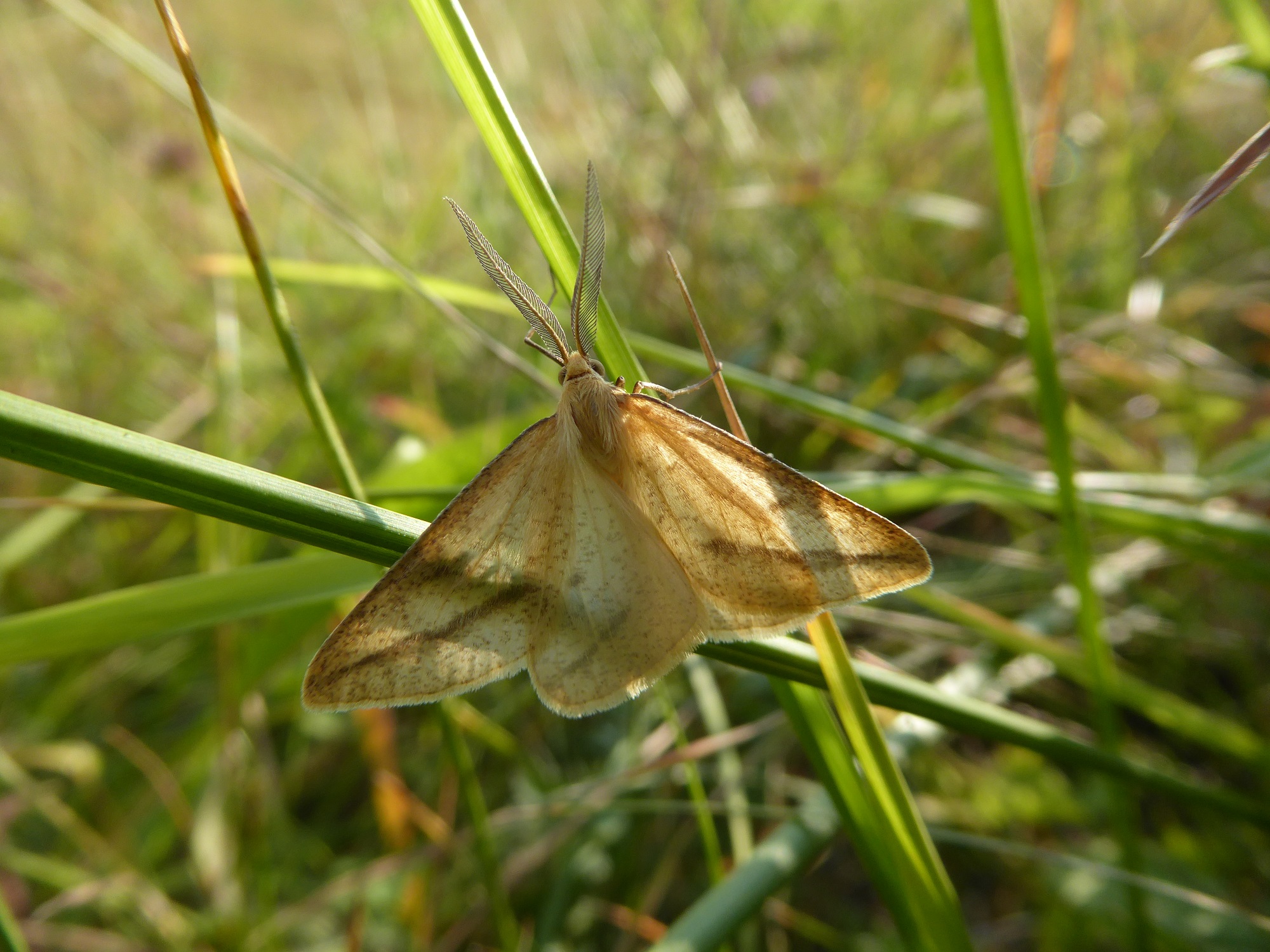 Straw Belle moth.
Straw Belle moth.
There are several species found elsewhere in Ireland that have the Burren as their headquarters. These include the Royal Mantle Catarhoe cuculata which breeds on Bedstraws Galium spp. Straw Belle Aspitates gilvaria which occurs in the form burrenensis, showing a deeper straw colour on its forewings than on British examples, is headquartered in the Burren. This moth flies by day and night, and has a range of larval foodplants, such as Common Bird’s-foot-trefoil Lotus corniculatus, Fairy Flax Linum catharticum Black Medic Medicago lupulina and Wild Thyme Thymus drucei. The attractive Dew Moth Setina irrorella, whose larva feeds on lichen/algae on rock is very Burren centric. The Brown Scallop Philereme vetulata which uses Purging Buckthorn Rhamnus cathartica as its foodplant has a wider distribution. Dark Umber Philereme transversata which also uses Purging Buckthorn occurs elsewhere in Ireland but is commoner in the Burren, where the foodplant is more abundant.
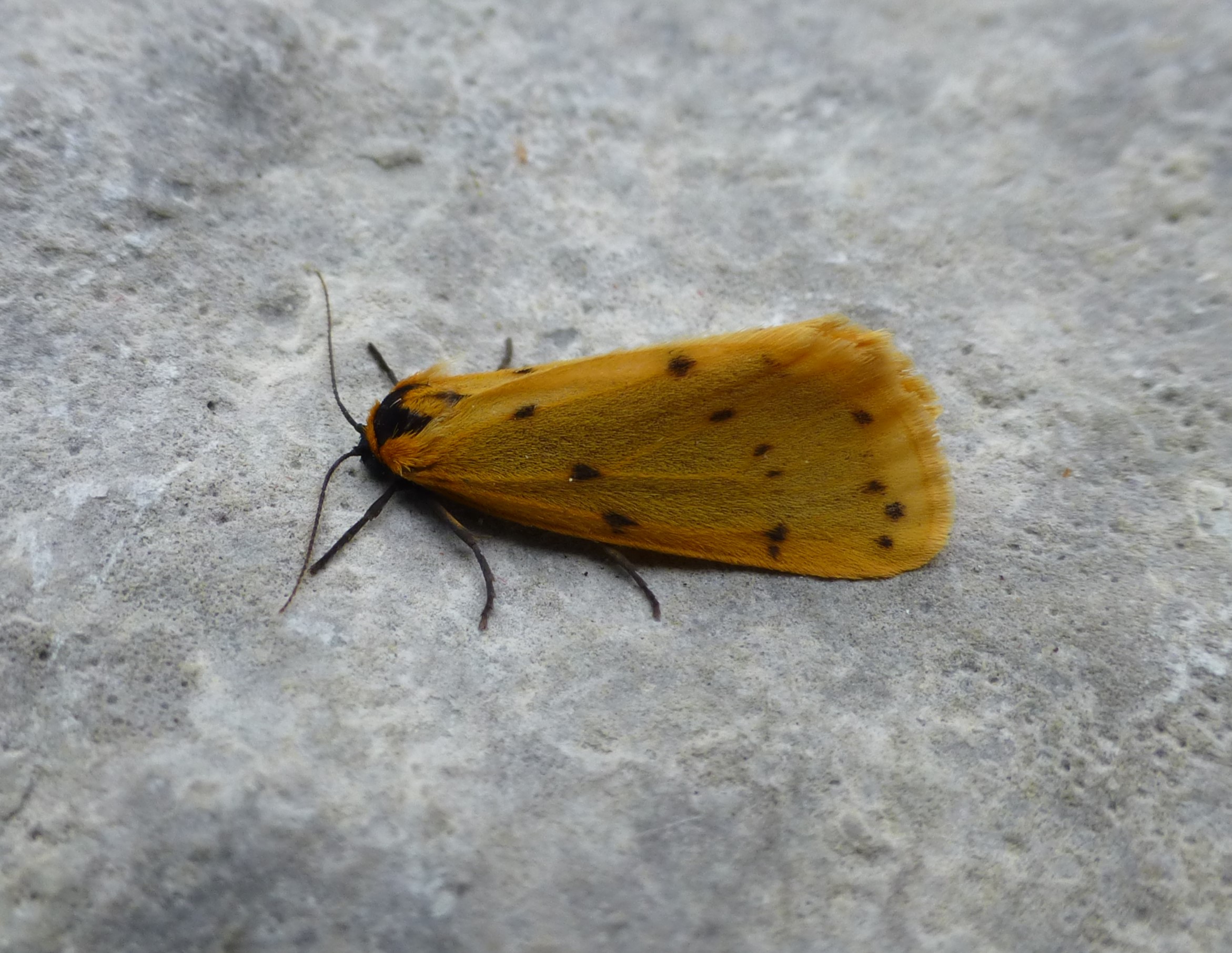 Dew Moth (Dew Footman) is common in the Burren. The larva is below.
Dew Moth (Dew Footman) is common in the Burren. The larva is below.
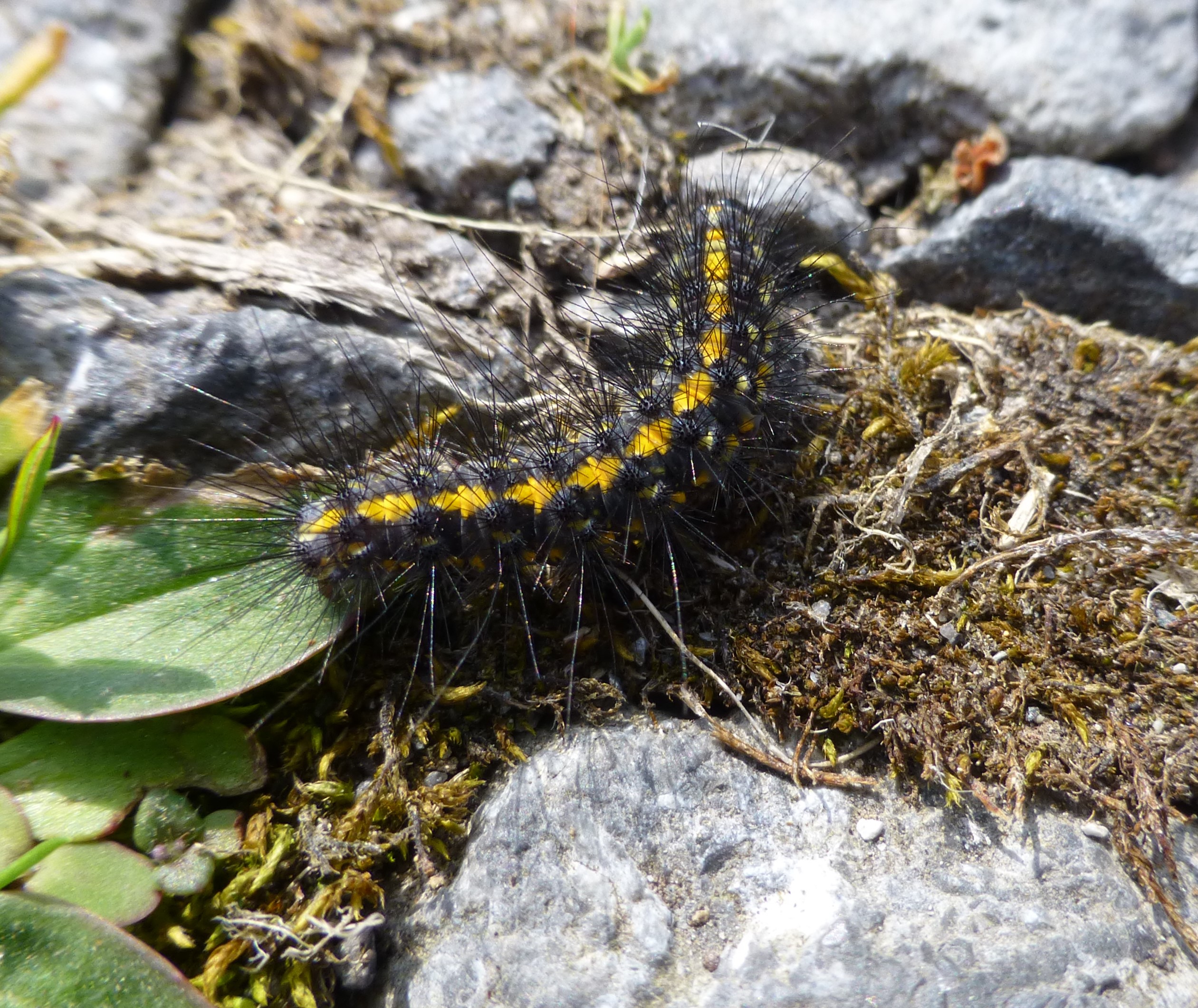
The Tissue Triphosa dubitata is another Purging Buckthorn specialist is found right across Ireland but the concentration of the species is in the Burren with staggering numbers of the larvae found on Purging Buckthorn in the Burren compared with elsewhere. This moth behaves like the Brimstone butterfly in that it over-winters as an adult moth and breeds in spring. It flies in one generation a year, like the Brimstone. Unlike the Brimstone which over-winters among Common Ivy, Common Holly and dense green vegetation, the Tissue chooses caves, disused buildings, outhouses and bunkers, like the Small Tortoiseshell butterfly.
There are mysterious circumstances associated with several moths occurring in the Burren. These species breed on plants that are widespread outside the Burren, yet they prefer the Burren to apparently suitable habitat elsewhere. For example, there are several micro-moths (small species) that are frequent in the Burren but rare outside the region.
The micro-moth Paracrania chrysolepidella – one of the eriocraniid (family name) leaf miners (the caterpillars of leaf-mining moths live and feed within leaves and can be identified by experts who know them by the streaks left in their feeding trails) of Common Hazel Corylus avellana, is rare in Ireland and Great Britain. In Ireland, it occurs only in the Burren. Their occurrence in the Burren might be due to the presence of micronutrients or the micro-climate in the region. Heath Rivulet Perizoma minorata is a macro-moth whose larva feeds on the developing seed capsules and flowers of Eyebrights Euphrasia spp., again centred on the Burren. The National Biodiversity Data Centre map only shows records from the Burren. Stigmella spinosissimae, a leaf-miner on Burnet Rose Rosa spinosissima is so uncommon there are hardly any images of it.
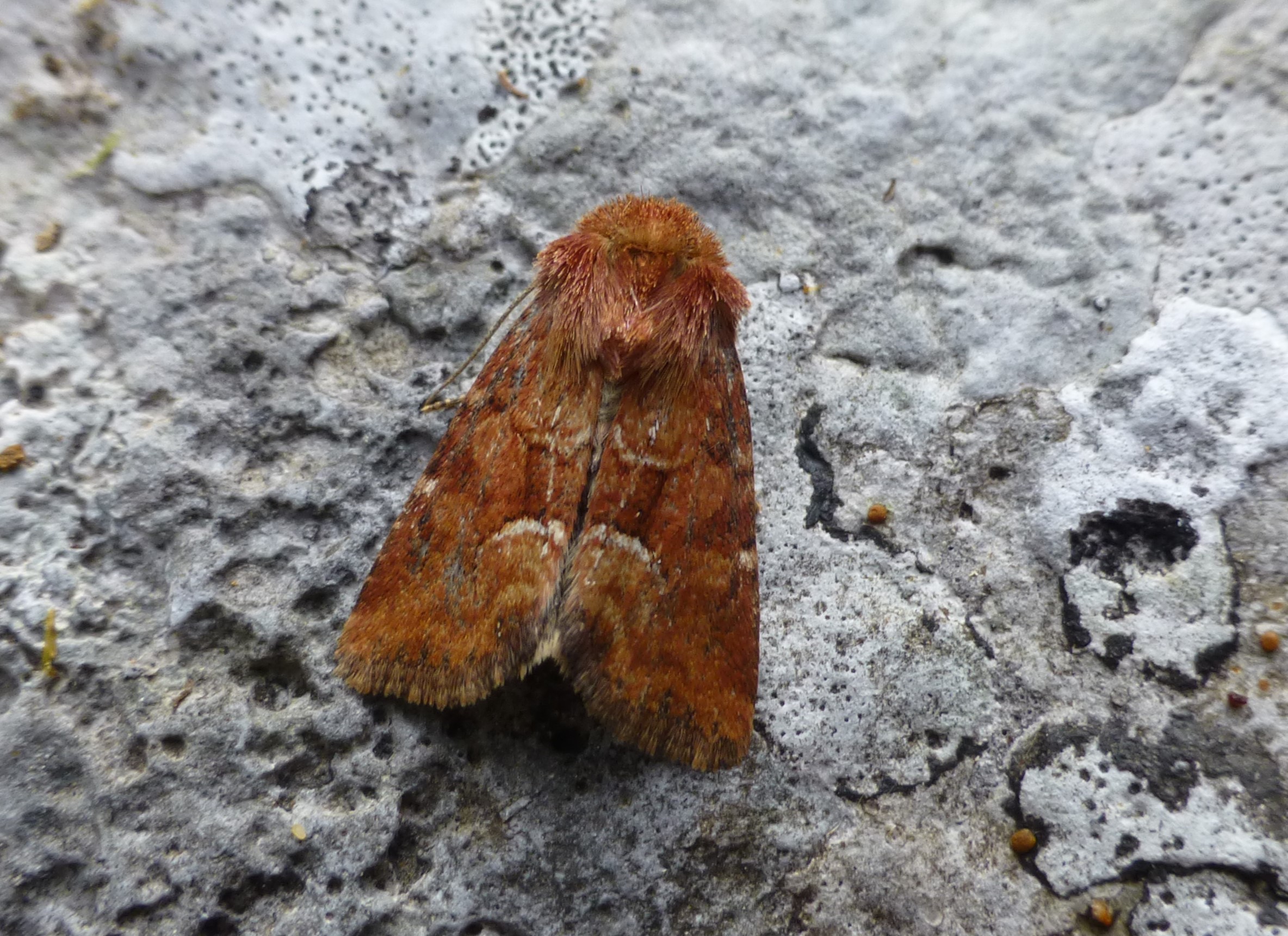 Least Minor, from Parknabinnia, County Clare.
Least Minor, from Parknabinnia, County Clare.
The Least Minor Photedes captiuncula is a day-flying macro-moth that breeds on Glaucous Sedge Carex flacca. The plant occurs widely in Ireland, but the moth is confined, in these islands, to limestone grassland in the north-west of England (Cumbria) and the Burren. A good place to look for it in June is the lower hay meadow in the Burren National Park, at R 30821 94890. Agonopterix capreolella is a grey-brown micro-moth that feeds on Burnet Saxifrage Pimpinella saxifrage. It is very rare in Britain and Ireland. Mere’s Pug Eupithecia intricata hibernica (a macro-moth) has been recorded in the north of the County Clare Burren. It is very rare in Britain and Ireland. It feeds on prostrate Juniper Juniperus communis draped over limestone. This list is just a sample of Burren-centric moths.
The presence of a moth’s foodplants in the Burren is a key factor in explaining why some species occur there. The plant Mountain Everlasting Antennaria dioica has an assemblage of moths that feed on it in the Burren, including three critical species: Irish Plume Platyptilia tesseradactyla (micro-moth) is not found in Britain, but is found in parts of Europe. In Ireland, outside of the Burren, is found in west Fermanagh (re-found in 2022 – netted in daytime). Coleophora pappiferella (micro-moth) is very hard to identify; one needs to dissect adults and find their cases (constructed by the caterpillars for protection). It is found in the Burren, the same site in west Fermanagh and one site in Galway. It has a very restricted distribution in Great Britain.
But is it really restricted, or are people not looking for it, not knowing what to look for, not recognising what they have found or not dissecting it when they find it? Scrobipalpa murinella has the same distribution in west Fermanagh and one old record from the Burren. Incredibly rare in Ireland and Great Britain, but also highly cryptic and again adults need dissection. But if you compare the distribution of these three species to that of the foodplant, Mountain Everlasting Antennaria dioica, it does not make sense because the plant is much more widespread. The factors that influence this restricted distribution are unknown but climate, possibly altitude and the lack of proper determination/recording may be explanatory. Bare rock/limestone probably has an influence, both in terms of chemical signature and as a heat source, but there is almost no research done on micro-moths in comparison to butterflies, so their ecology is not so well known.
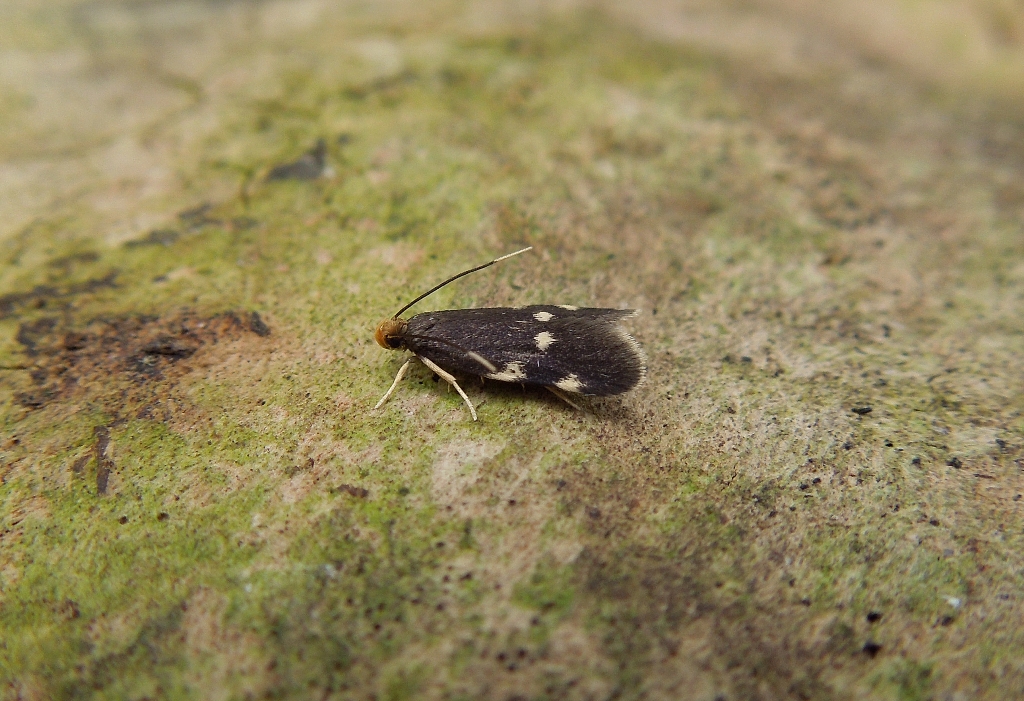 Telecrysis tripuncta (above) is currently known only from the Burren. The Scarce Crimson and Gold (below) is rare in Ireland but abundant in the Burren.
Telecrysis tripuncta (above) is currently known only from the Burren. The Scarce Crimson and Gold (below) is rare in Ireland but abundant in the Burren.
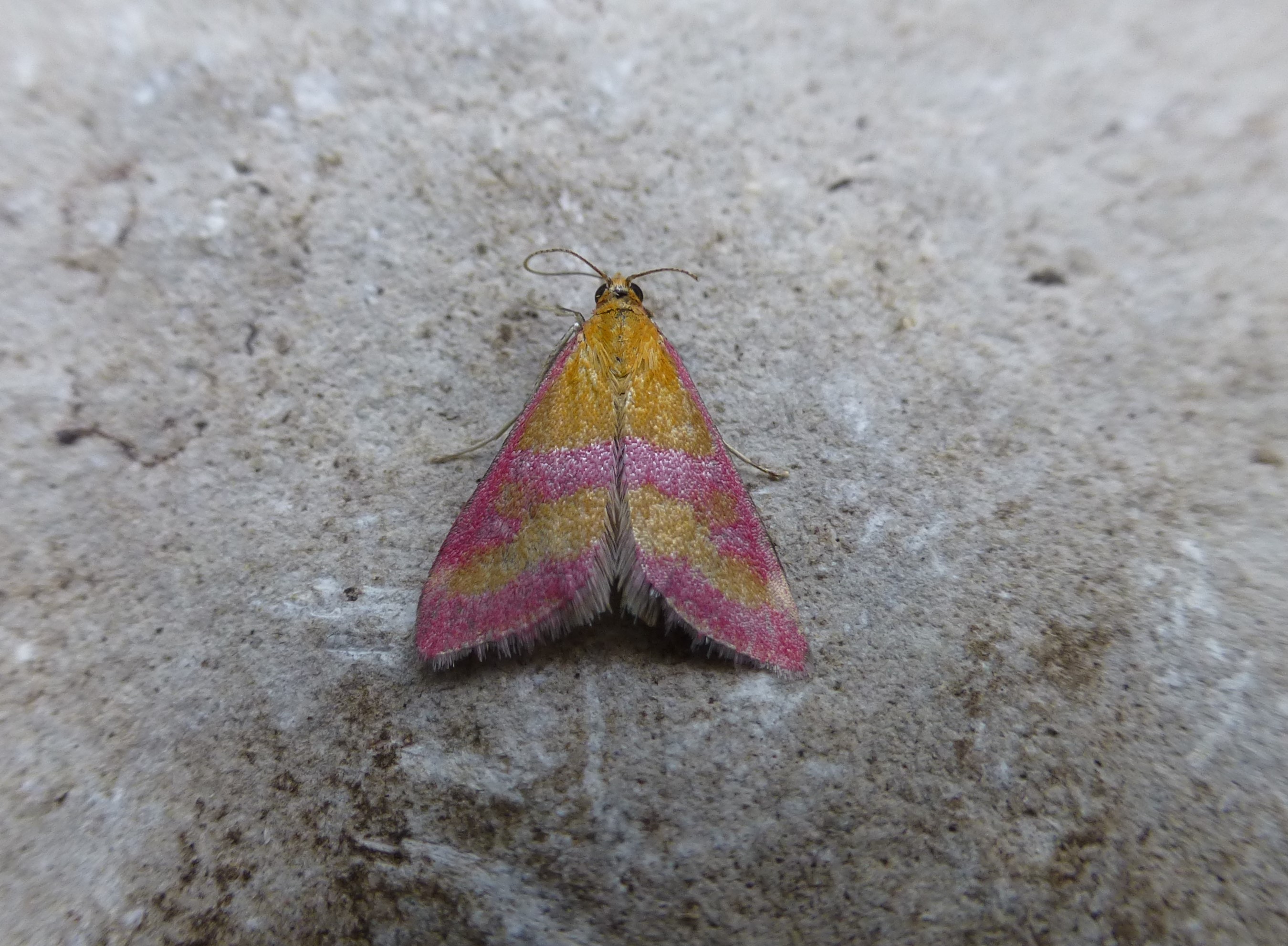
Bramble Rubus fructicosus agg. occurs throughout Ireland but it harbours rare moths only in some areas. Why does bramble hold rare species in some areas like the Burren? Bramble is highly complex with highly complex genetics. Perhaps the genotypes of bramble these moths need occur in Ireland only in the Burren. Trace minerals may also have a role to play. There is one common bramble feeder Stigmella aurella that can be found throughout Ireland, but there are two others known primarily from the Burren in Ireland: Stigmella auromarginella and Stigmella splendidissimella (all micro-moths). The adults can be determined without dissection. A stunning day-flying micro-moth, Scarce Crimson & Gold Pyrausta sanguinalis also has a very limited distribution in Ireland. Its larva feeds on Wild Thyme. The moth is common in the Burren and rare in the east and north where it is restricted to dune systems. It is sadly extinct in Britain where most of its prime sites were turned into golf courses.
Limestone karst in the Burren resembles the habitats that Scarce Crimson and Gold occupies in Europe. Thus, the presence of the foodplant is not the only factor in explaining a moth’s distribution. The distributions of some Purging Buckthorn feeders are largely reflective of the plant’s distribution in Ireland (e.g., Brown Scallop, Dark Umber, Tissue and Stigmella catharticella) but others such as Irish Annulet, another buckthorn feeder, is restricted to the Burren, despite plant’s presence elsewhere in Ireland.
Extrapolating from what is known about the ecology of Irish butterflies, the Burren is probably the headquarters or only station for some of our moths because the region contains largely unspoiled habitats on a landscape scale. The region also offers free-draining soils that receive abundant moisture and high temperatures around the foodplants which are frequently more abundant in the Burren than outside it. The nutrient content of the Burren soil may be a reason that some species are able to feed successfully on its foodplants there. It is notable, for example, that some rare species that do exist outside the Burren are found in habitats that are also on free-draining soils, sometimes on limestone, including karst limestone elsewhere, such as near Lough Corrib. The existence of a high diversity of flowers may be important for adult moths. The grazing management practiced in the Burren may also help the region hold rare species; grazing is generally extensive, and its timing contributes to the maintenance of a flower-rich sward. The existence of a few habitat types and habitat transitional zones close to each other may be a further reason for the moth and general insect richness in the region; some species need more than one habitat for survival.
Regardless of the precise reasons for the Burren’s value, one point to be underlined is the need to continue the management and protection the region enjoys, so it continues to be the most important landscape in Ireland for moths and butterflies. Sadly, as the habitat quality in the rest of our country continues to decline, the Burren’s comparative importance increases.
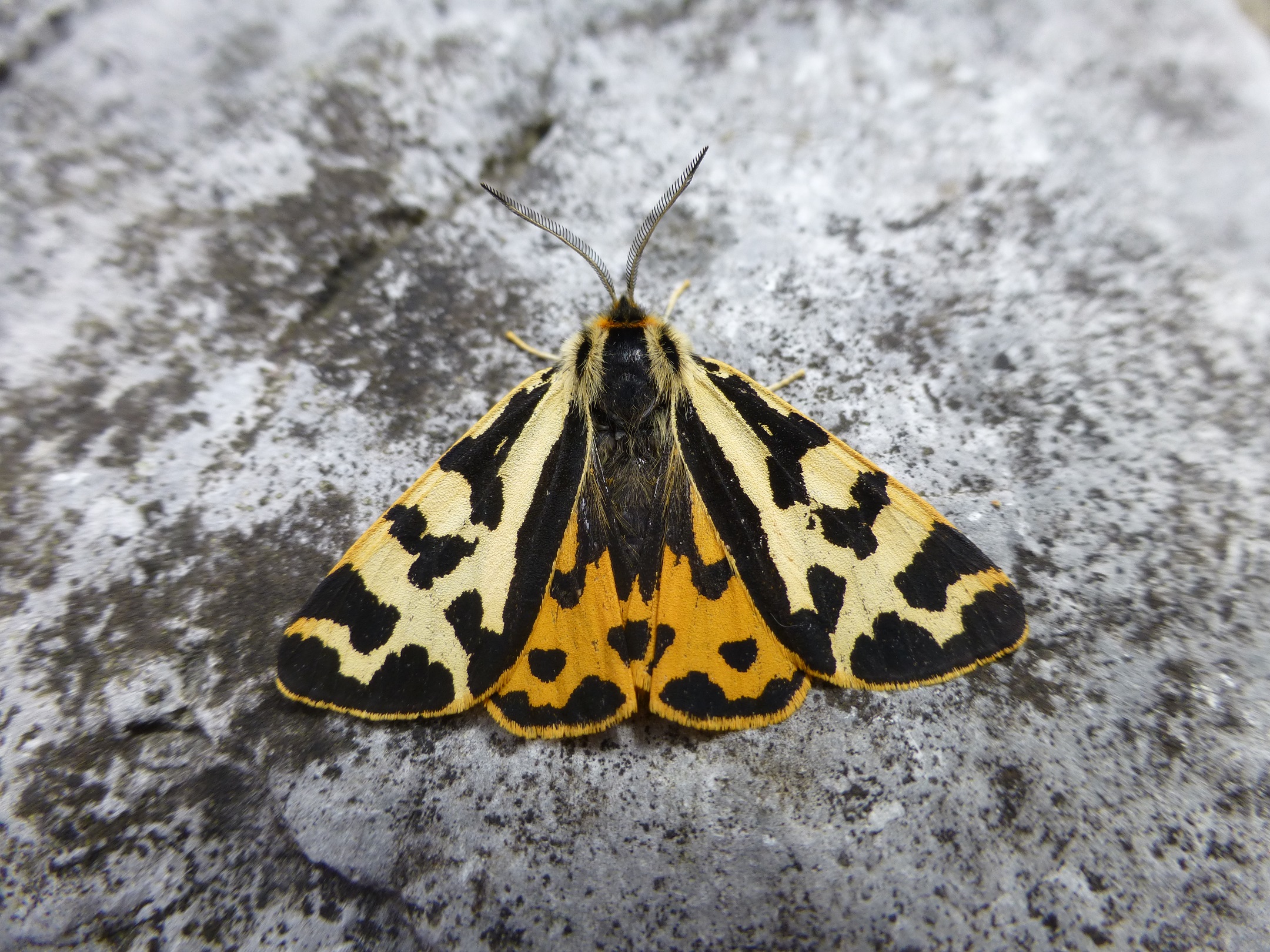 The Wood Tiger Parasemia plantaginis a dramatic day flyer that can be seen in the Burren and elsewhere in June and July.
The Wood Tiger Parasemia plantaginis a dramatic day flyer that can be seen in the Burren and elsewhere in June and July.
All photographs and text © J. Harding
References
Manley, C. (2015) British Moths Second Edition. Bloomsbury, London.
National Biodiversity Data Centre, Ireland, Heath Rivulet (Perizoma minorata), accessed 21 January 2023, <https://maps.biodiversityireland.ie/Species/83917>
National Biodiversity Data Centre, Ireland, Tissue (Triphosa dubitata), accessed 21 January 2023, https://maps.biodiversityireland.ie/Species/78748
O Connor, Á. and Nelson, B. (2022) Burren Invertebrate Conference, 9-11 August 2022, Conference Report. National Parks and Wildlife Service, DHLGH, Dublin.
Waring et al. (2004) Field Guide to the Moths of Great Britain and Ireland. British Wildlife Publishing, Hampshire.
BUTTERFLY CONSERVATION IRELAND ANNUAL REPORT 2022
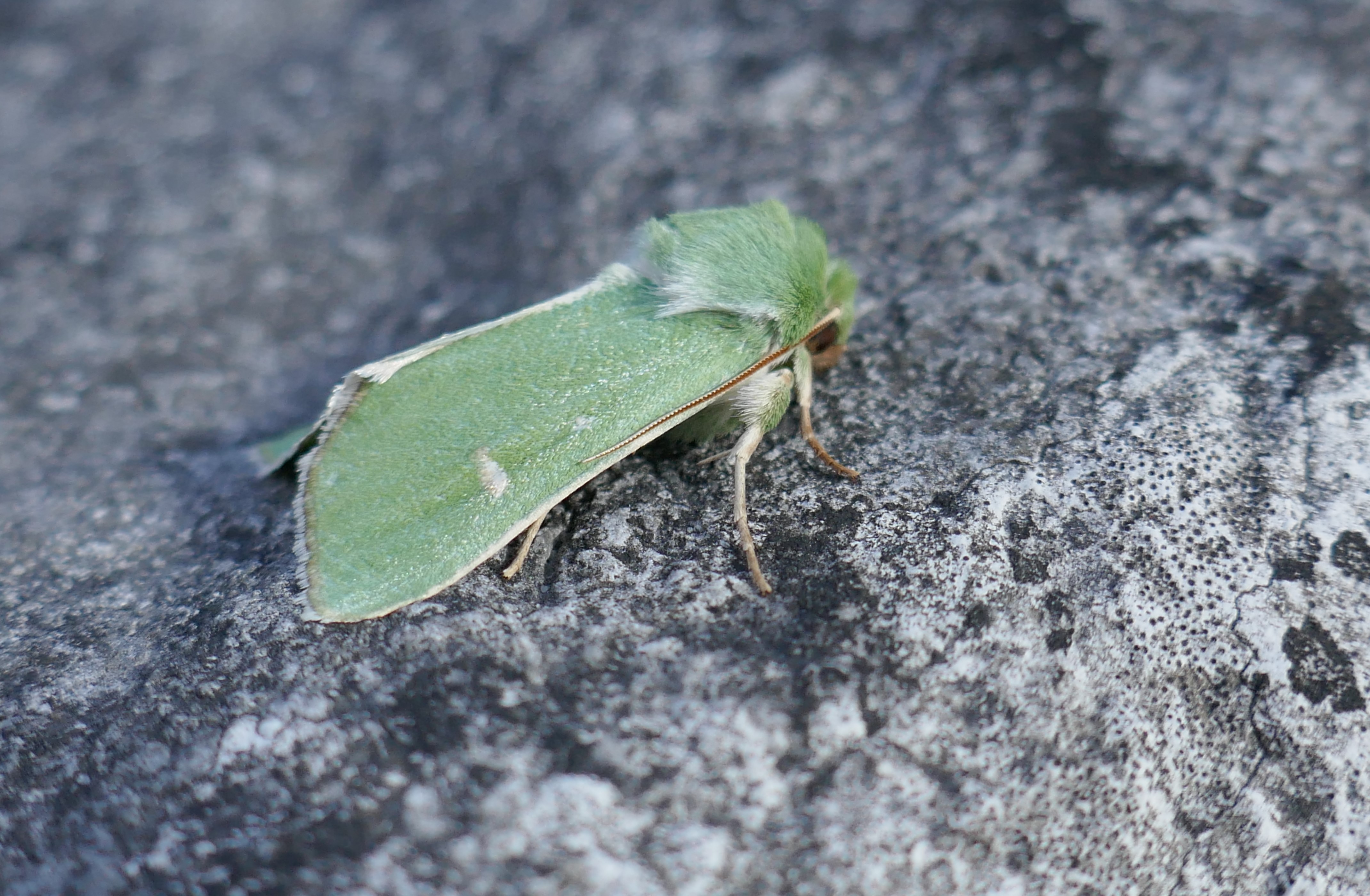 The Burren Green is found nowhere else in Britain or Ireland.
The Burren Green is found nowhere else in Britain or Ireland.
BUTTERFLY CONSERVATION IRELAND is a company limited by guarantee. Registered in Ireland No. 451571.
BUTTERFLY CONSERVATION IRELAND is a charity. Registered Charity no.: 20069131.
CONTACT DETAILS:
By email: conservation.butterfly@gmail.com
By Post:
Butterfly Conservation Ireland,
Butterfly House,
Pagestown,
Maynooth,
County Kildare.
By phone: 01-6106693
Website: https://butterflyconservation.ie/wp/
Facebook: https://www.facebook.com/ButterflyConservationIreland

